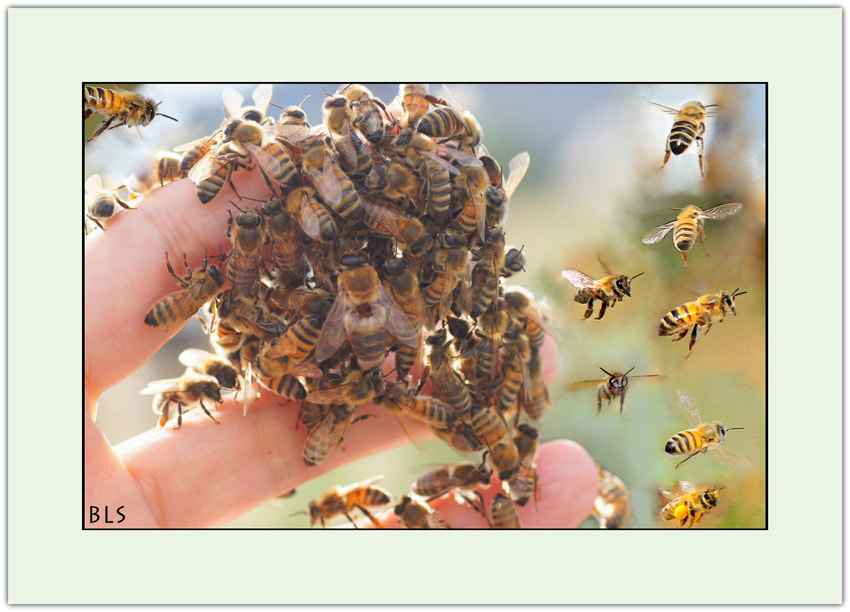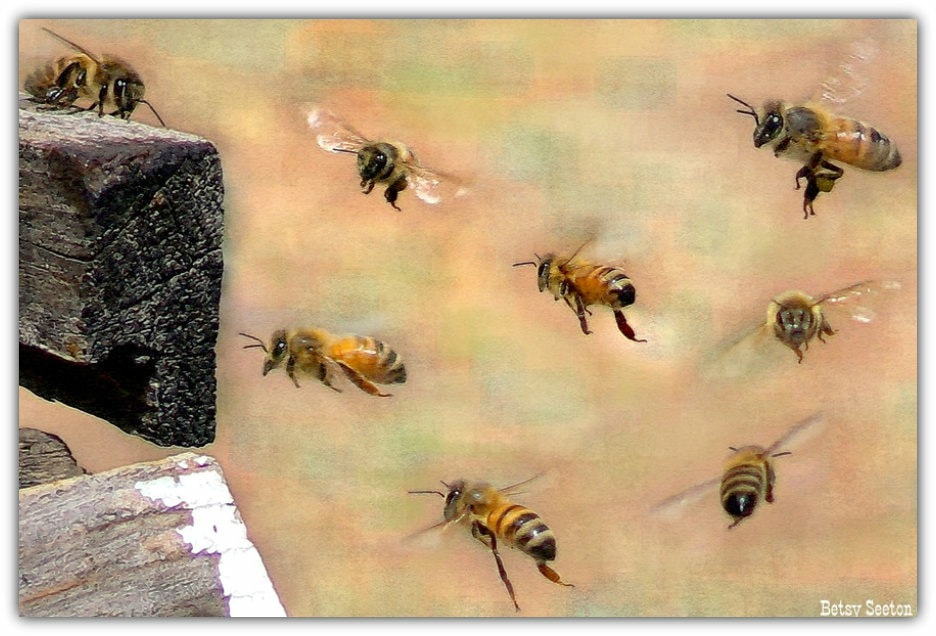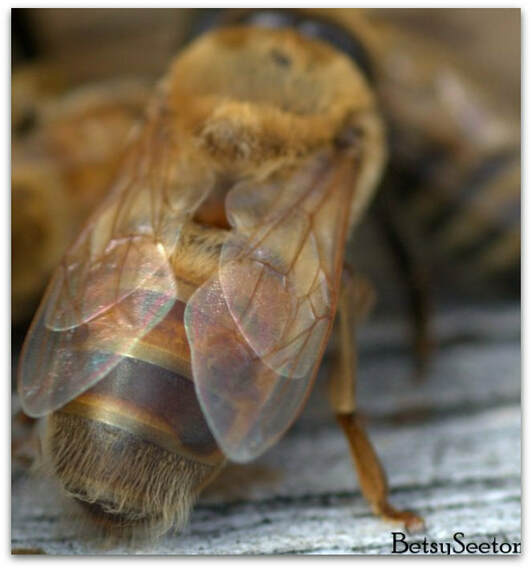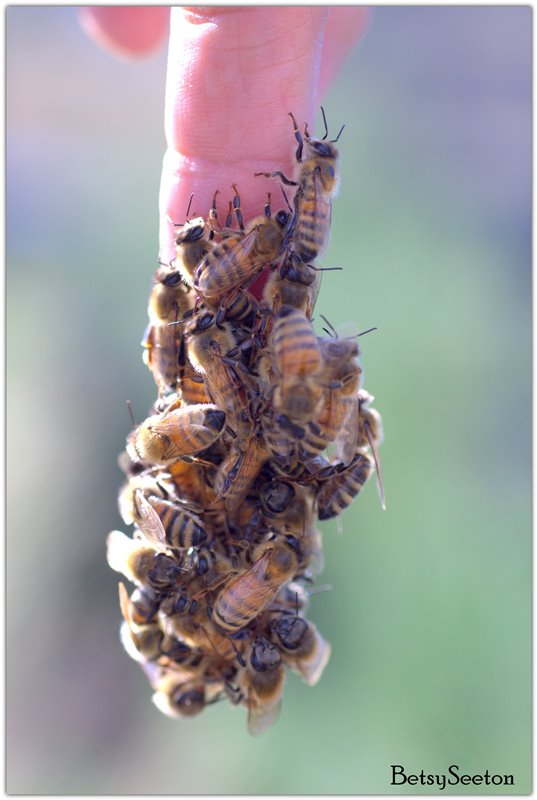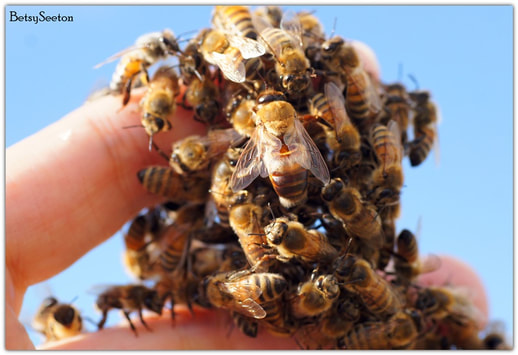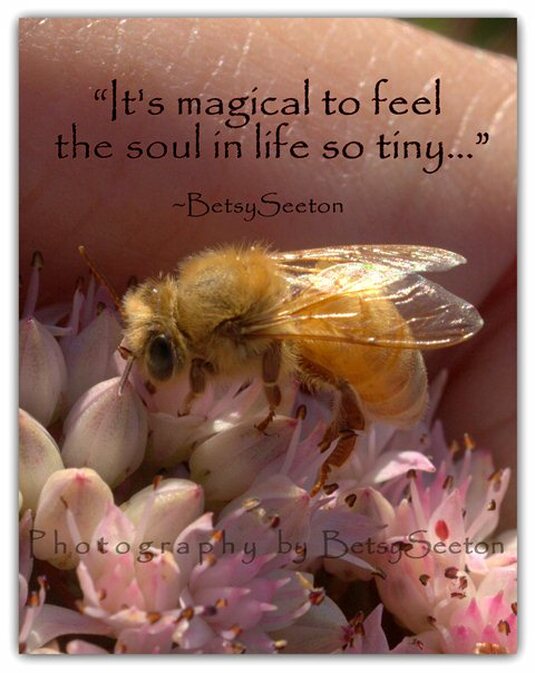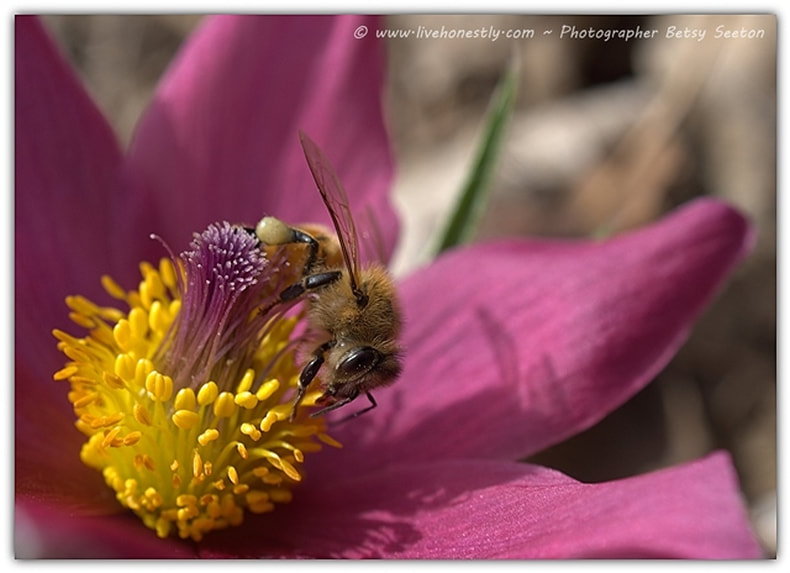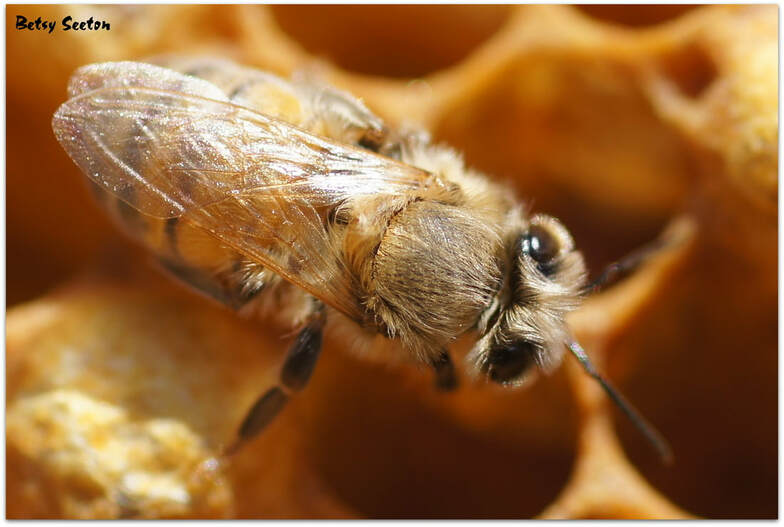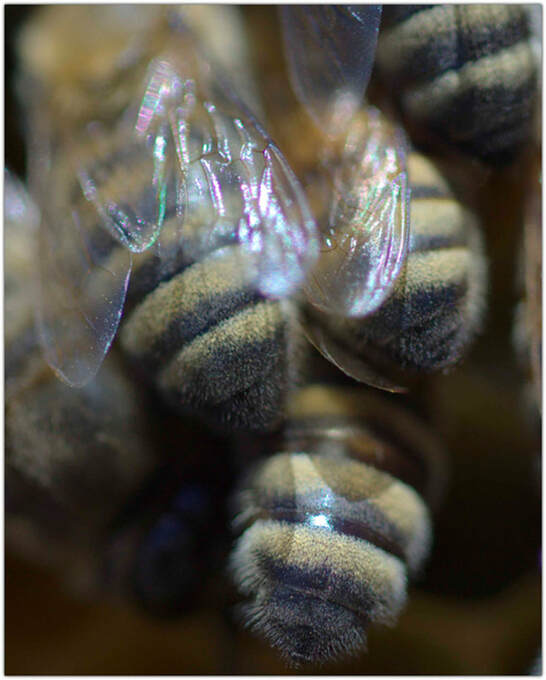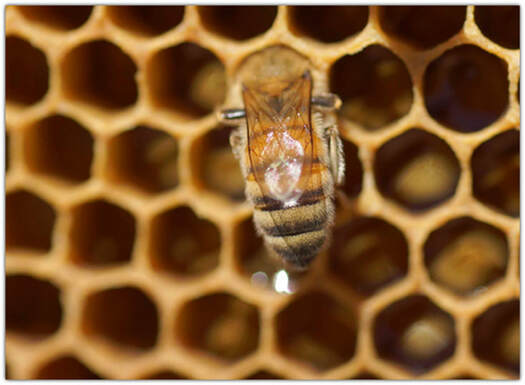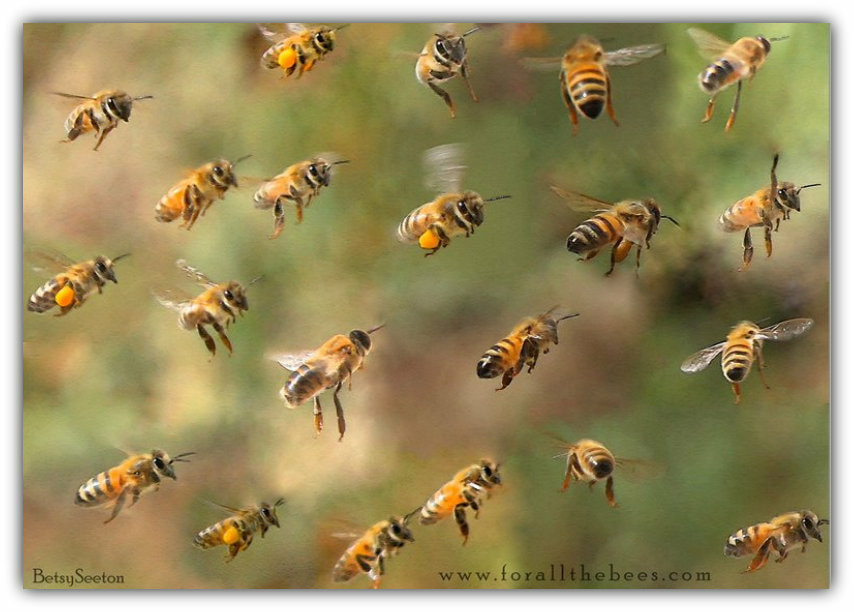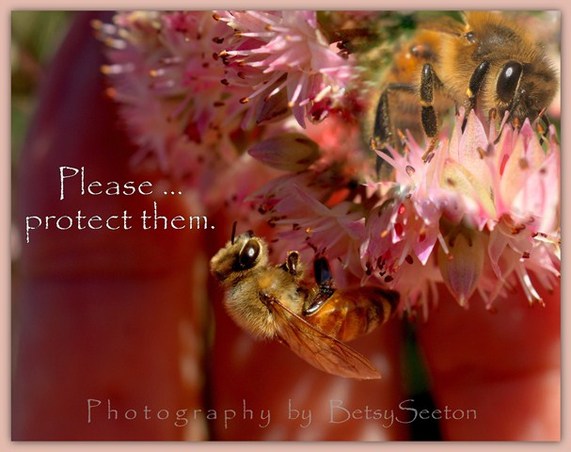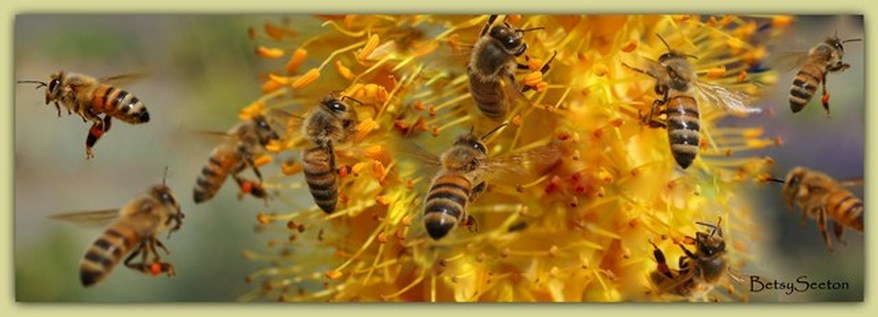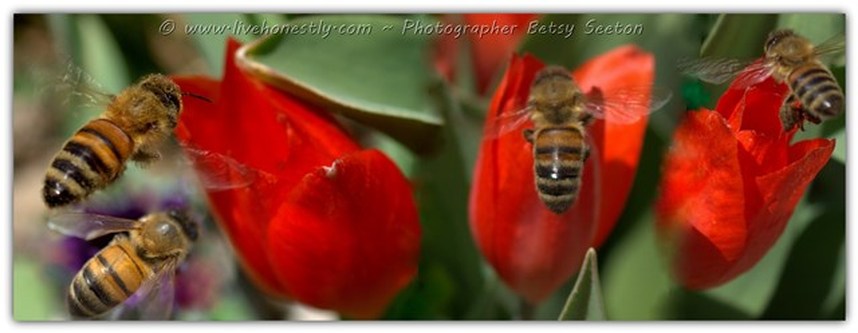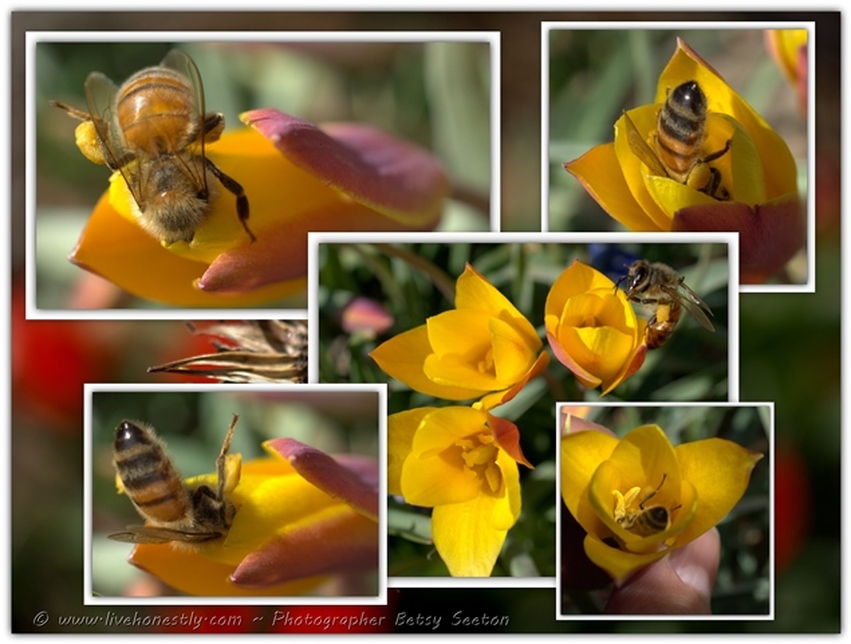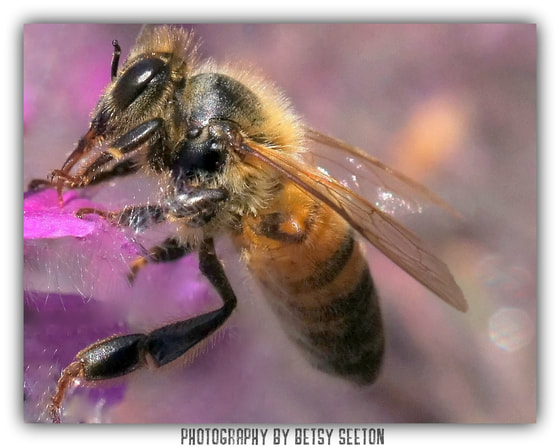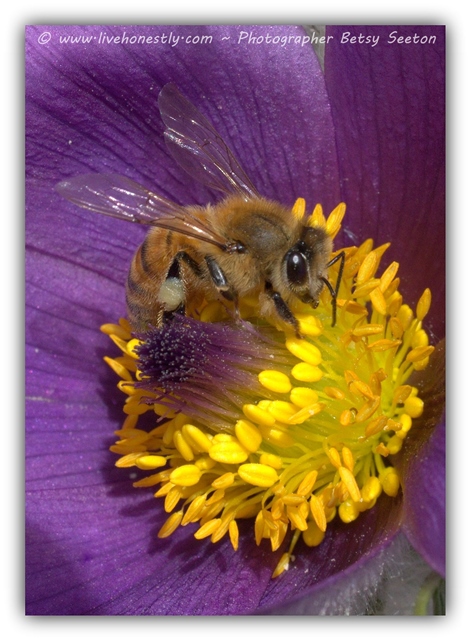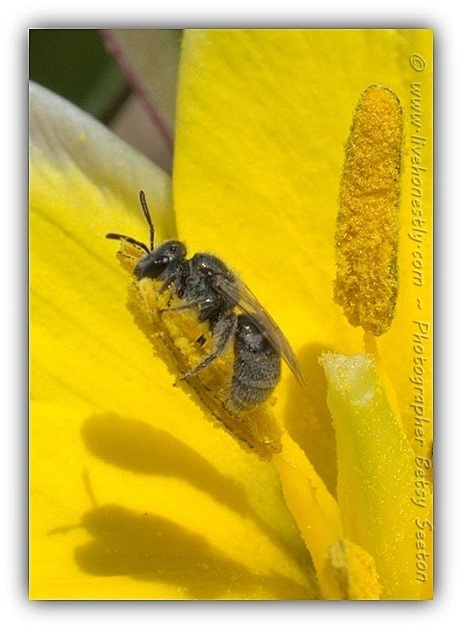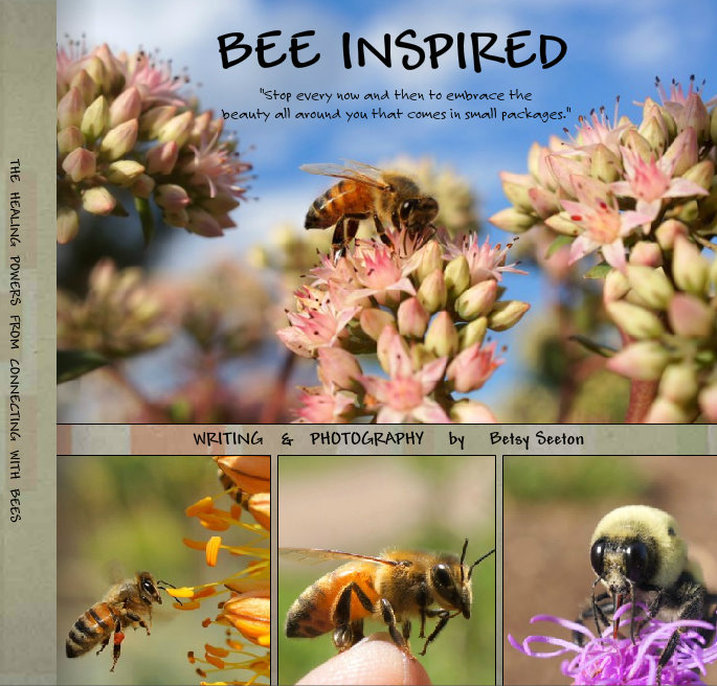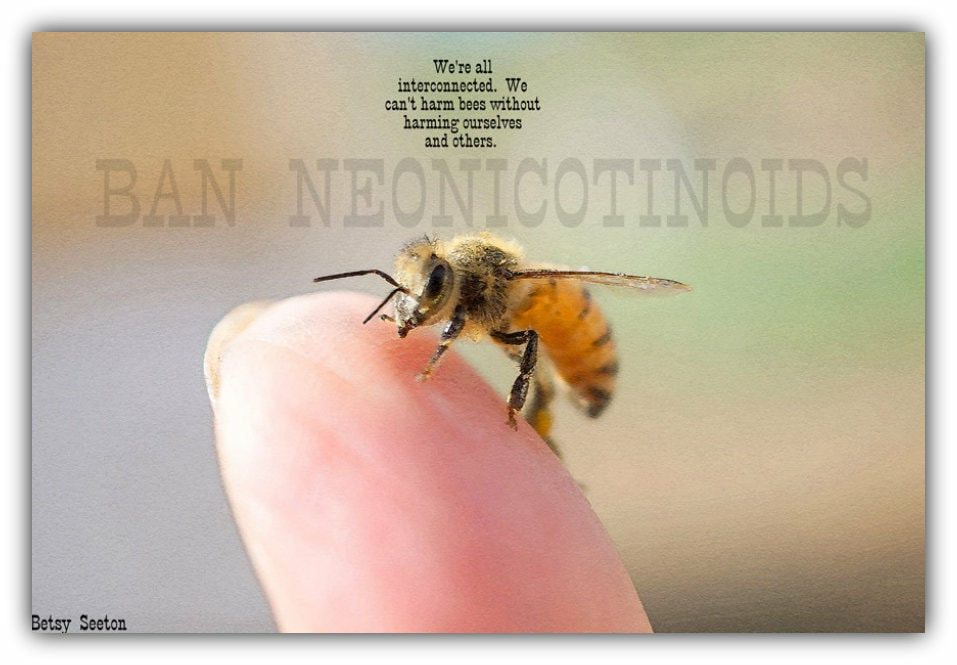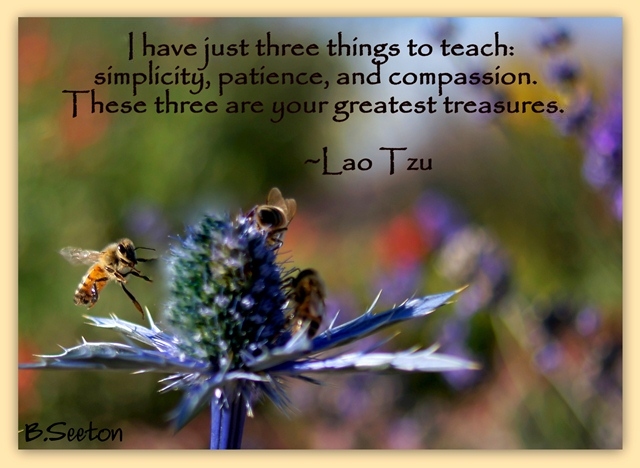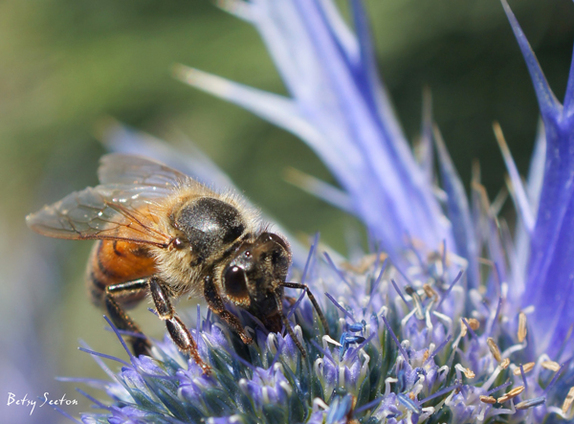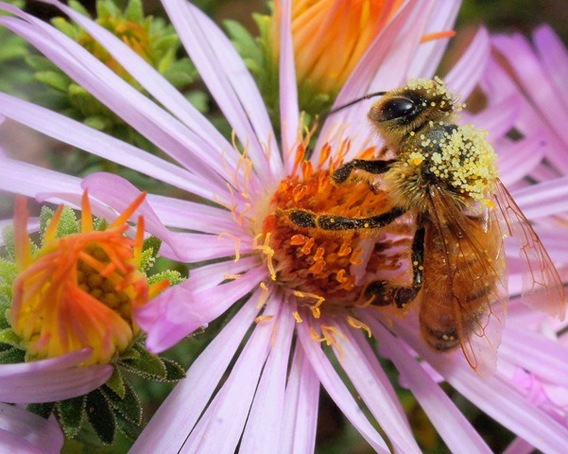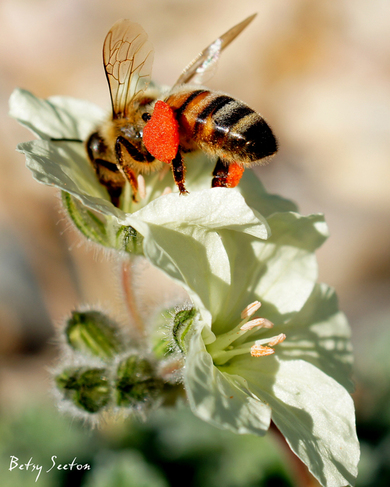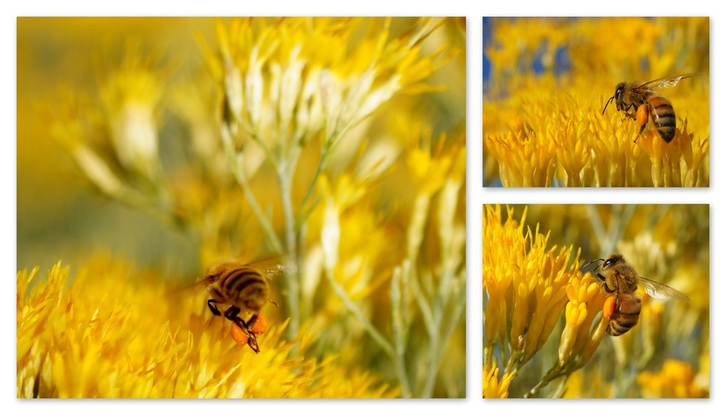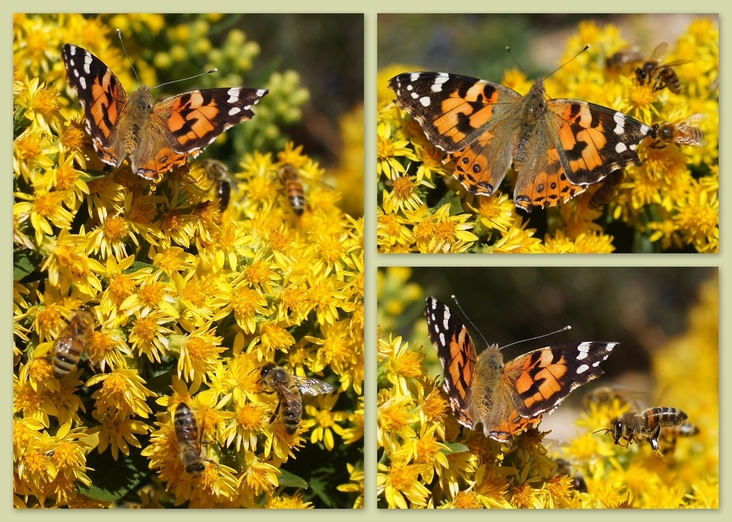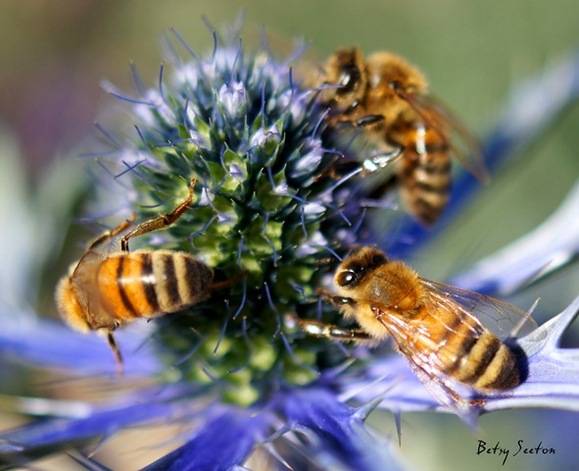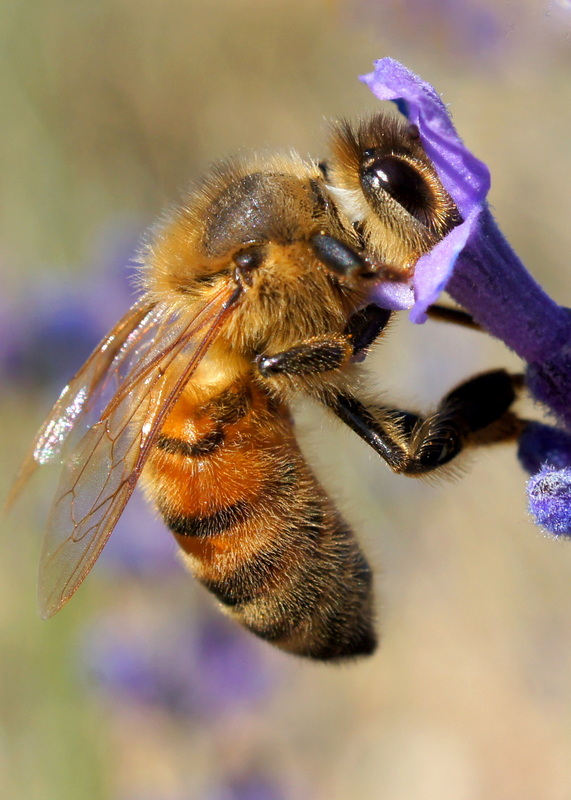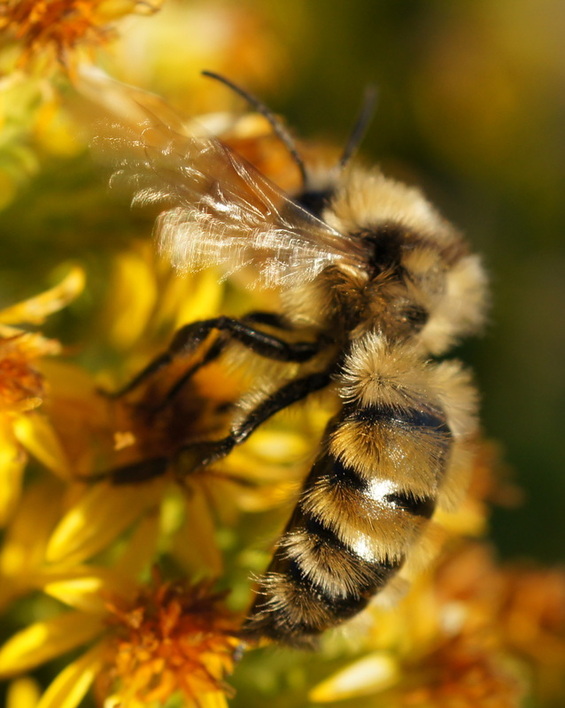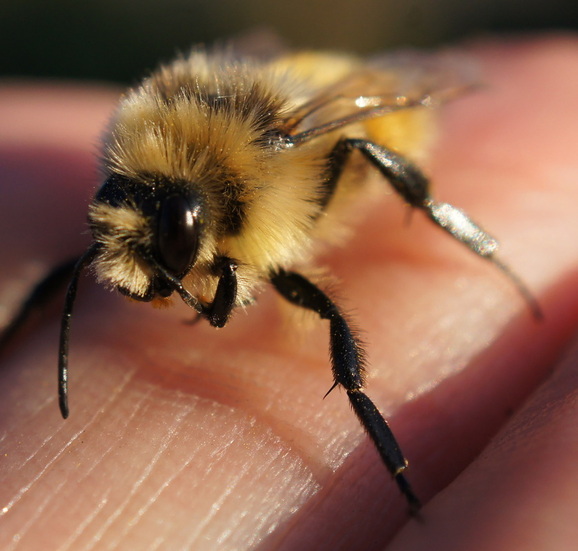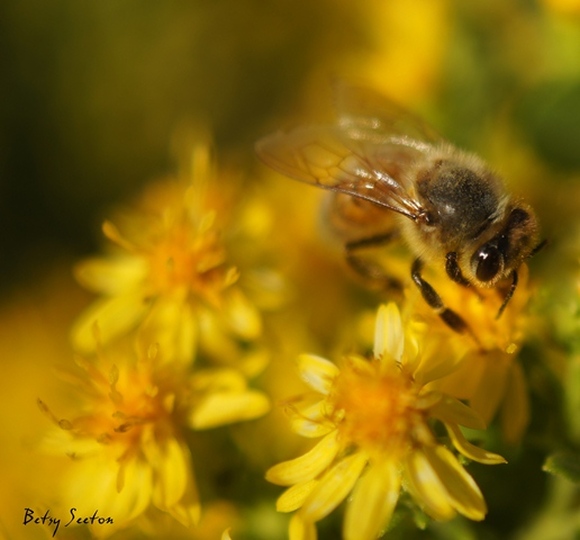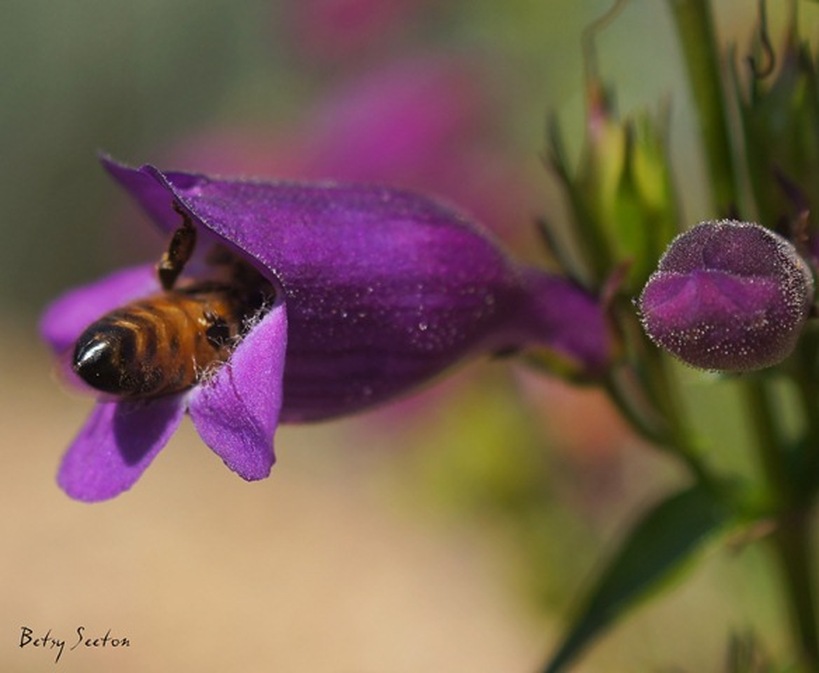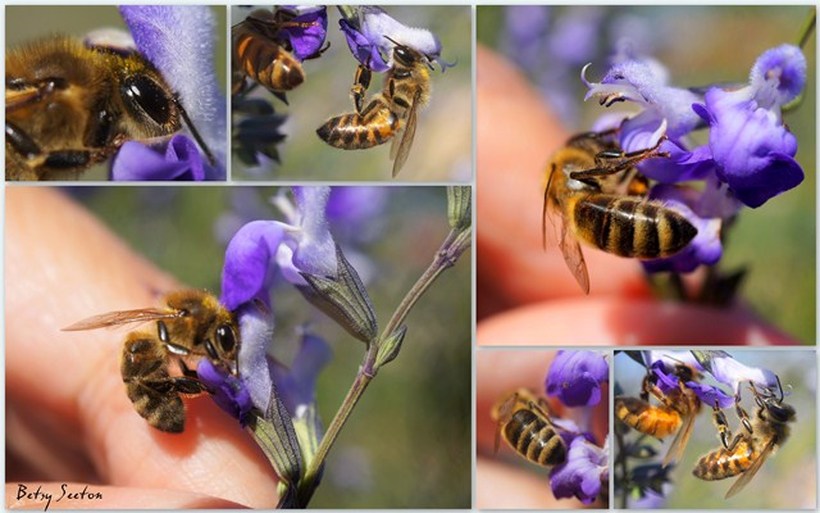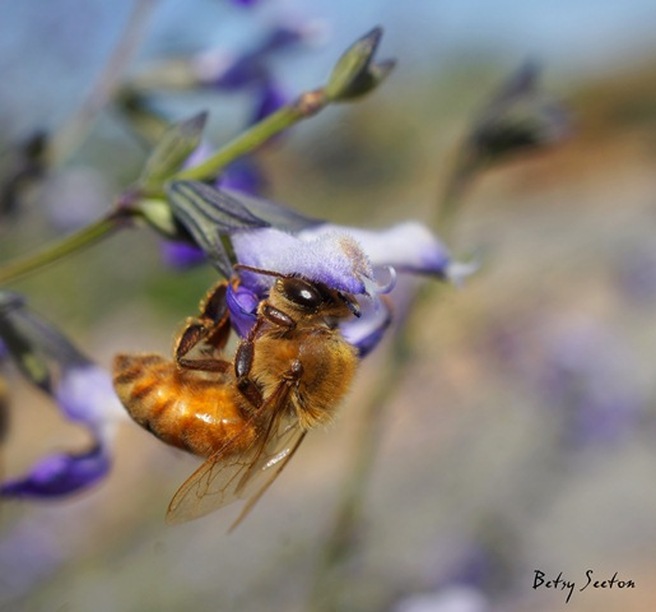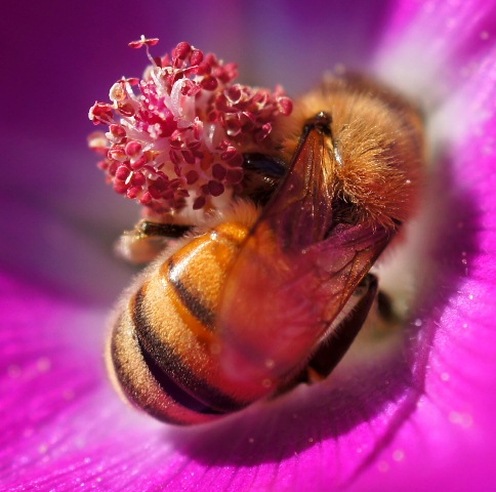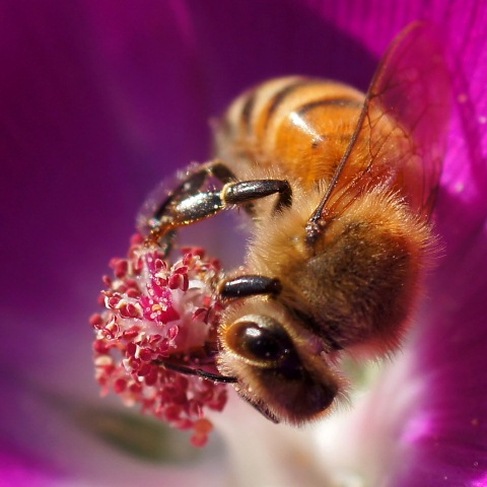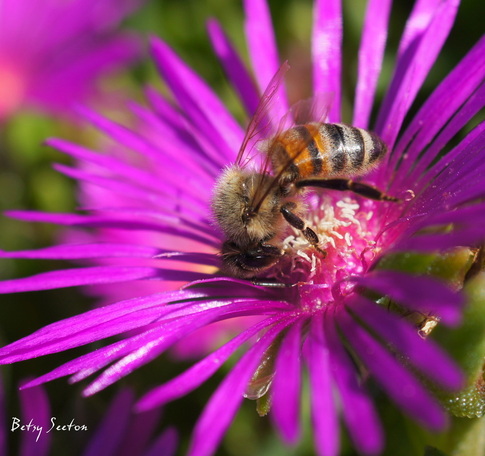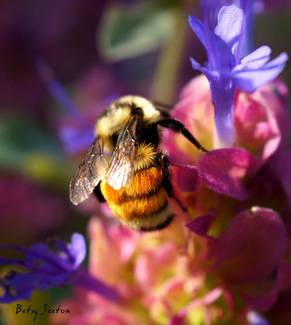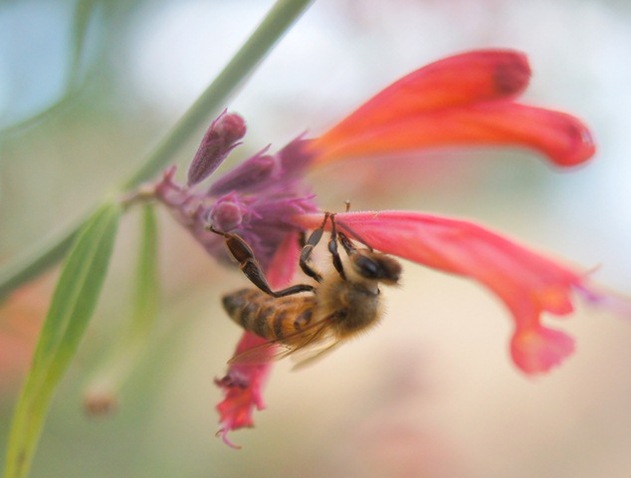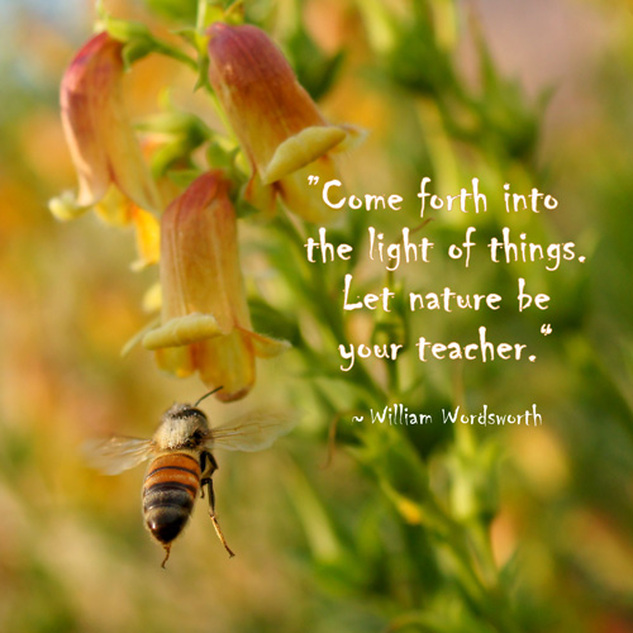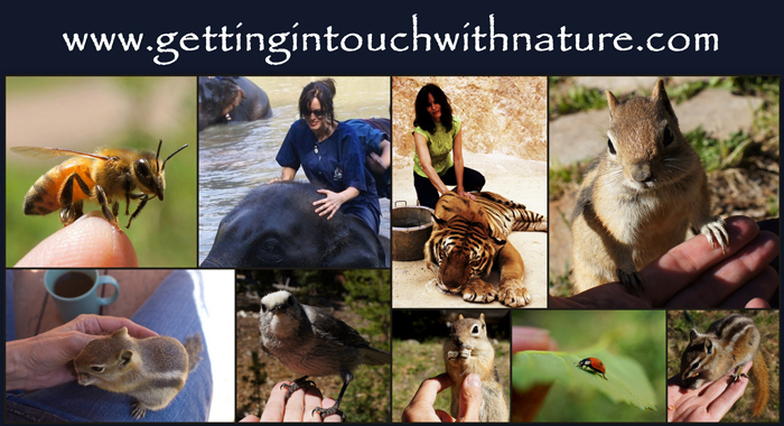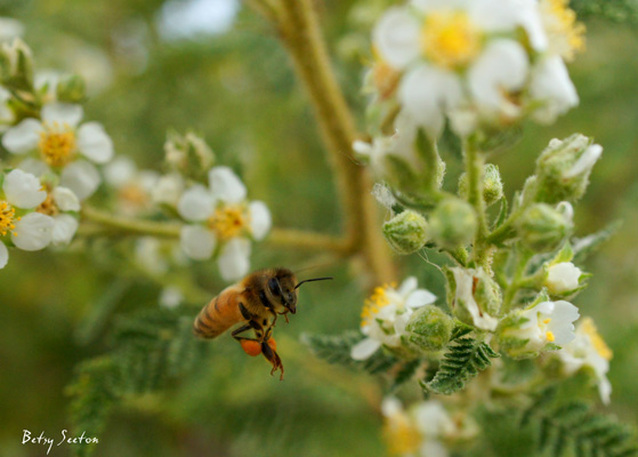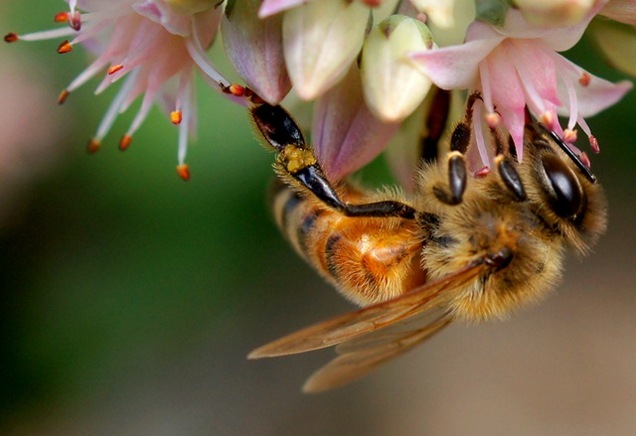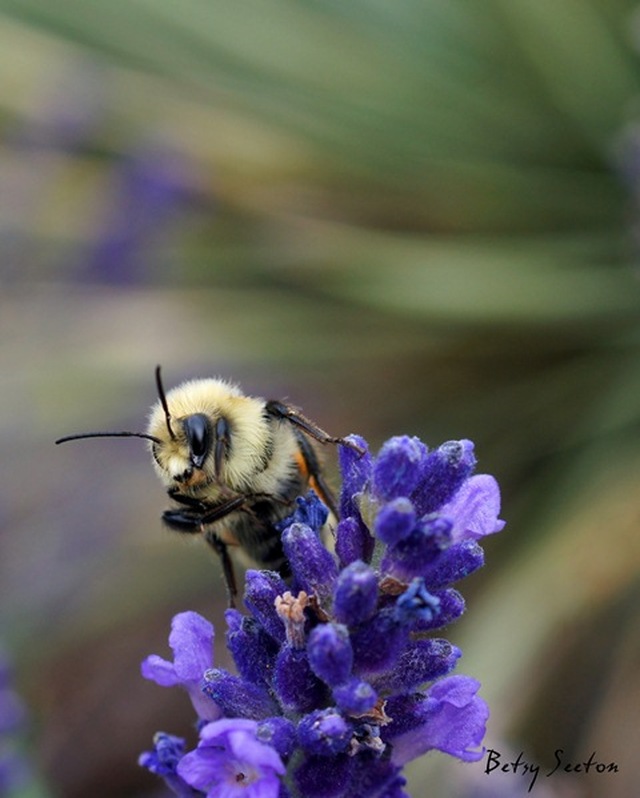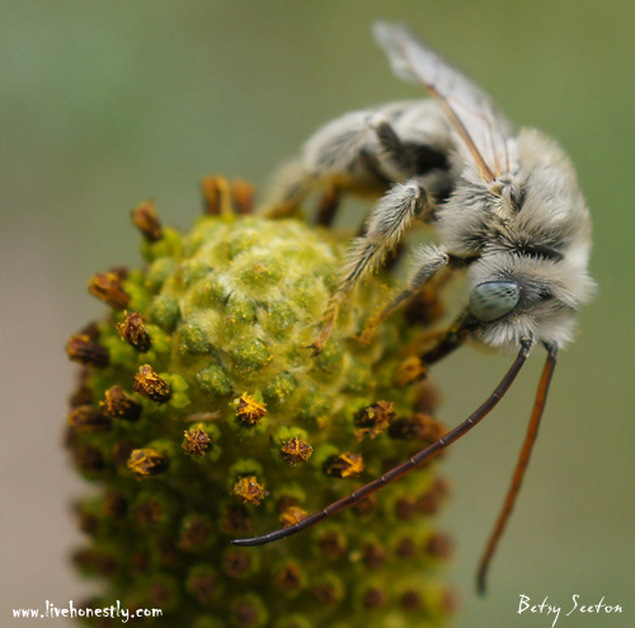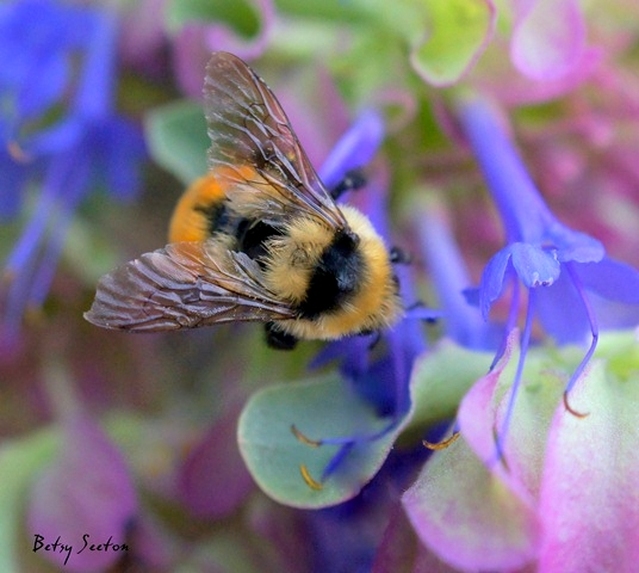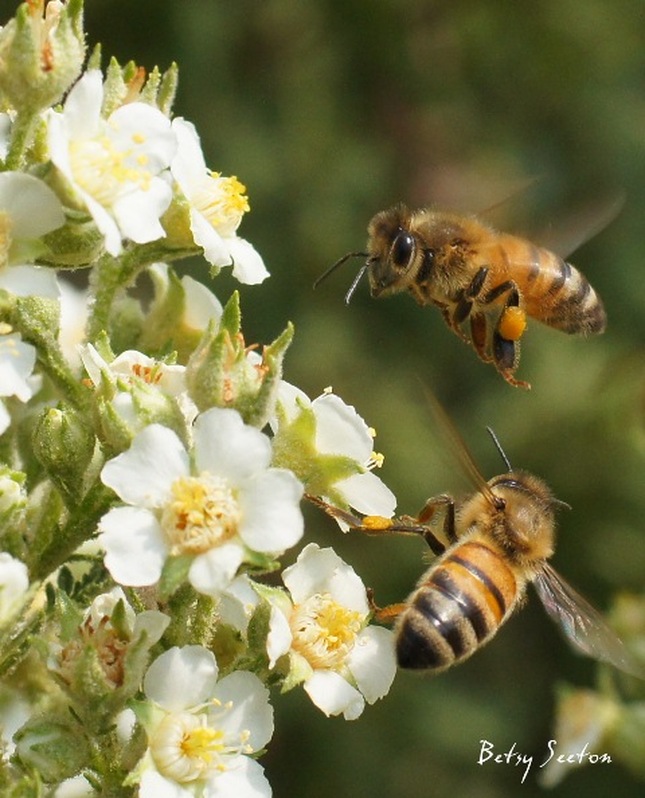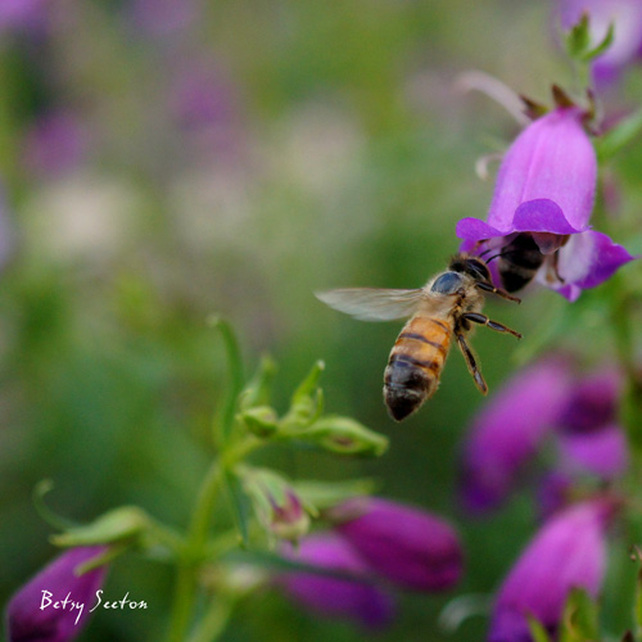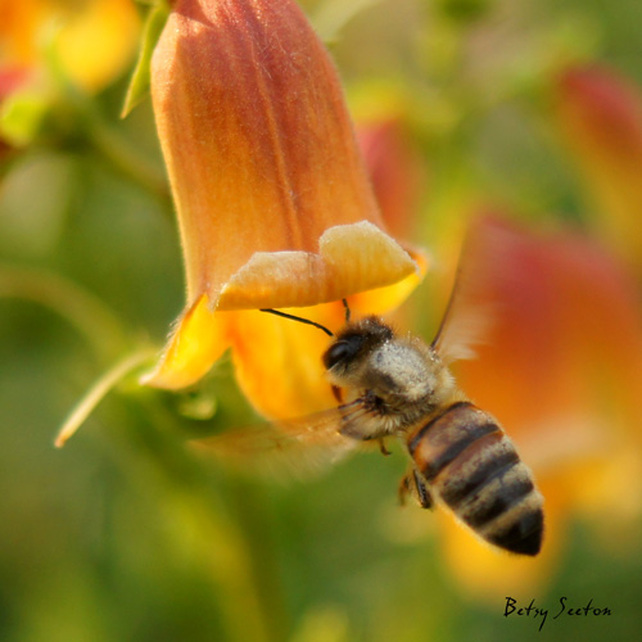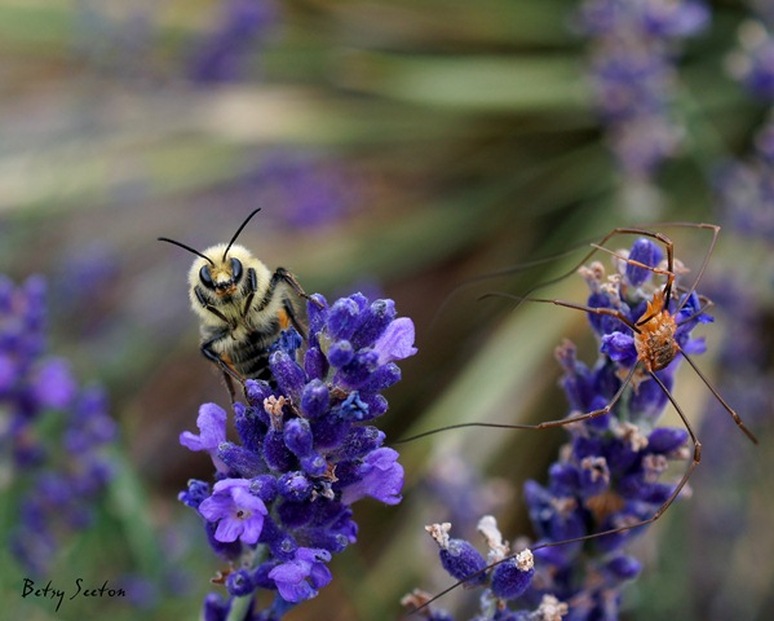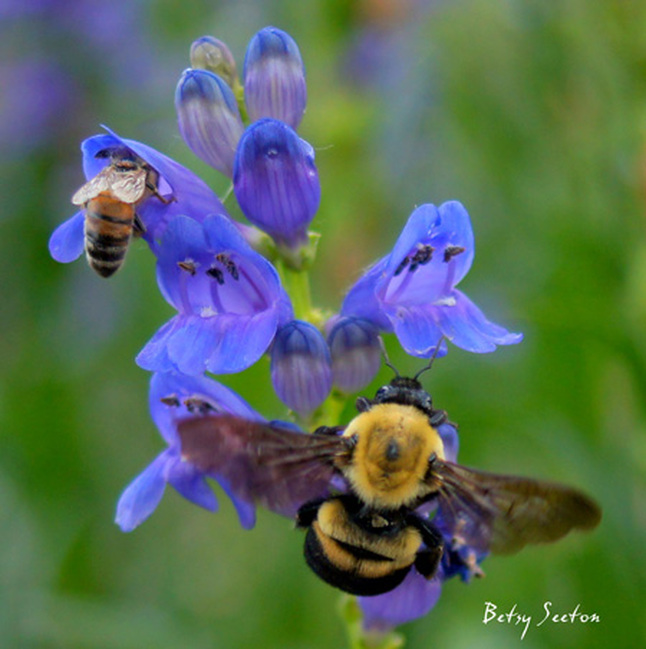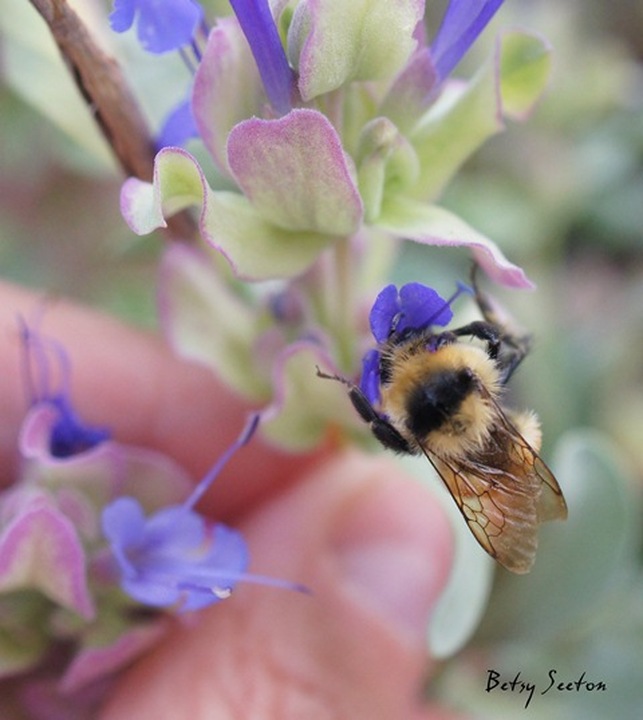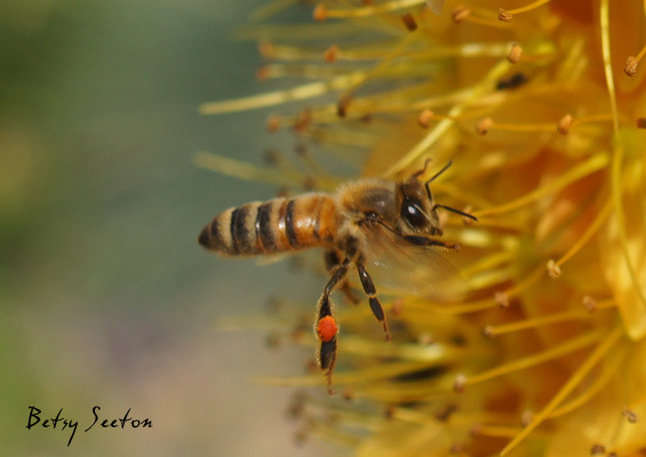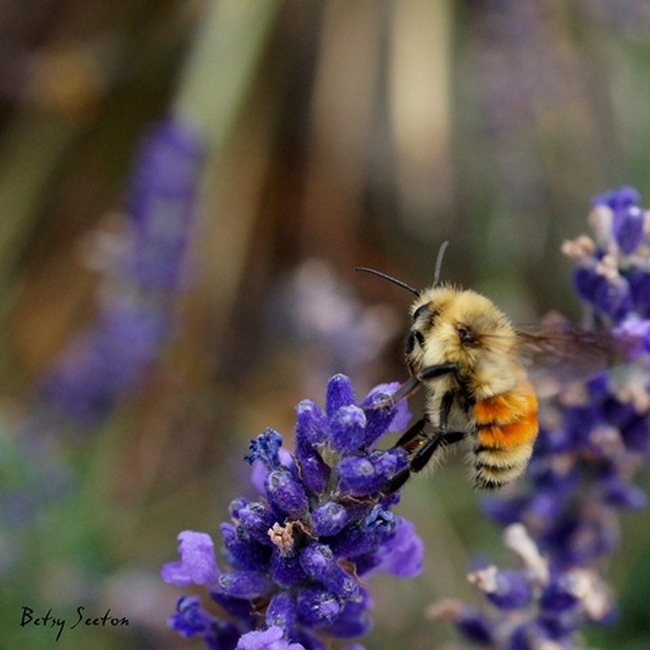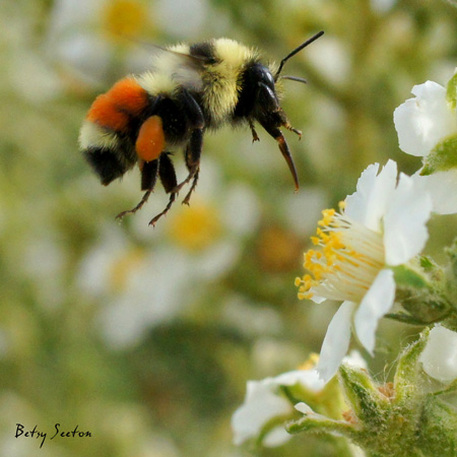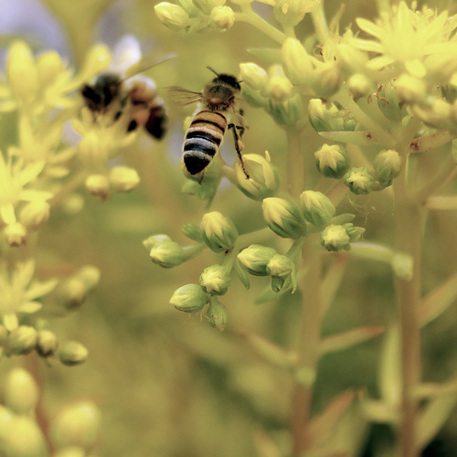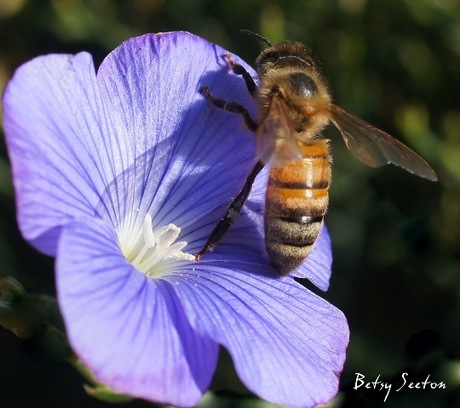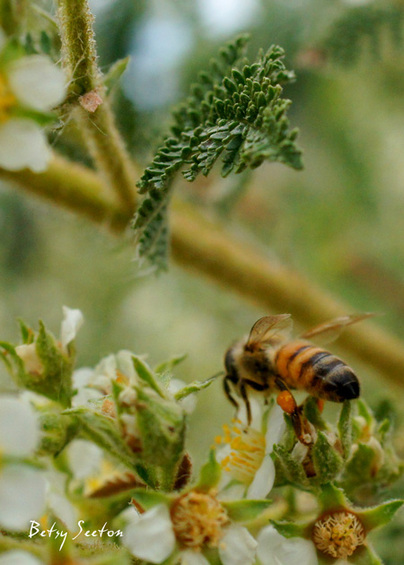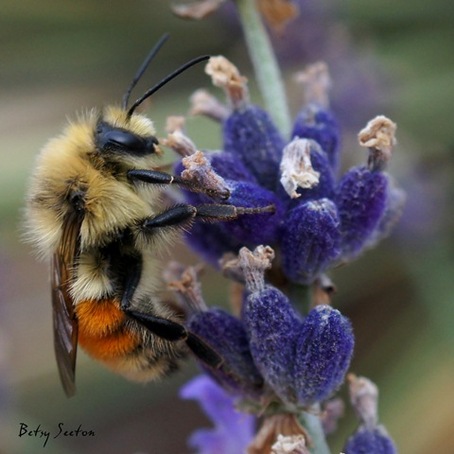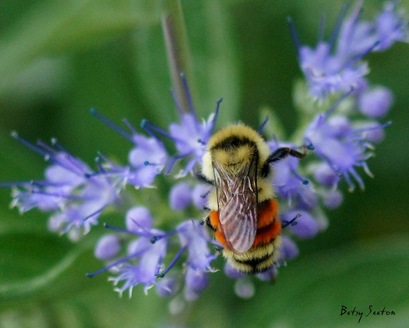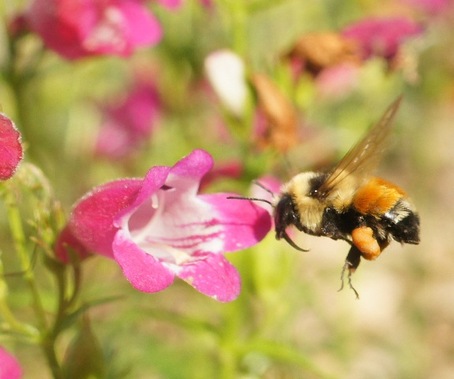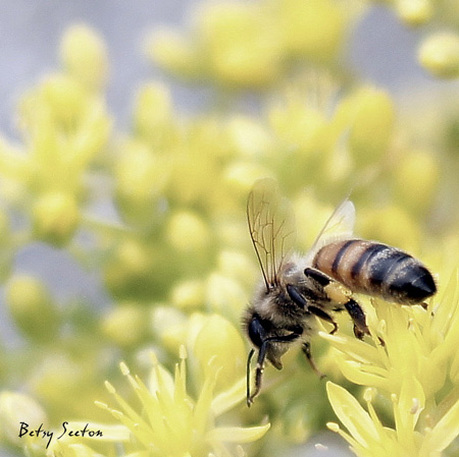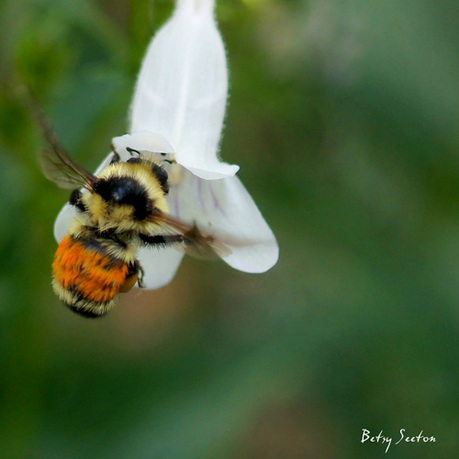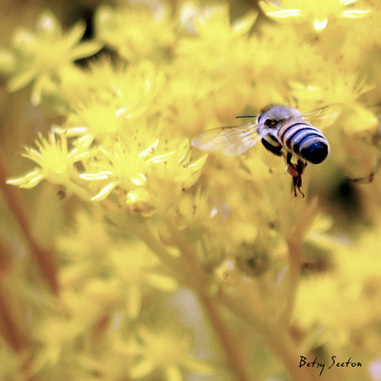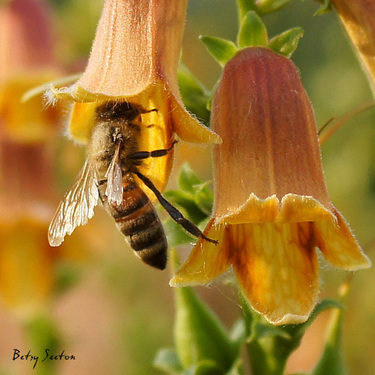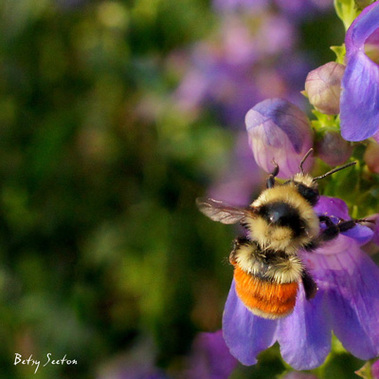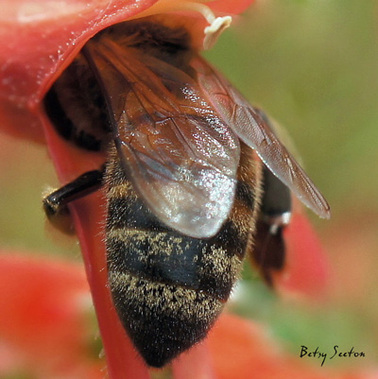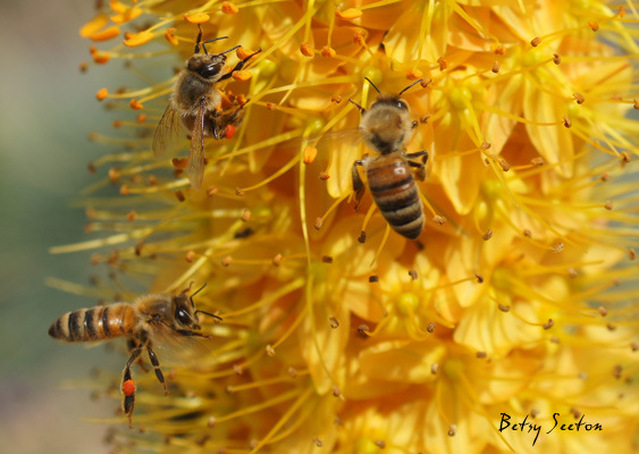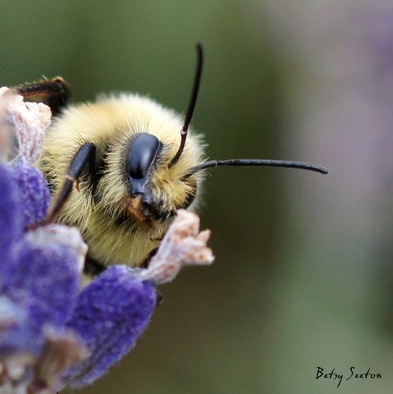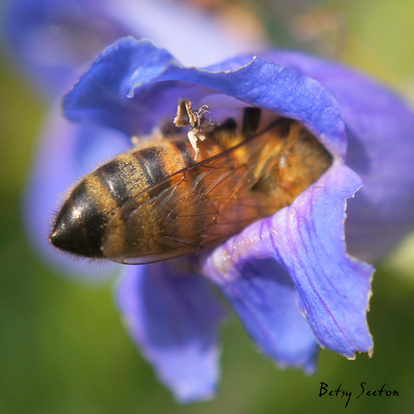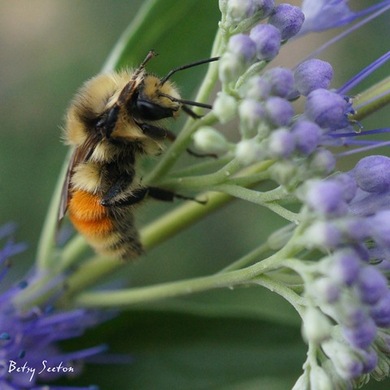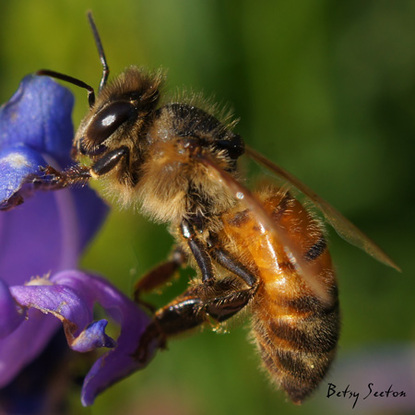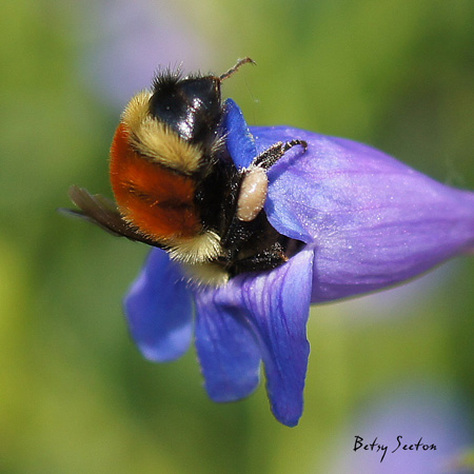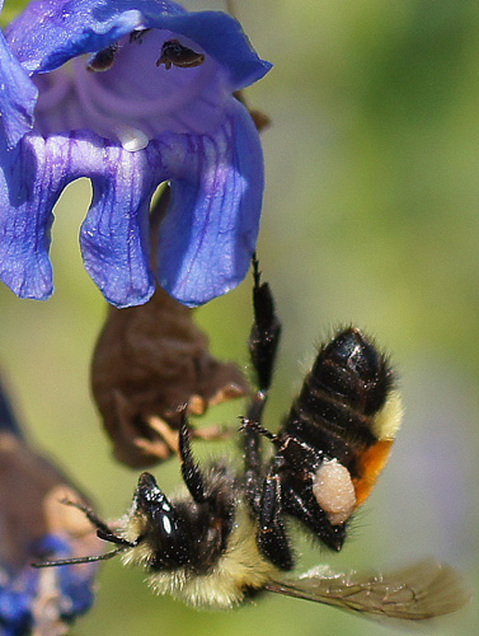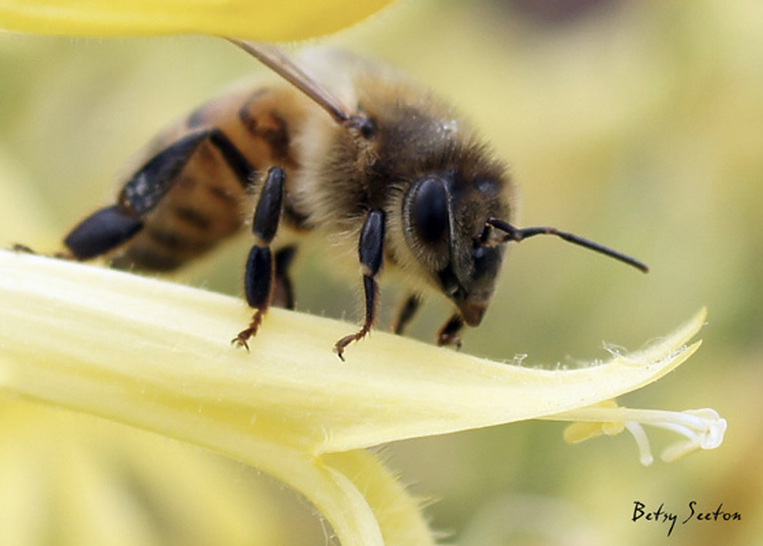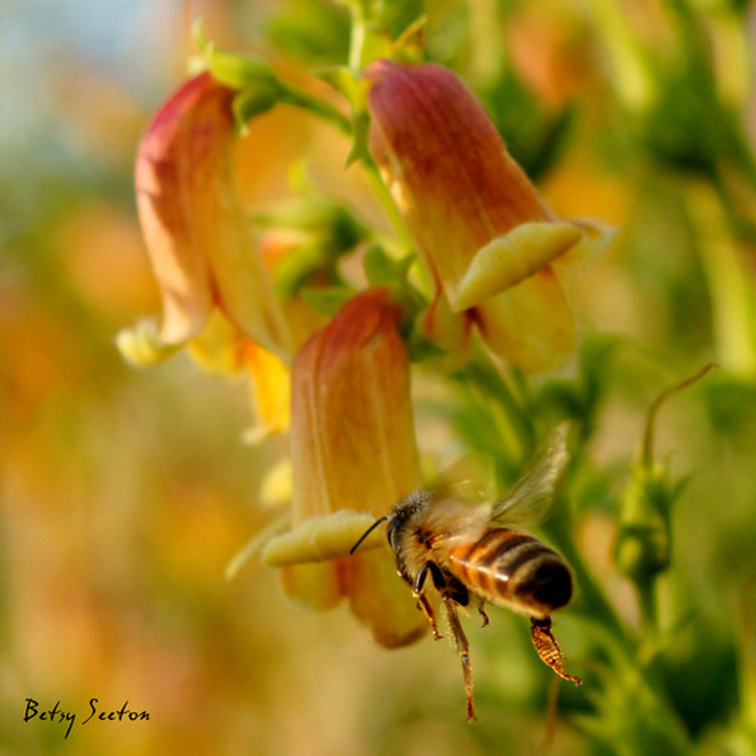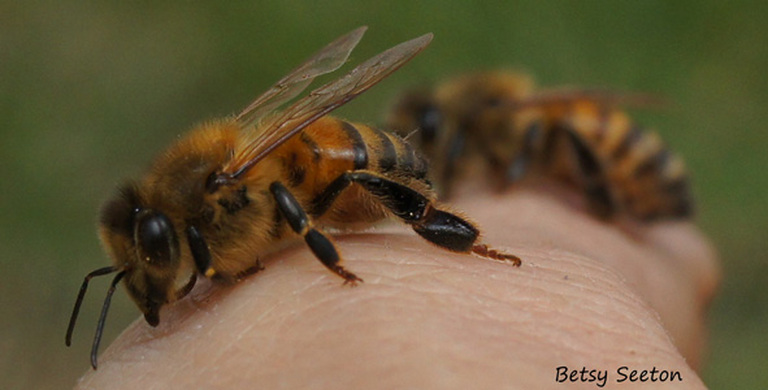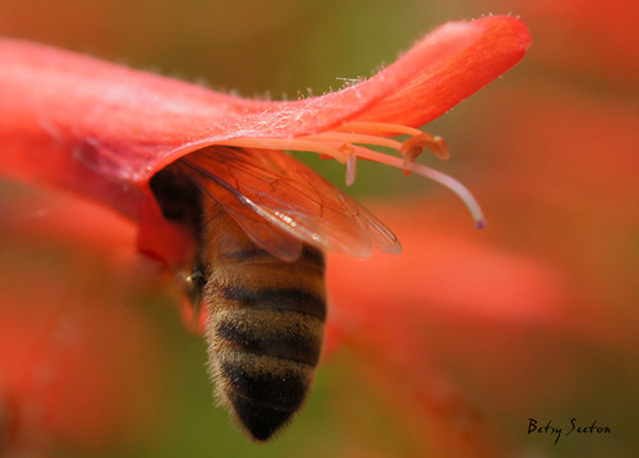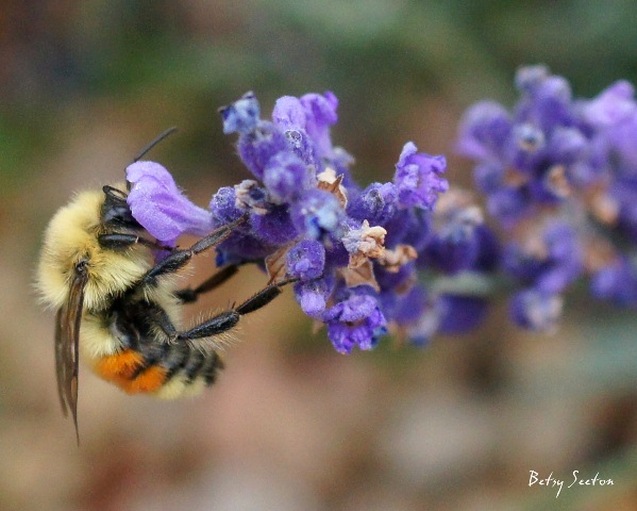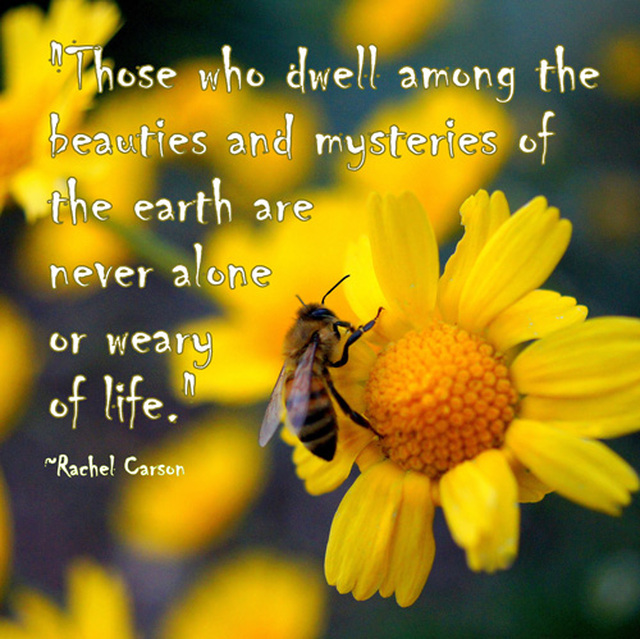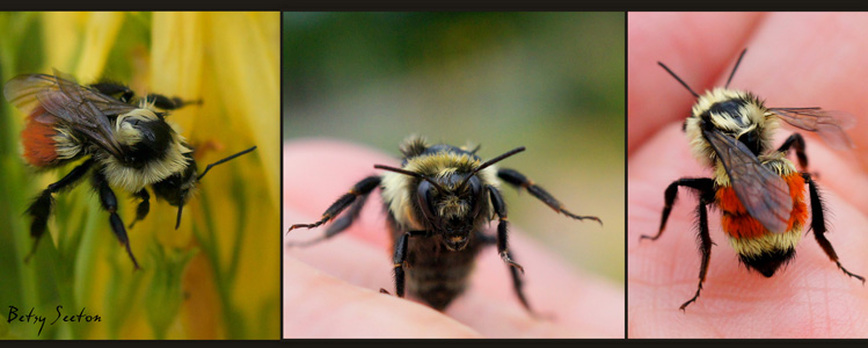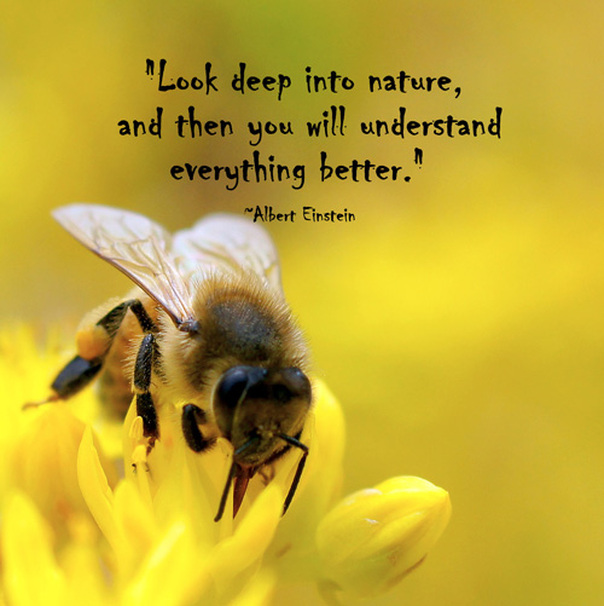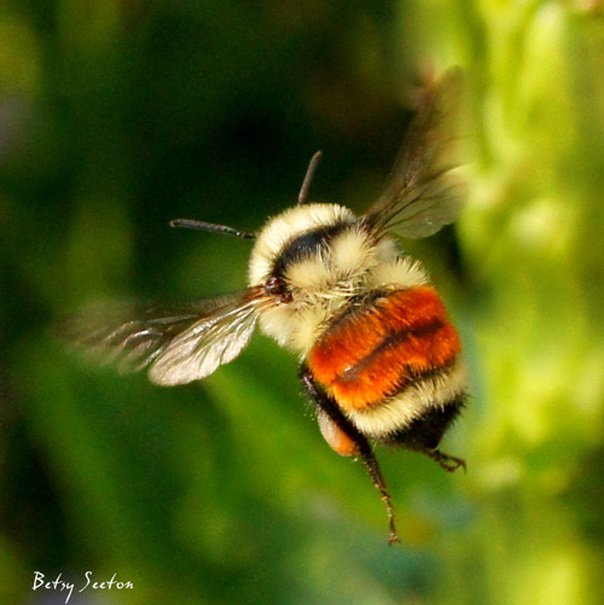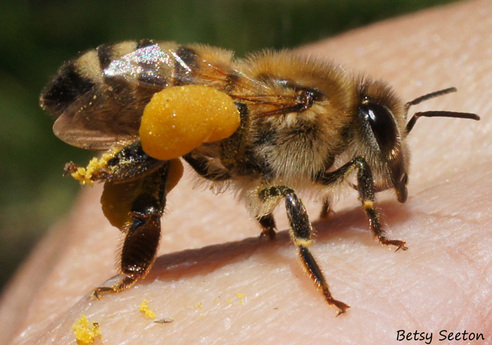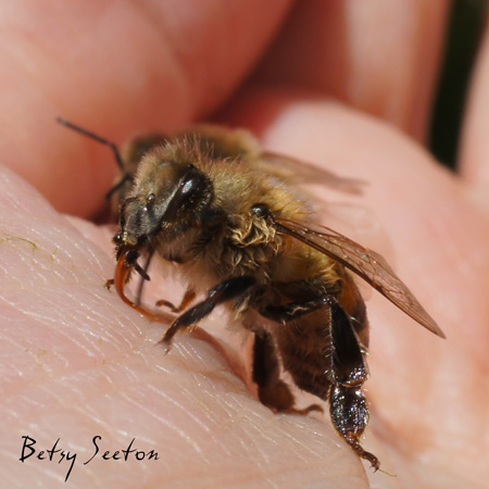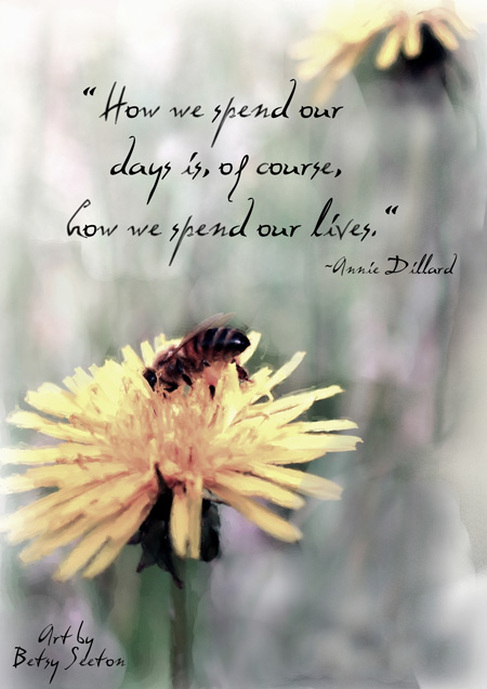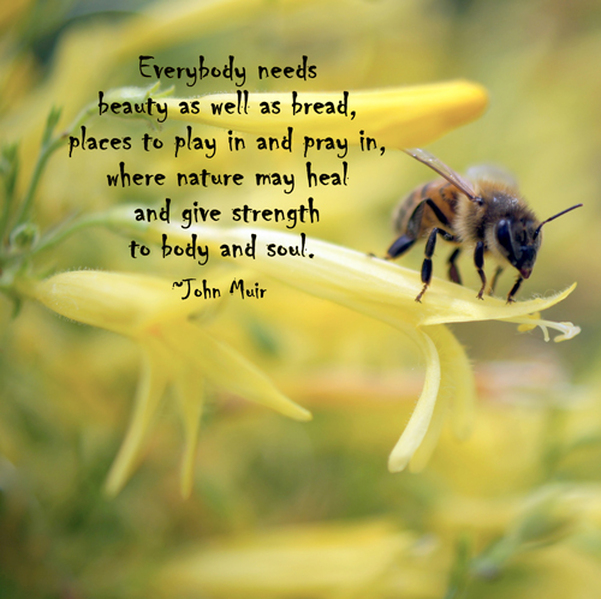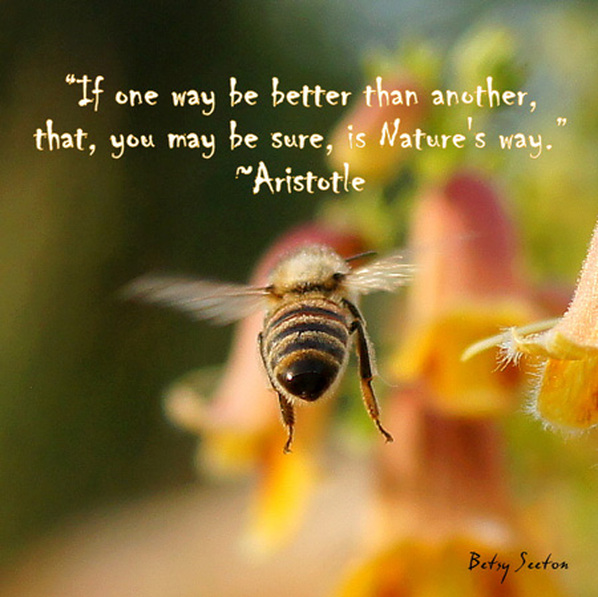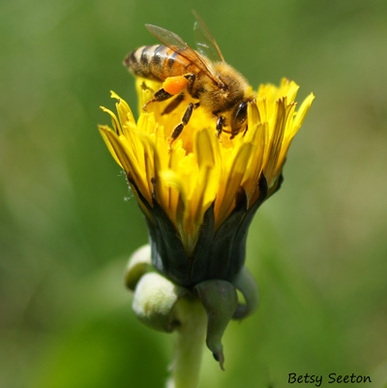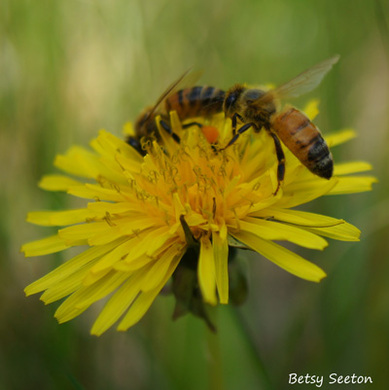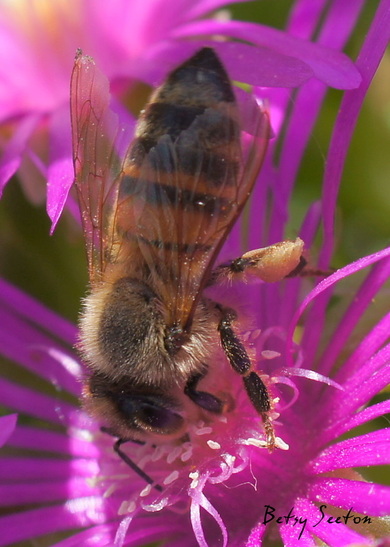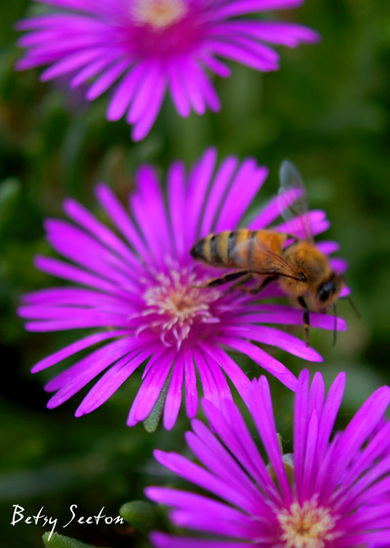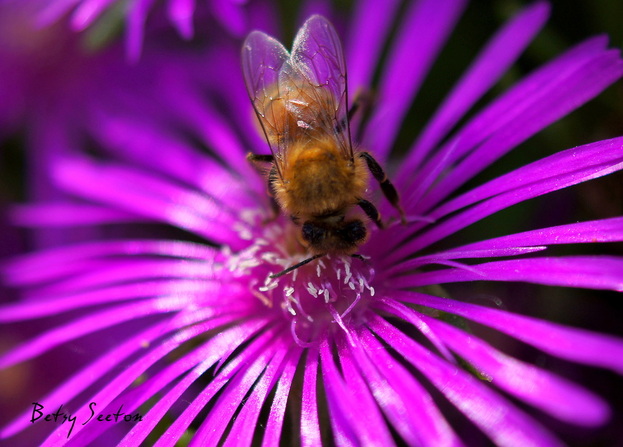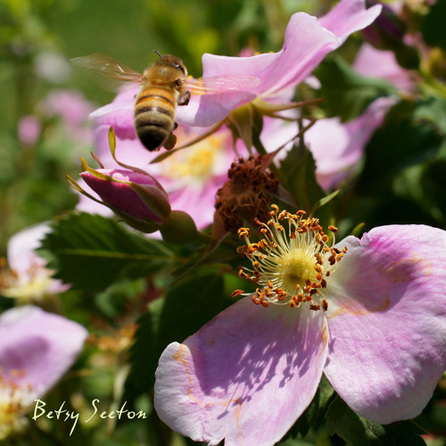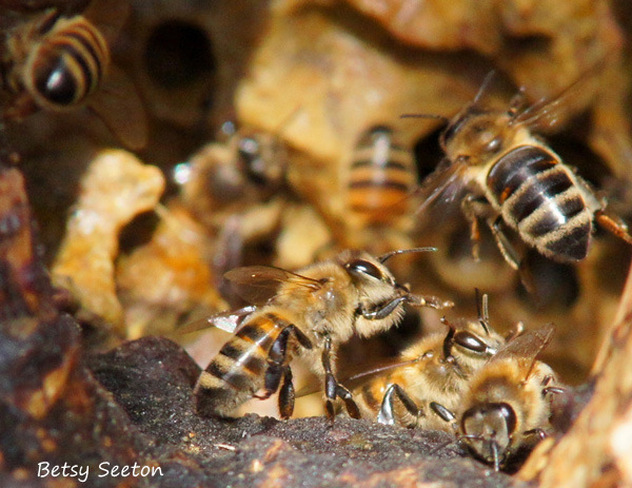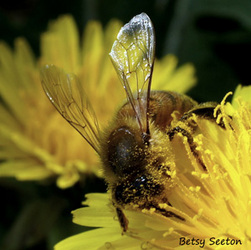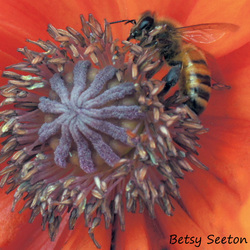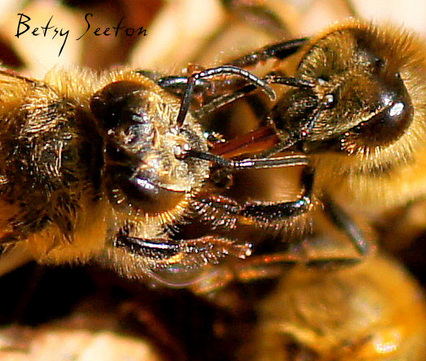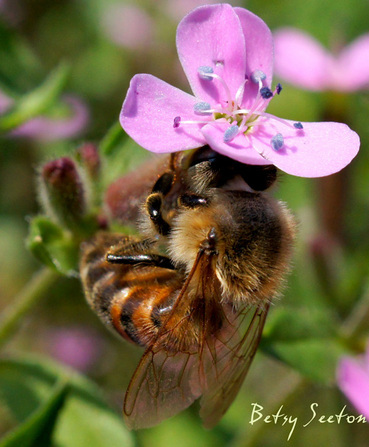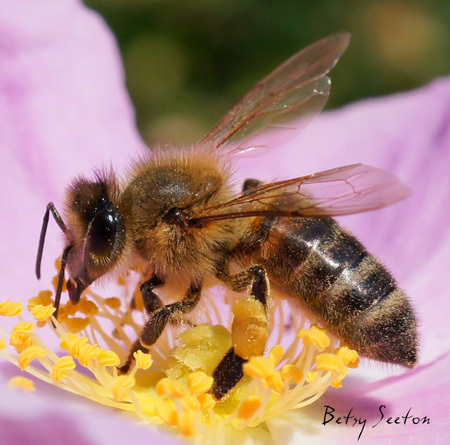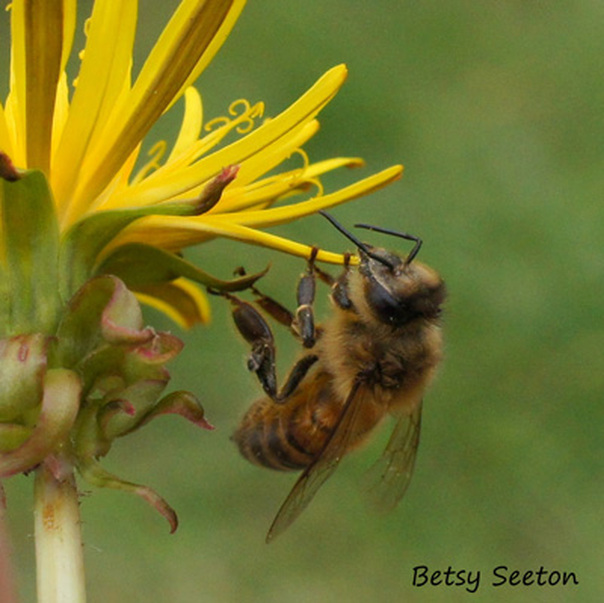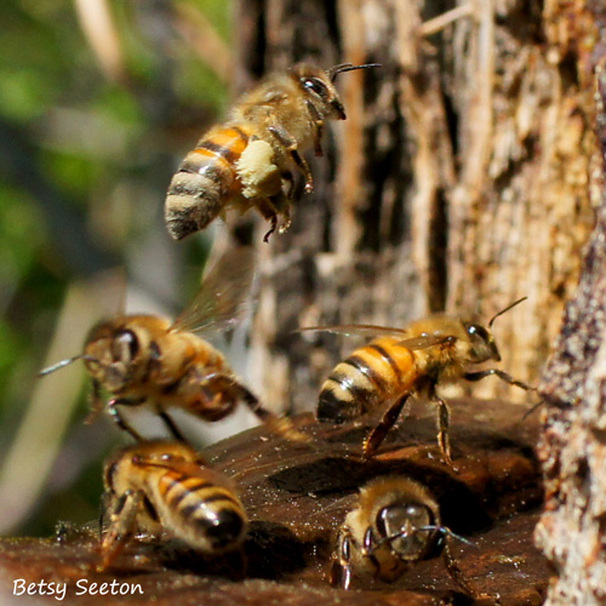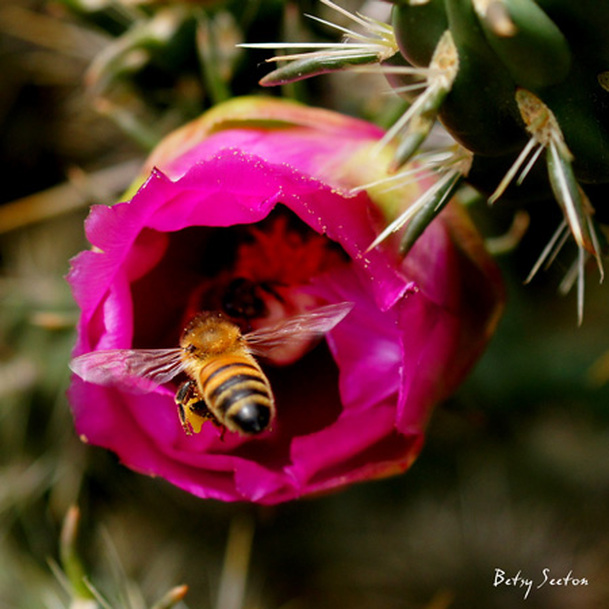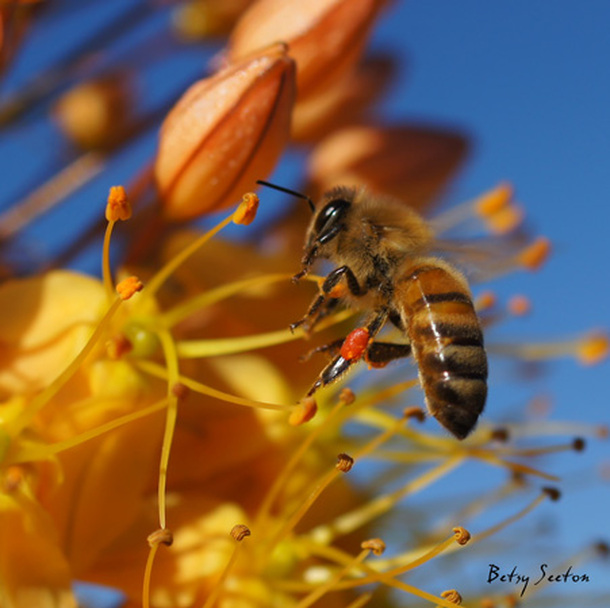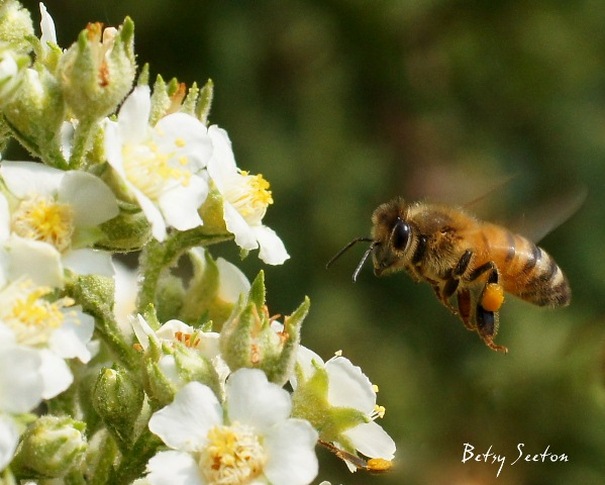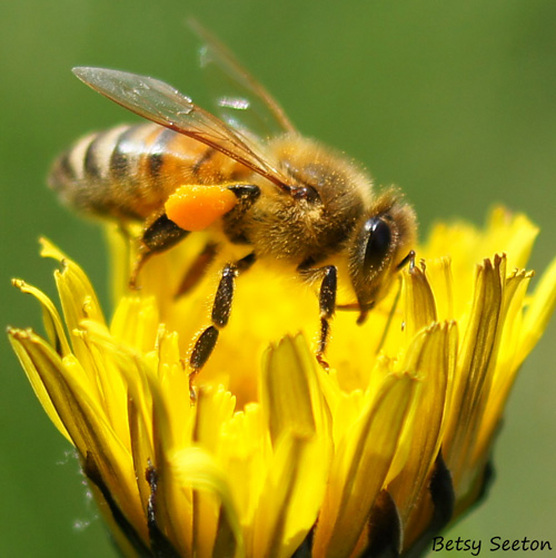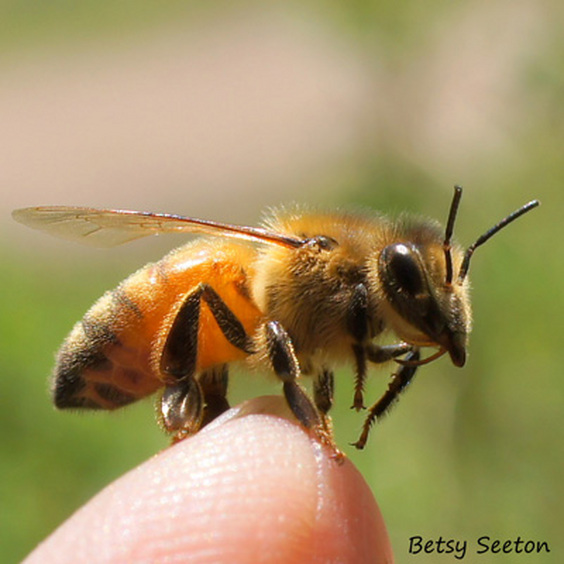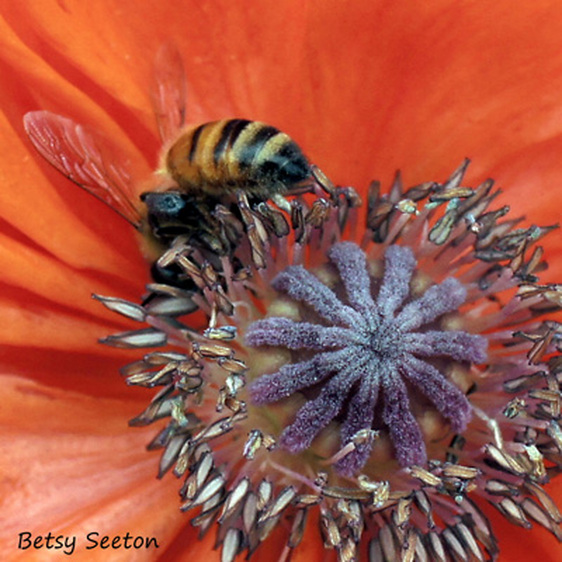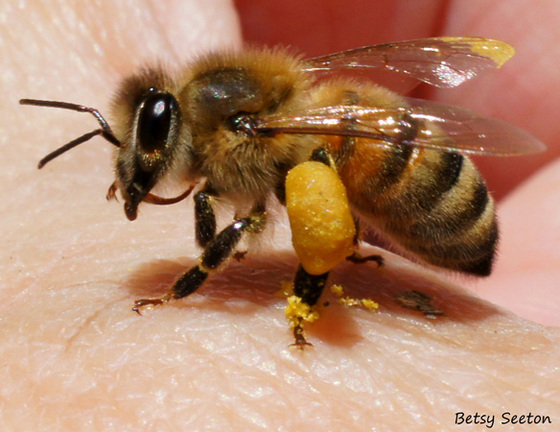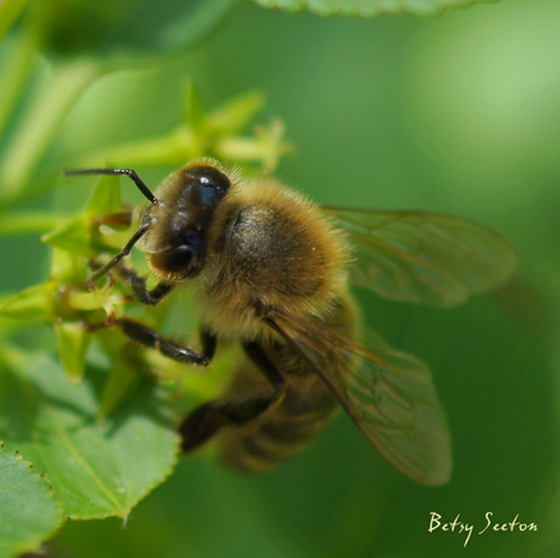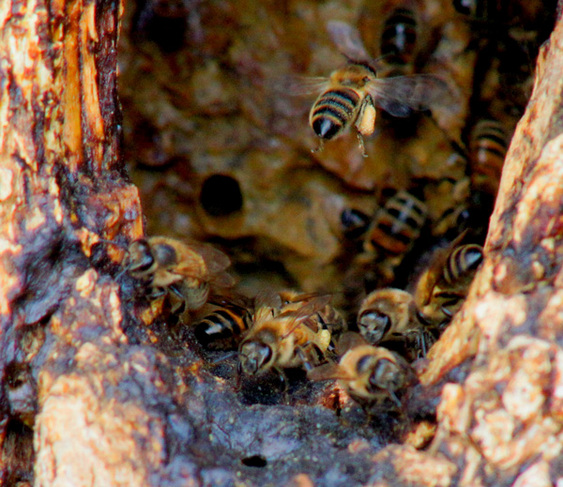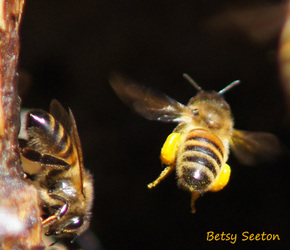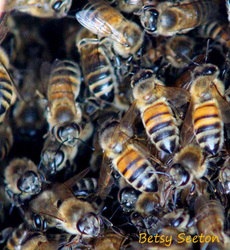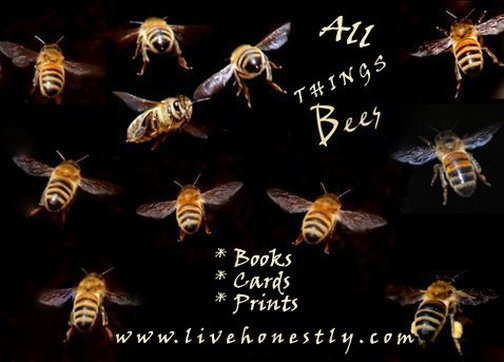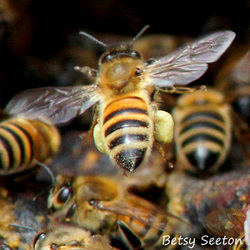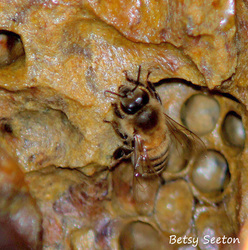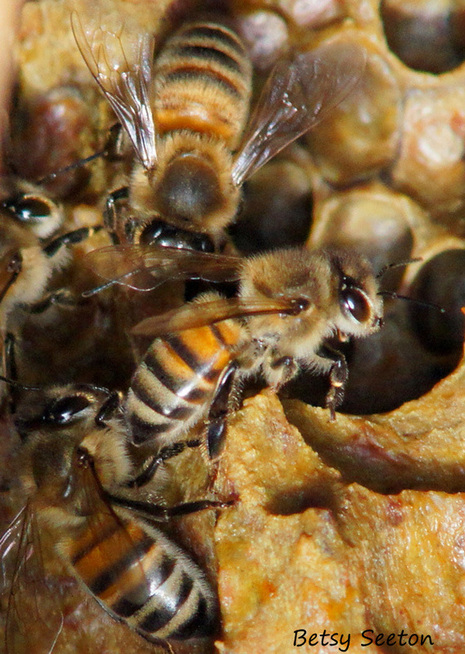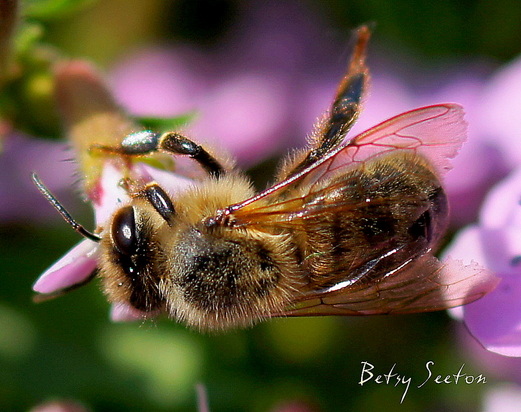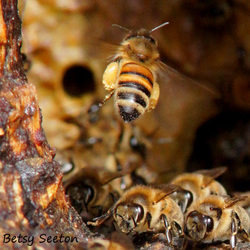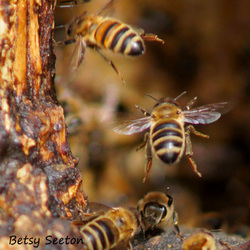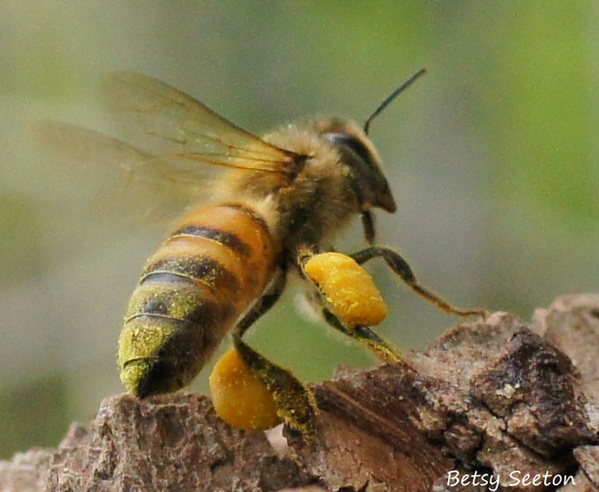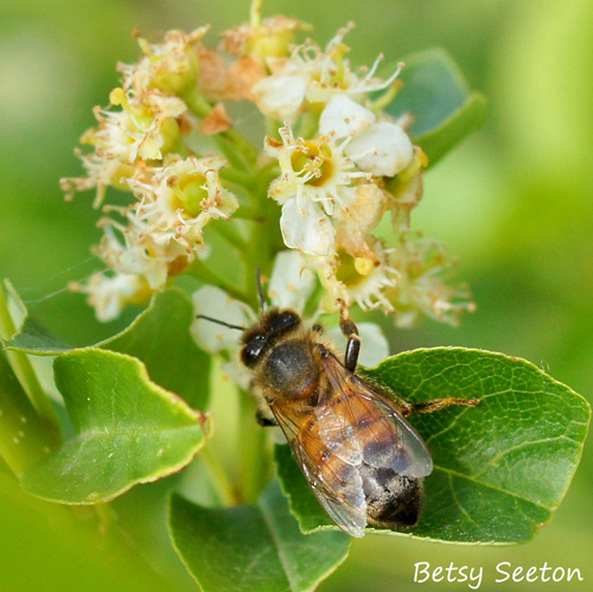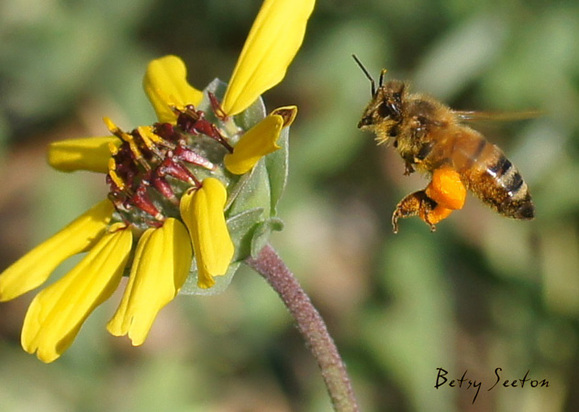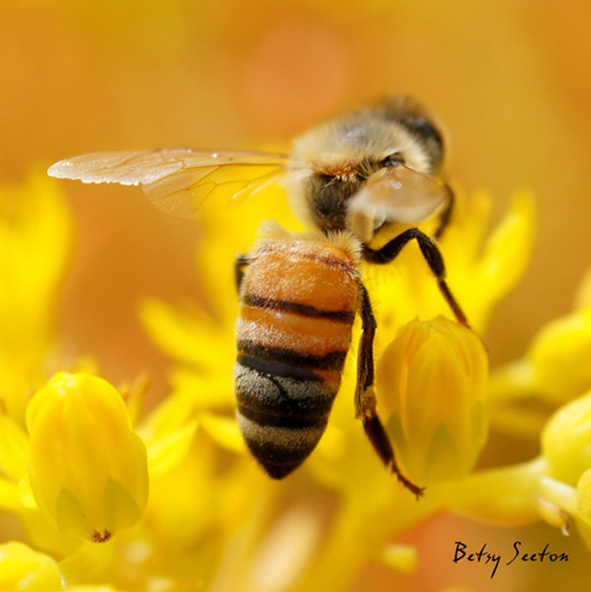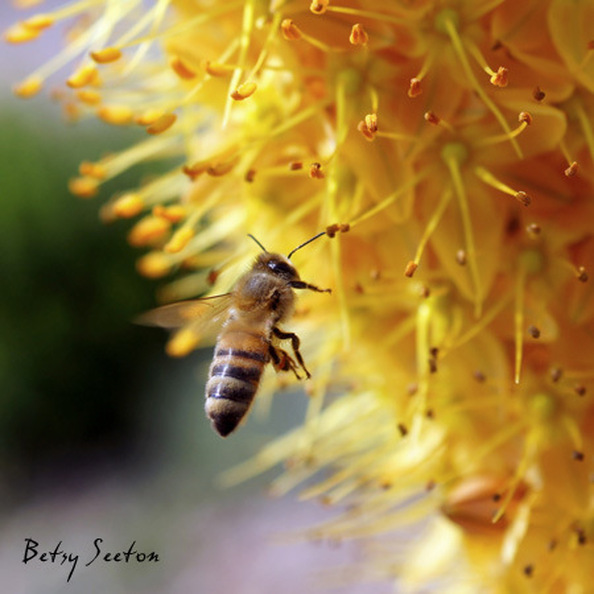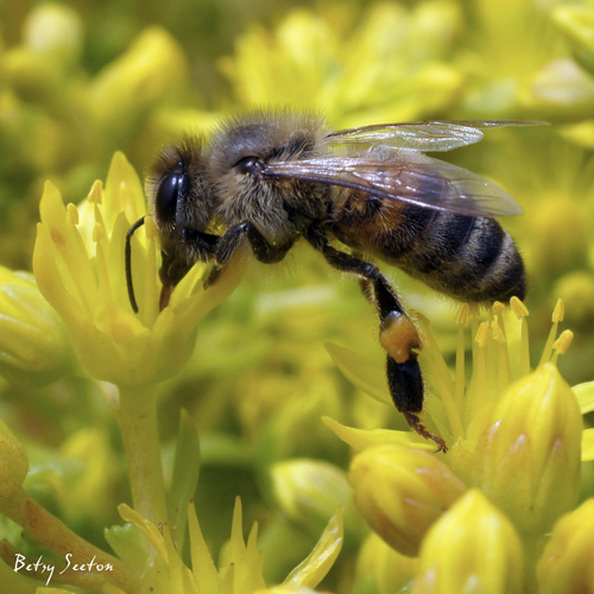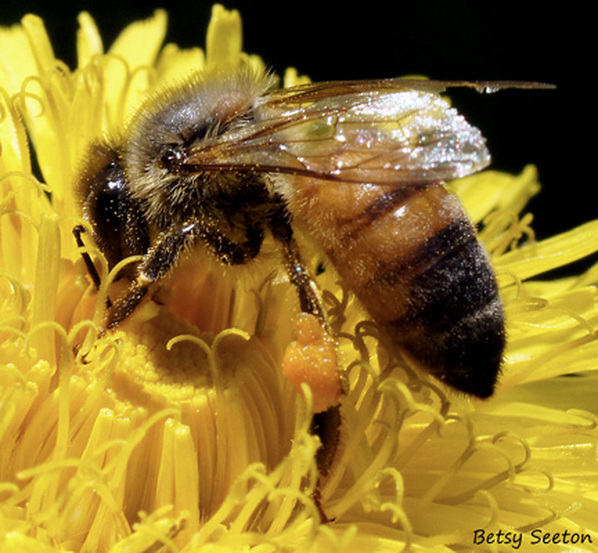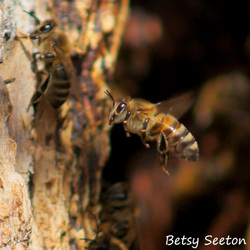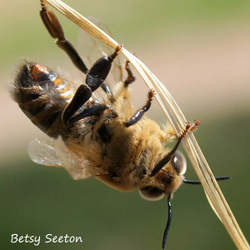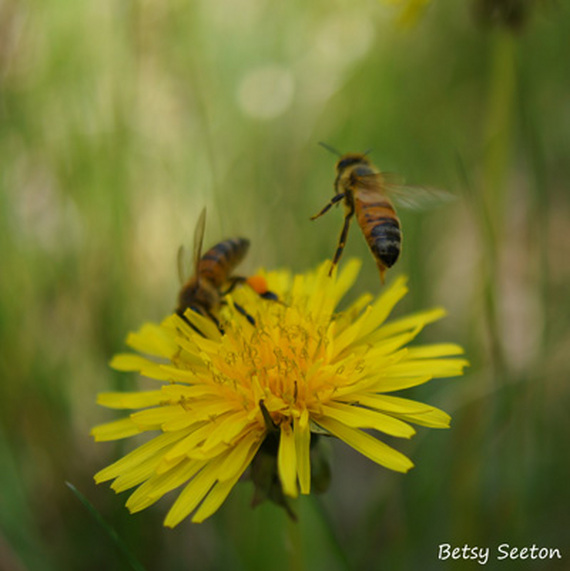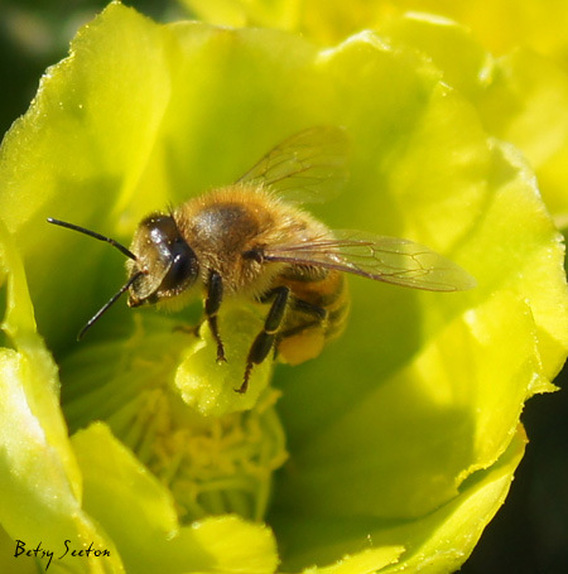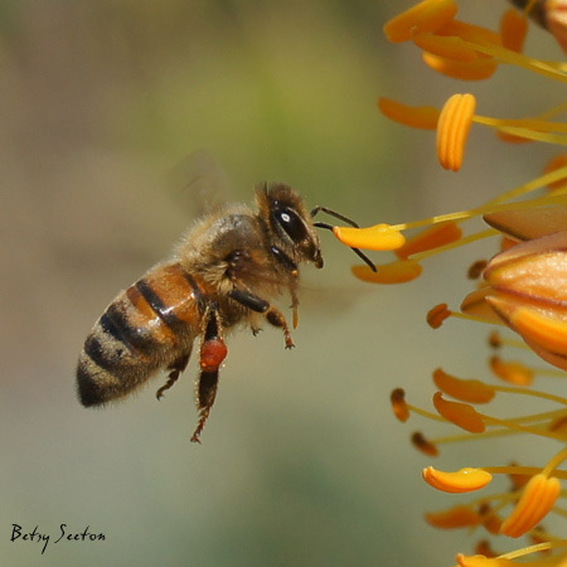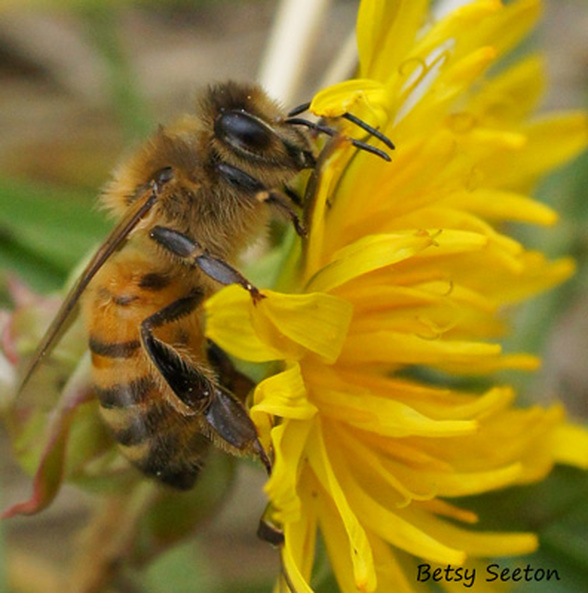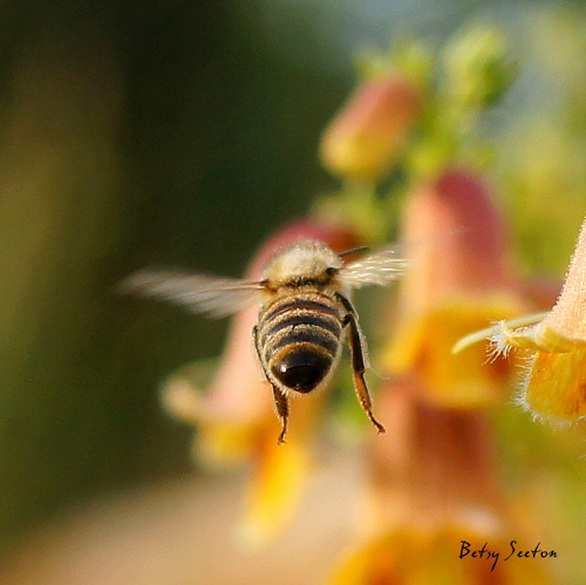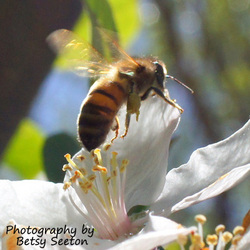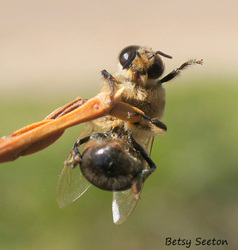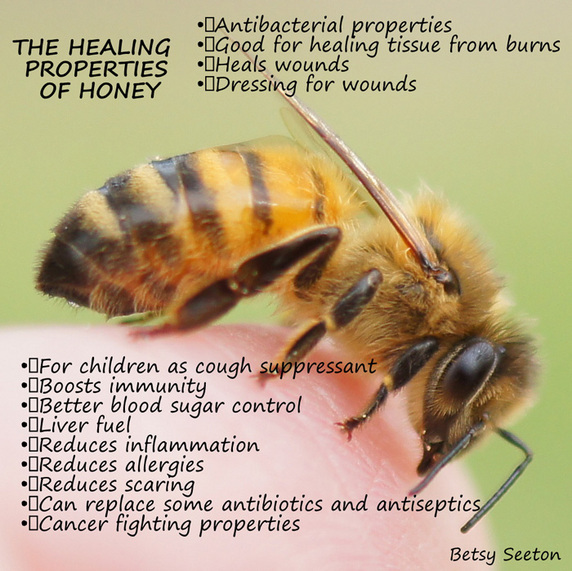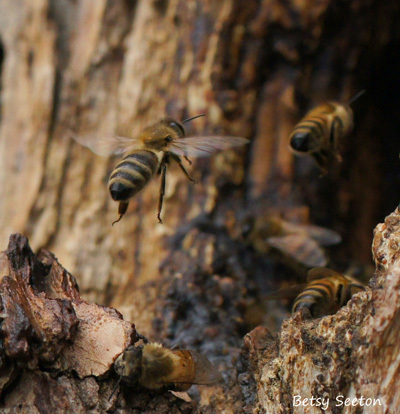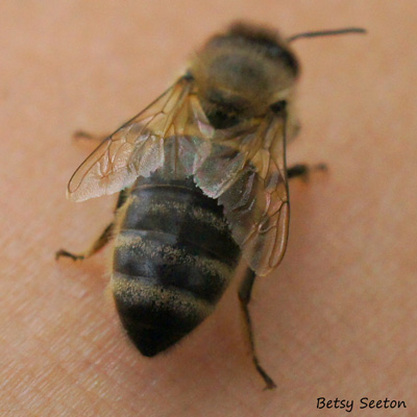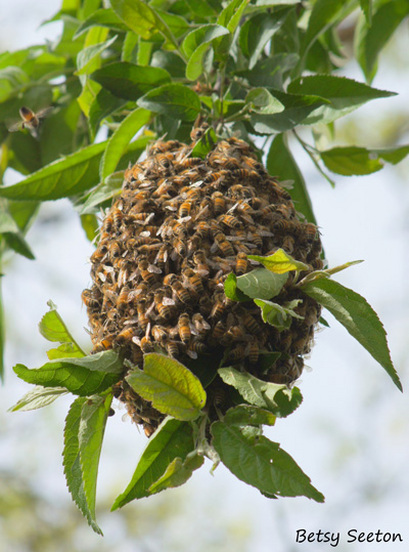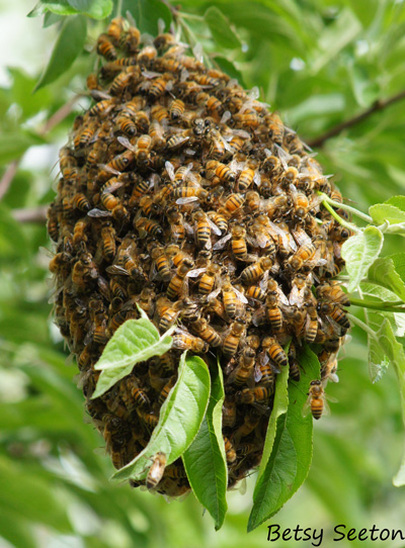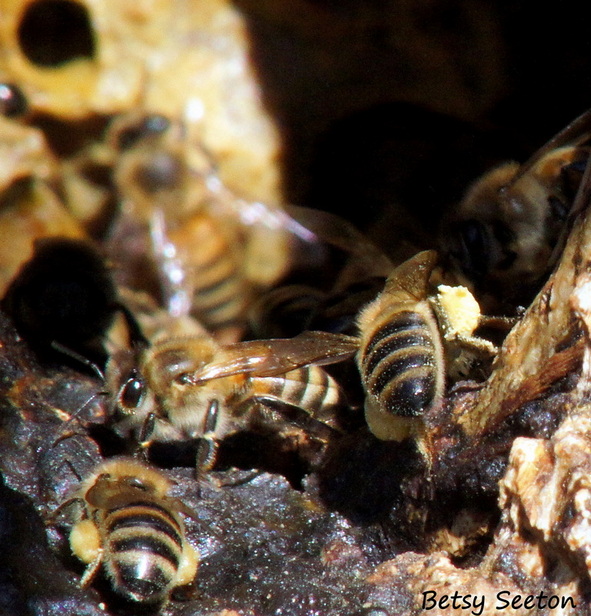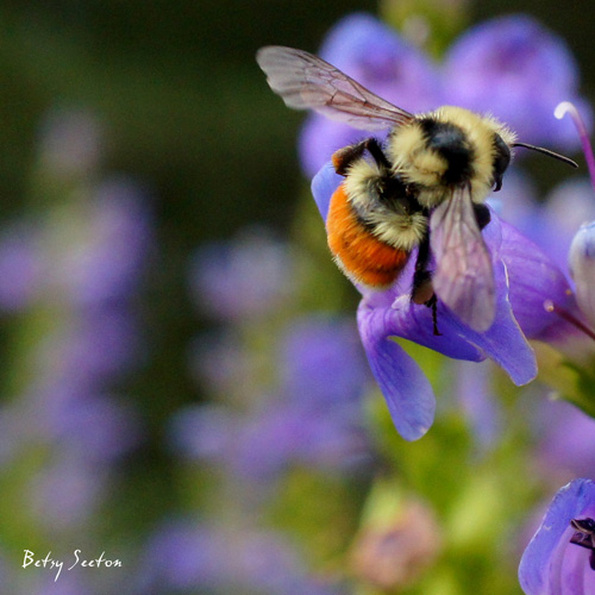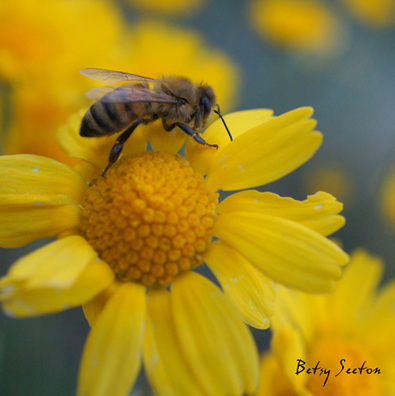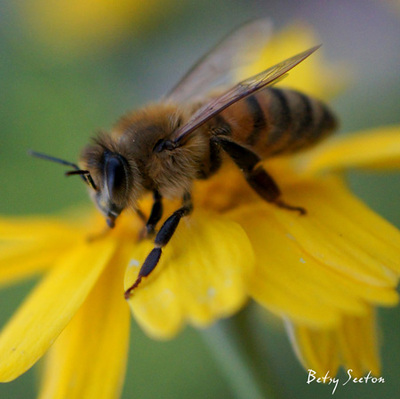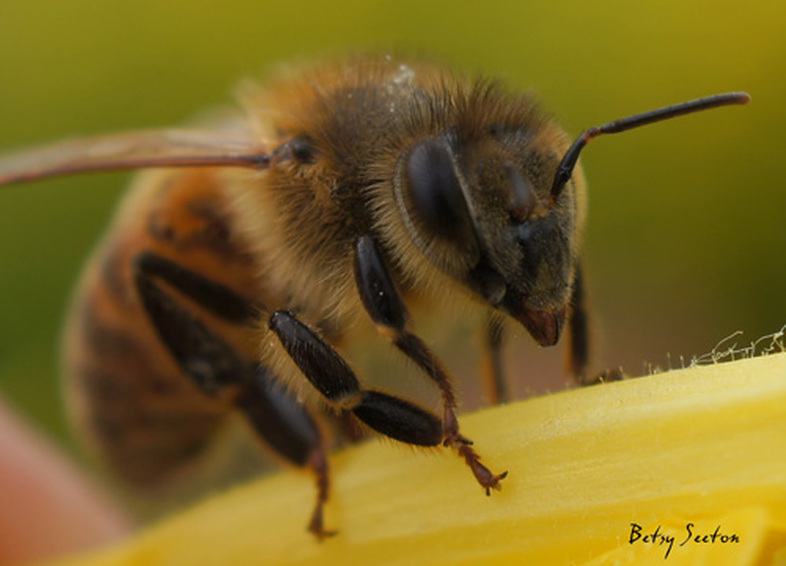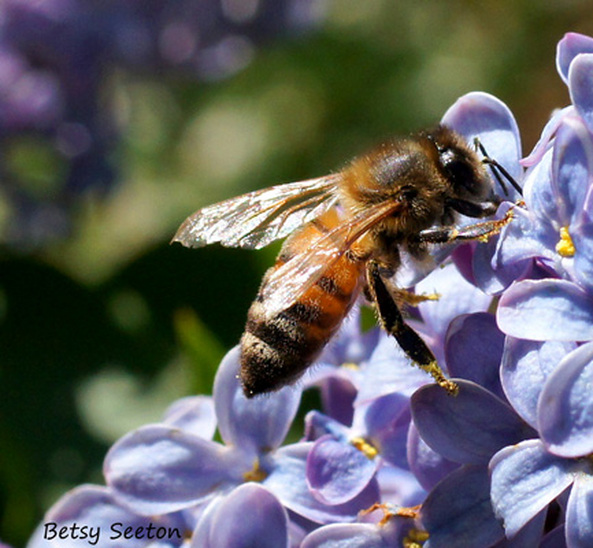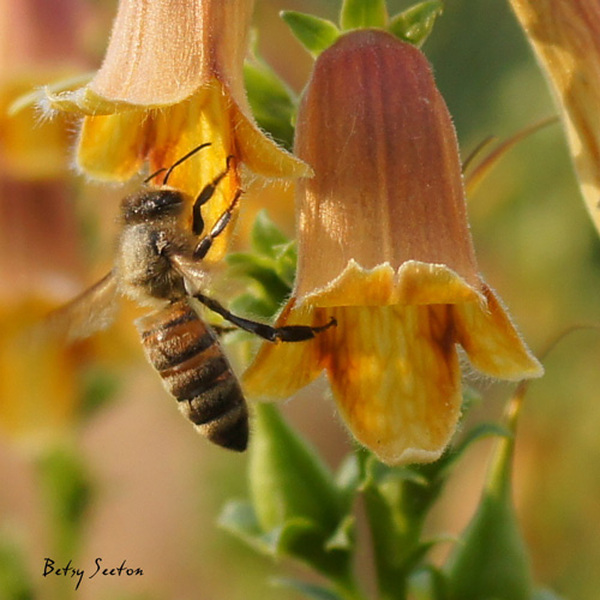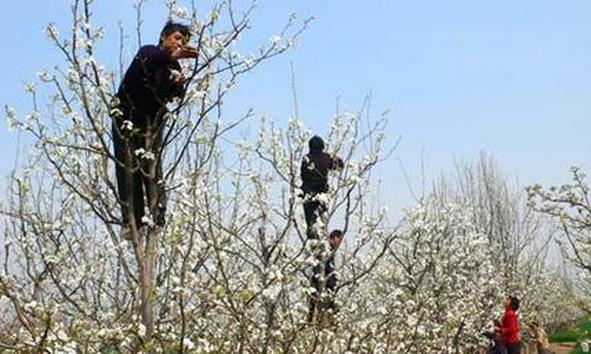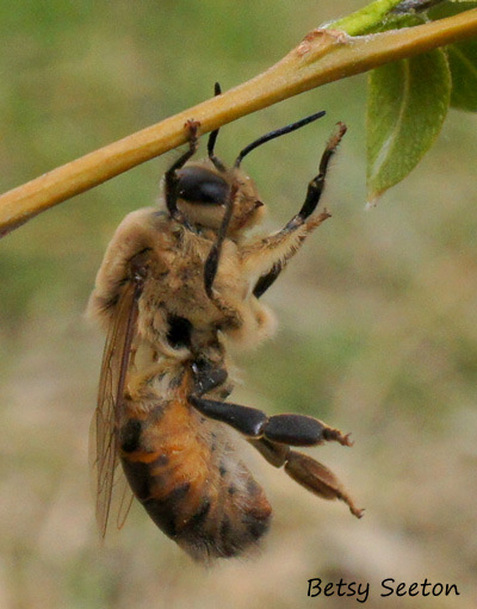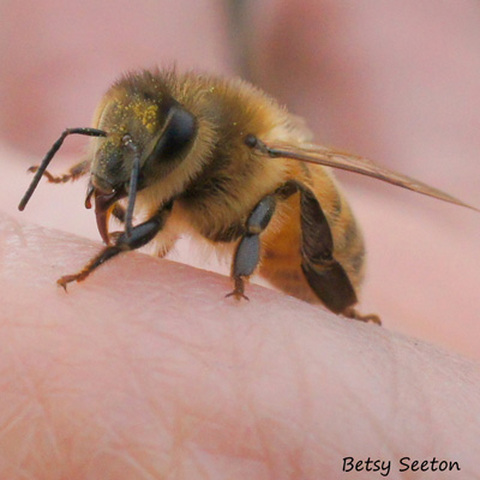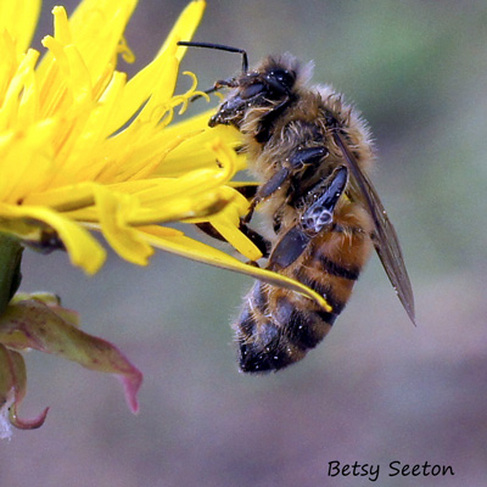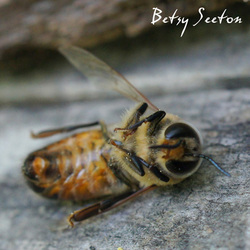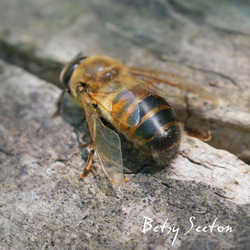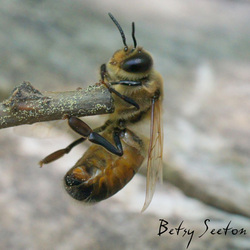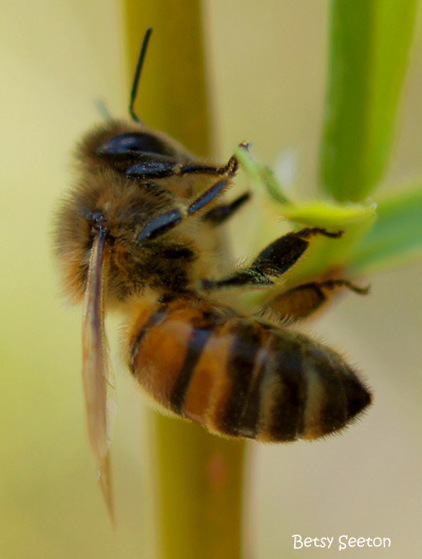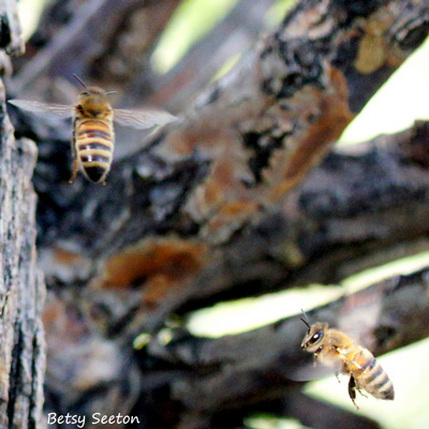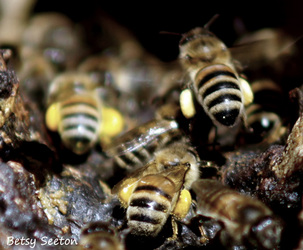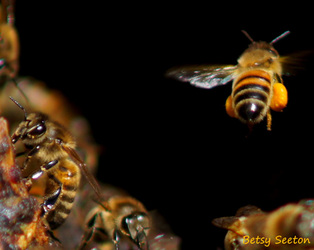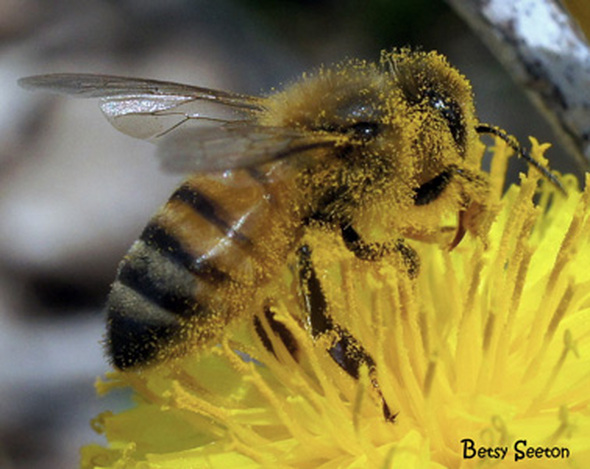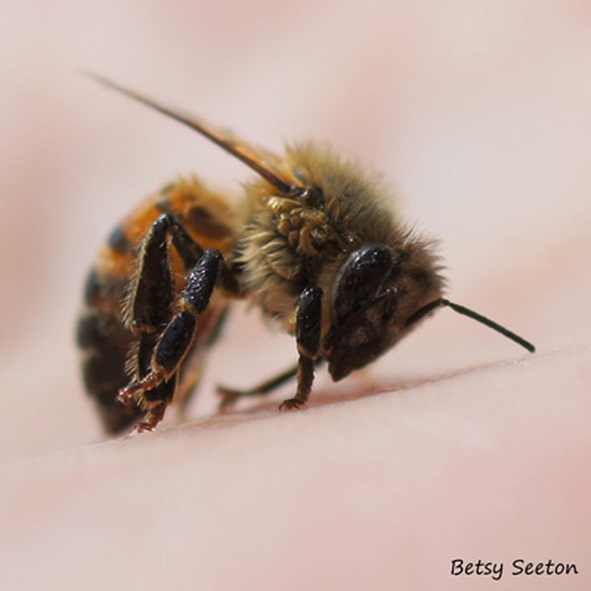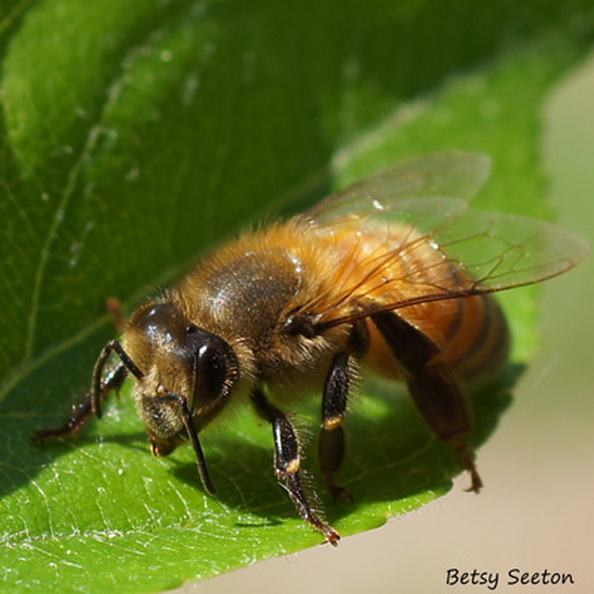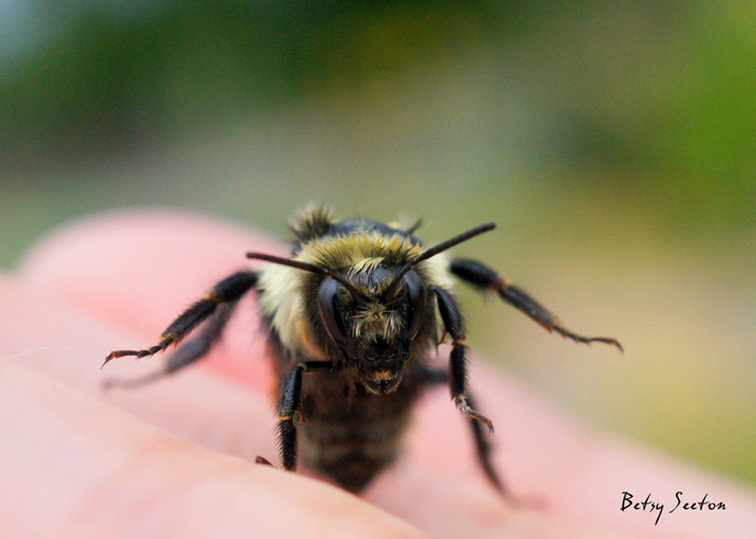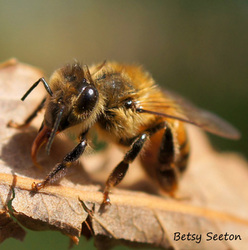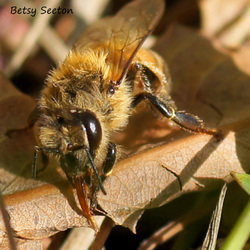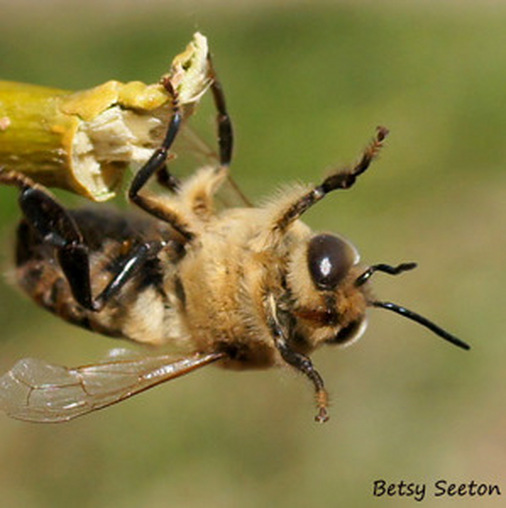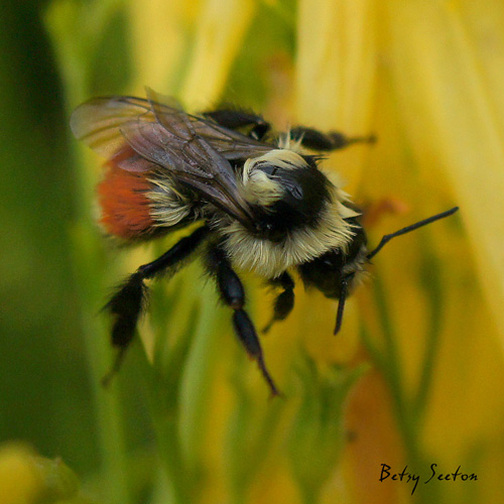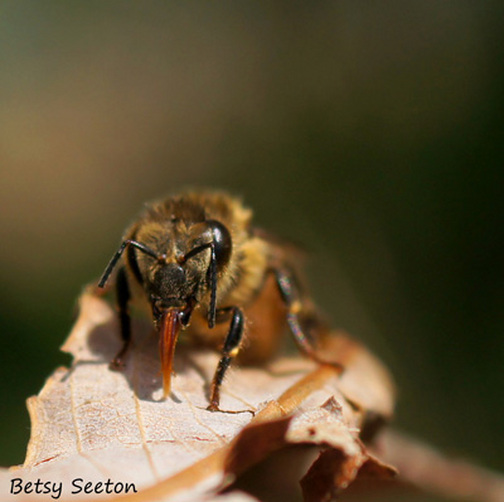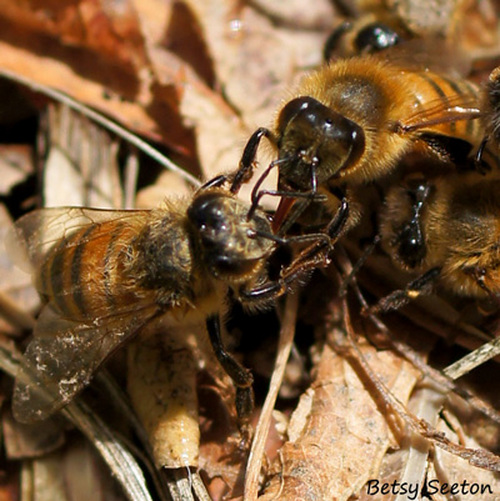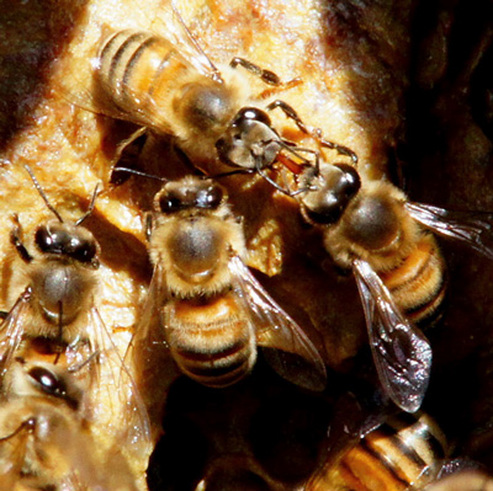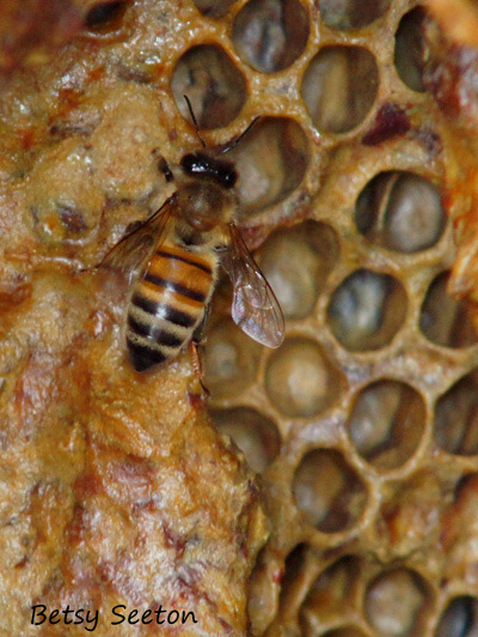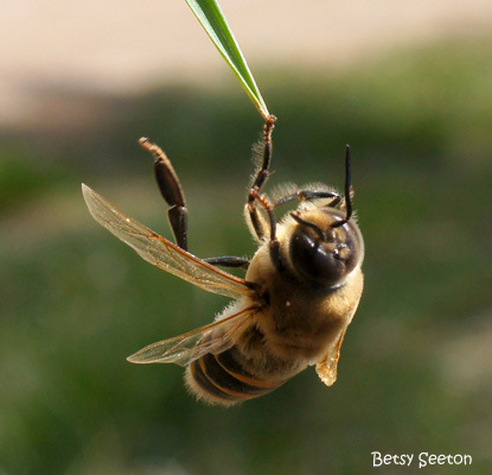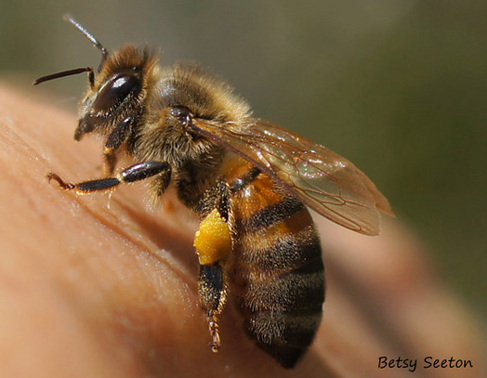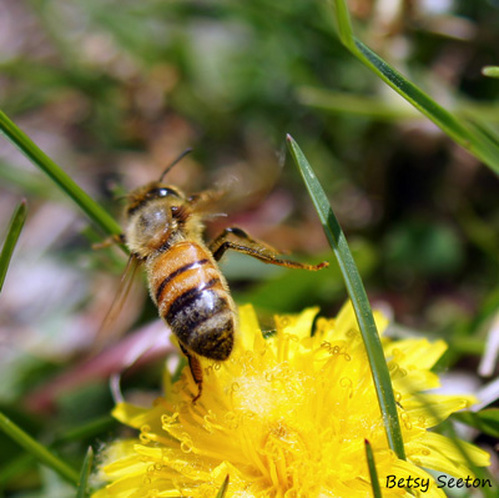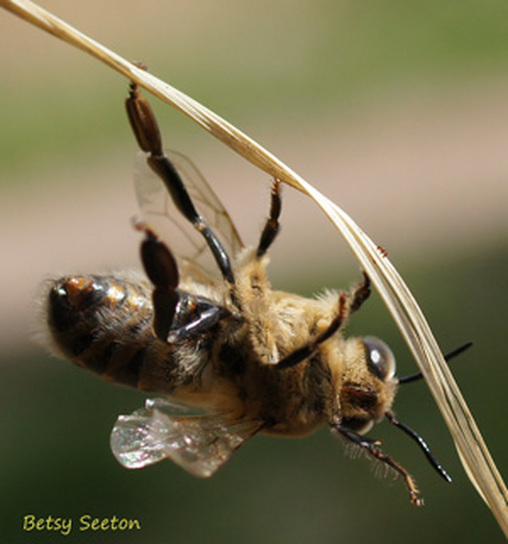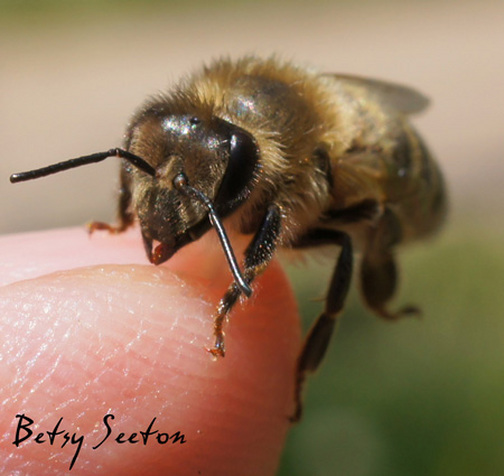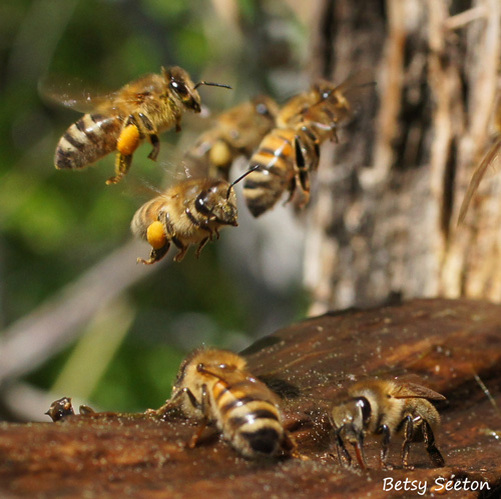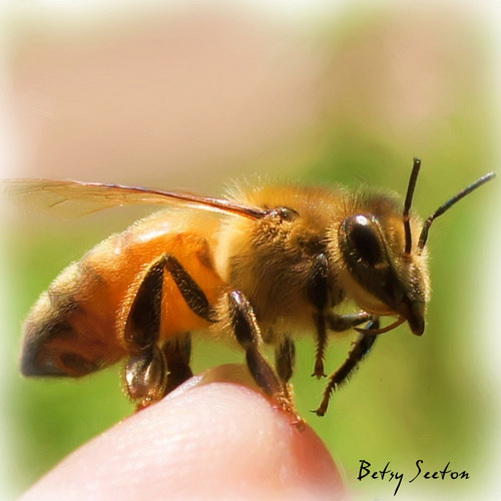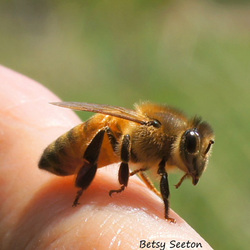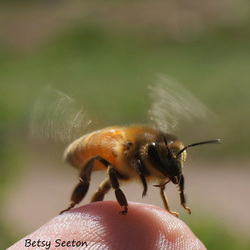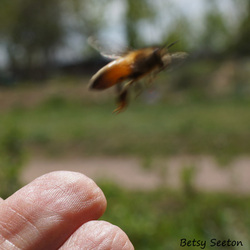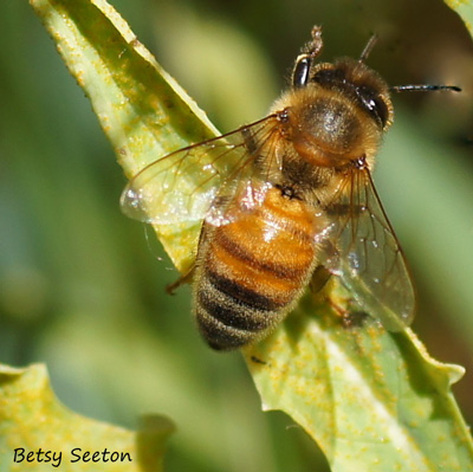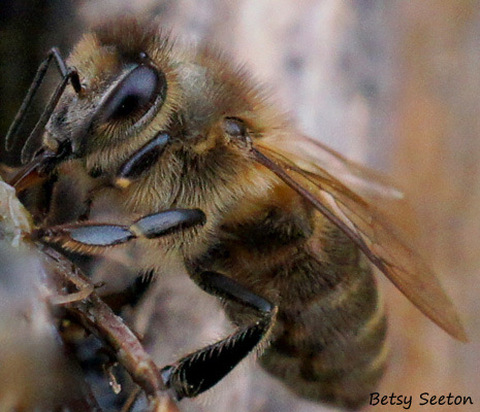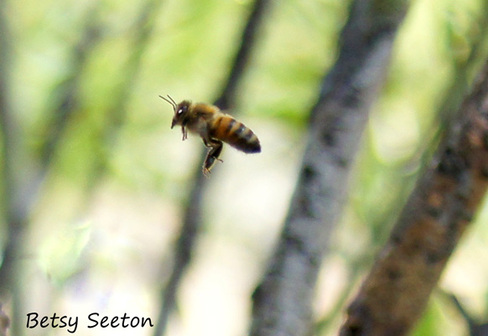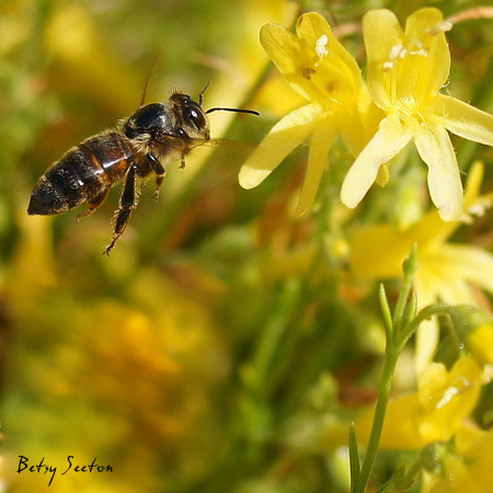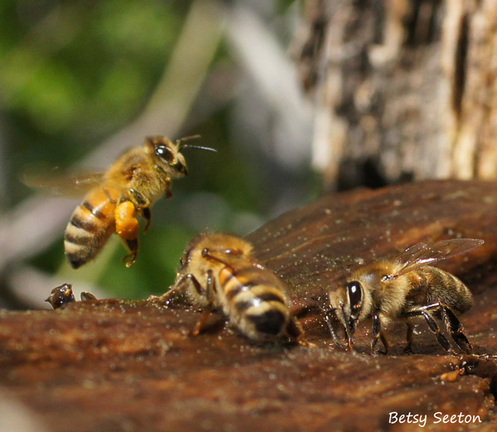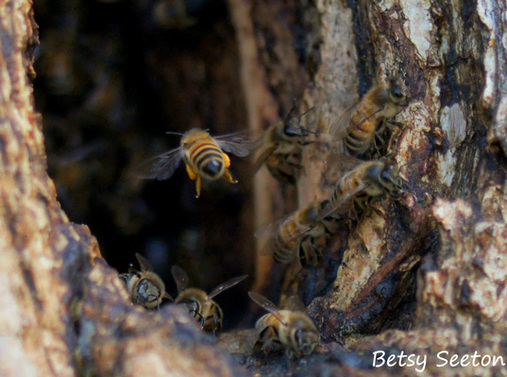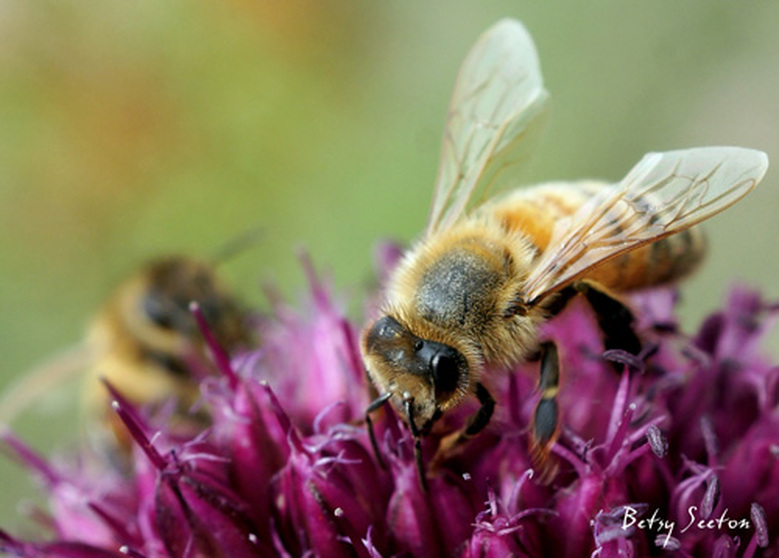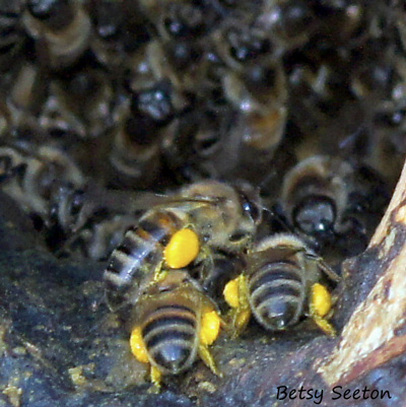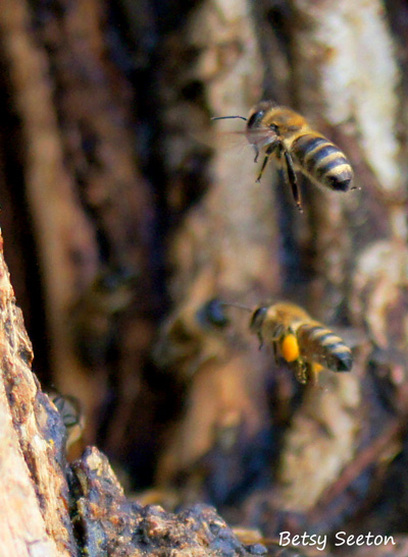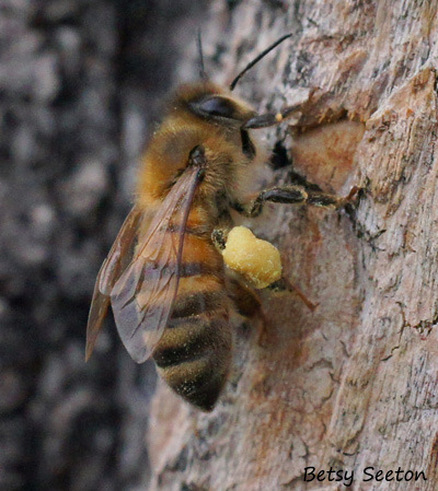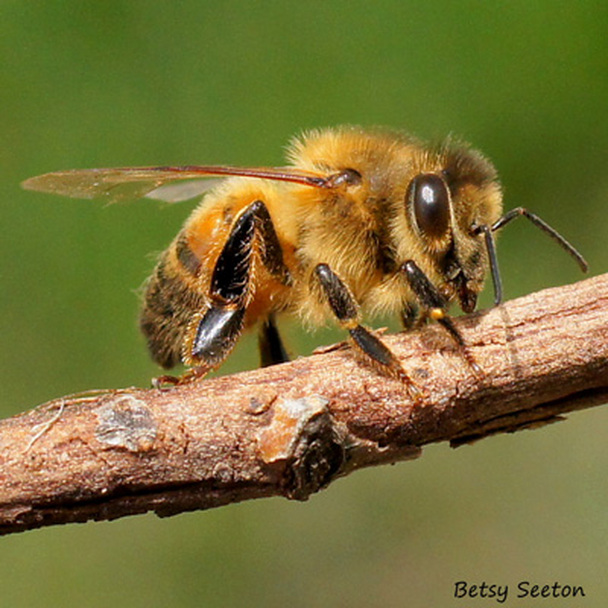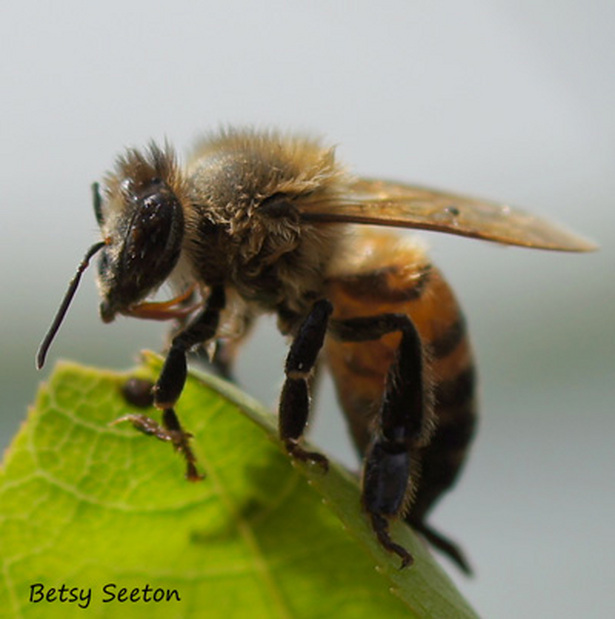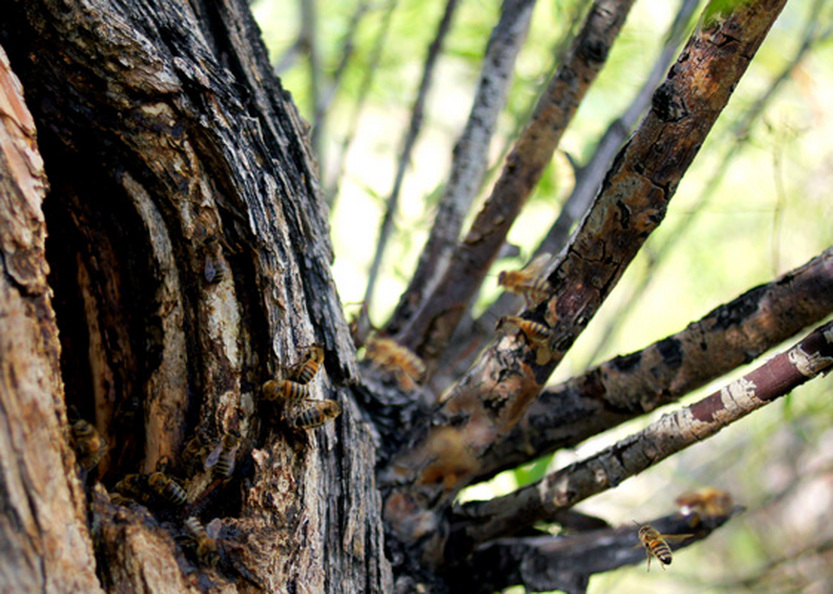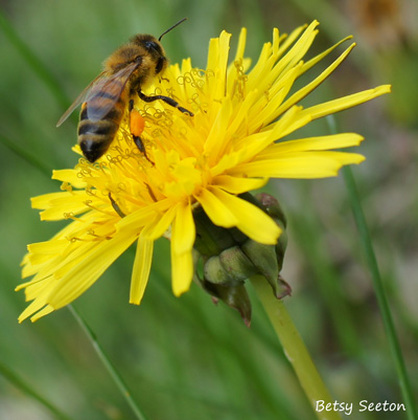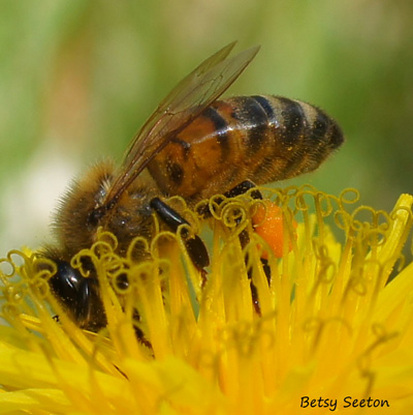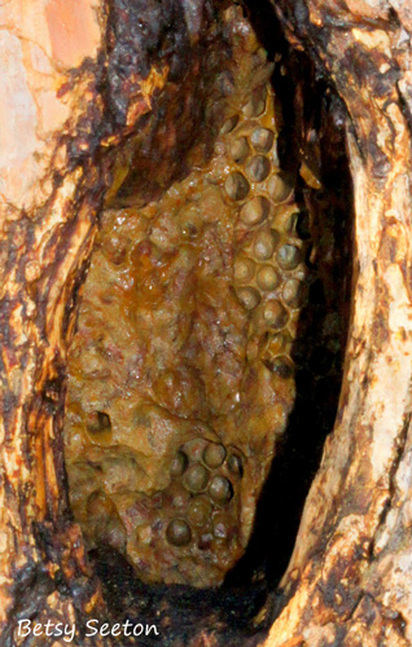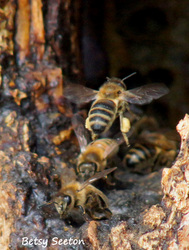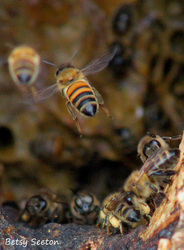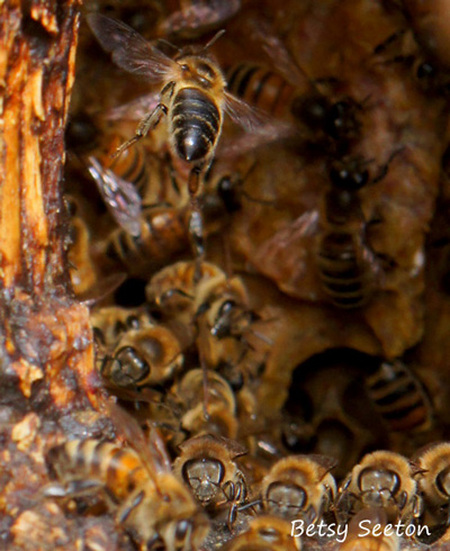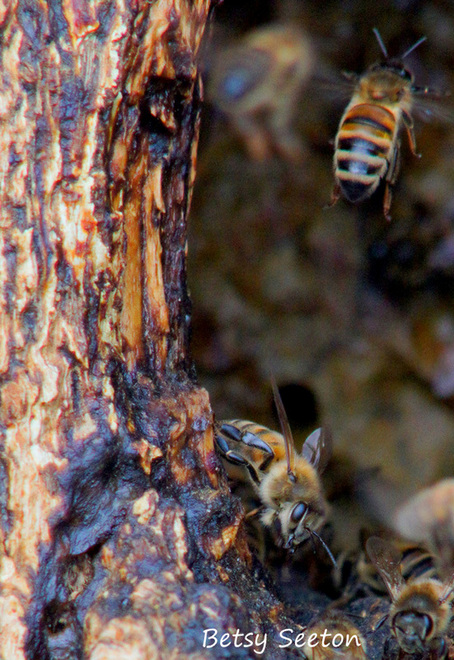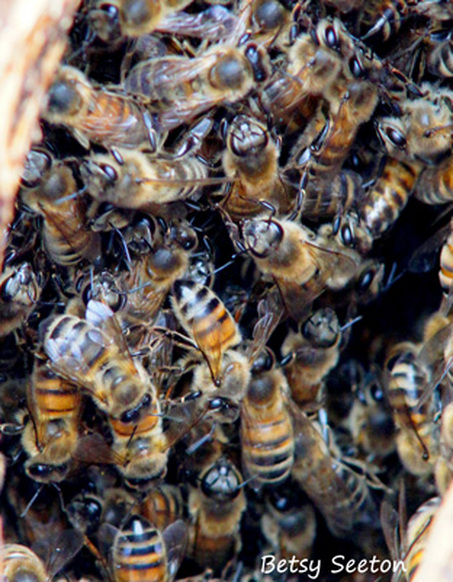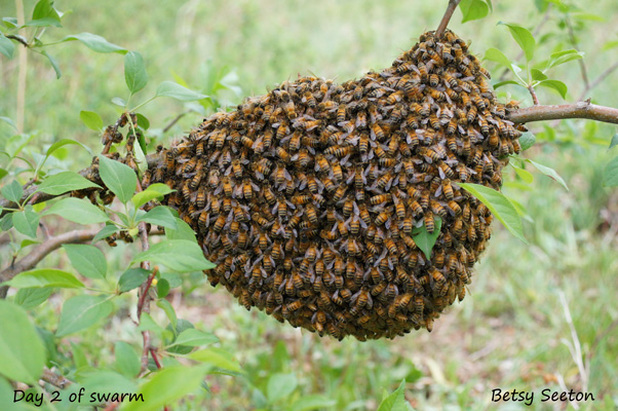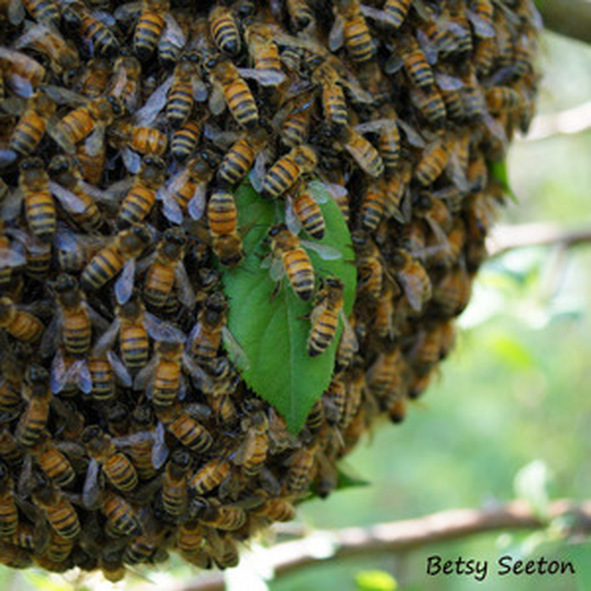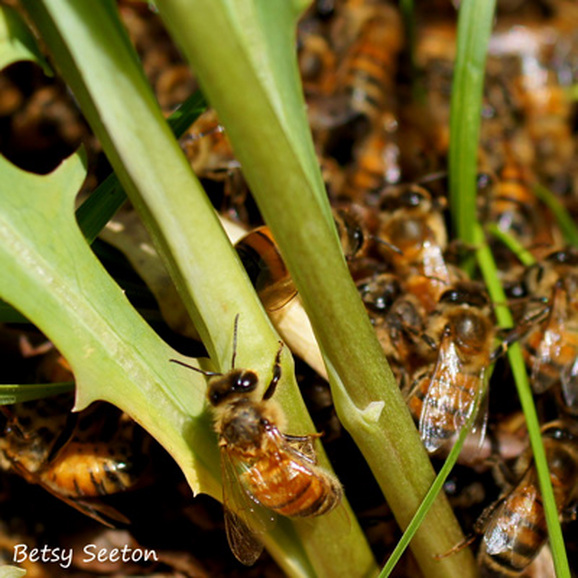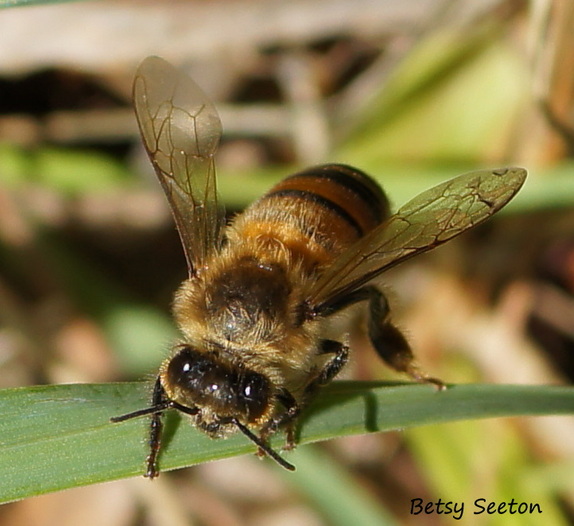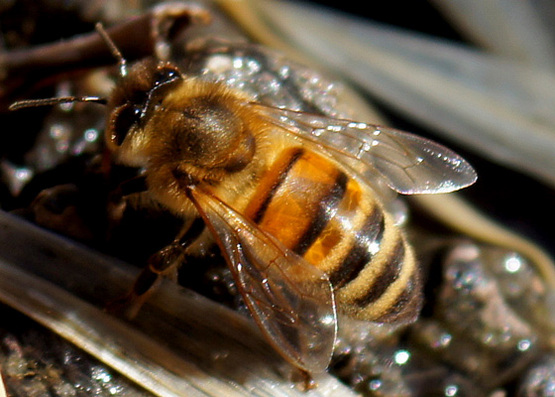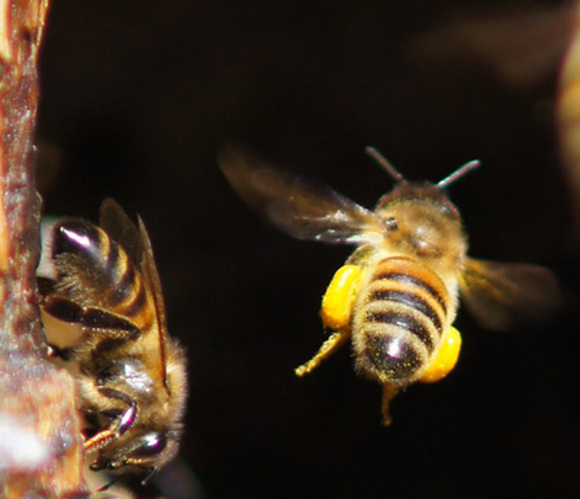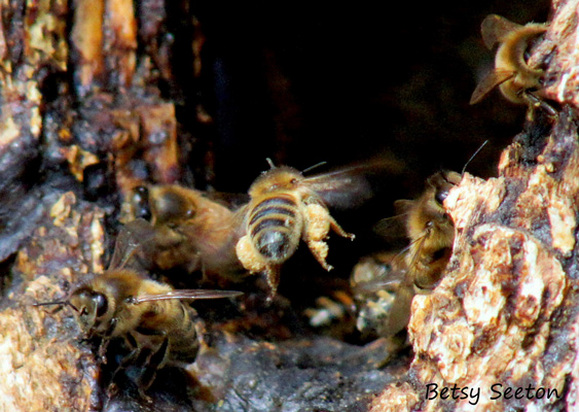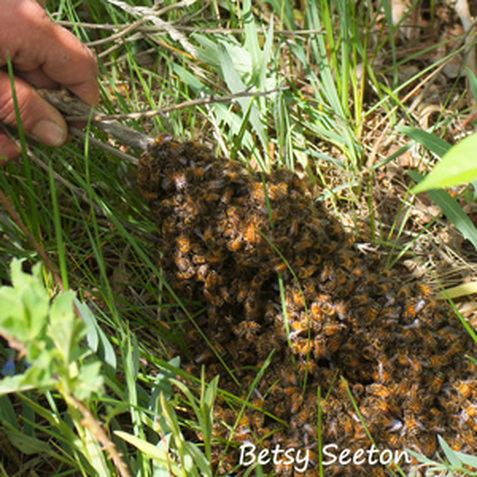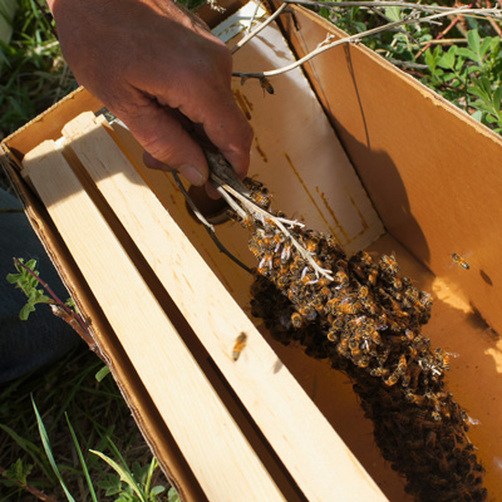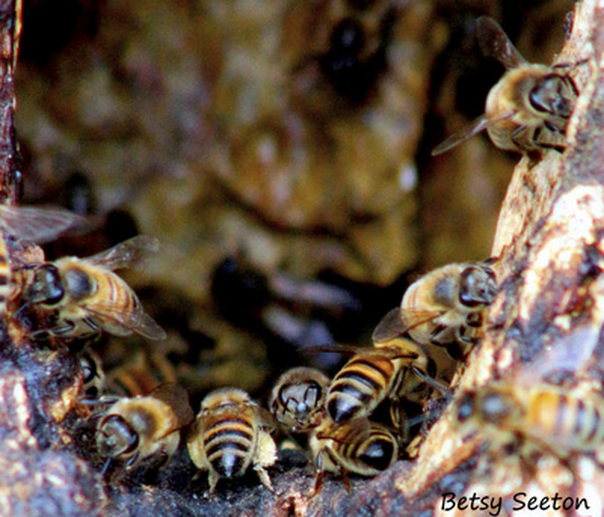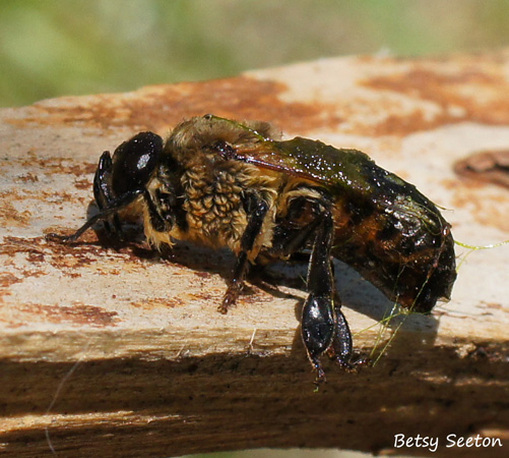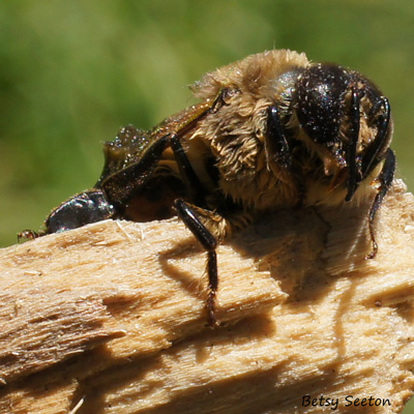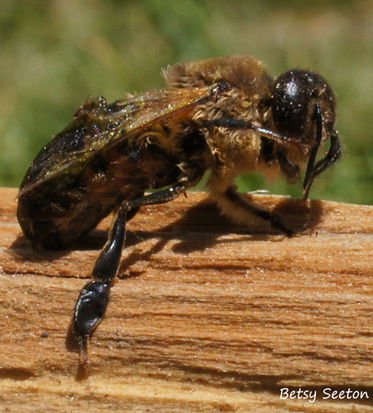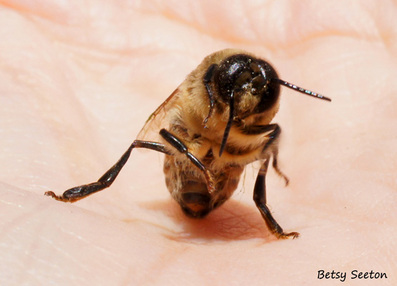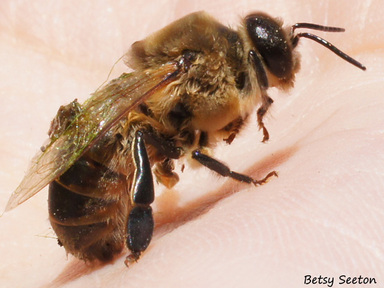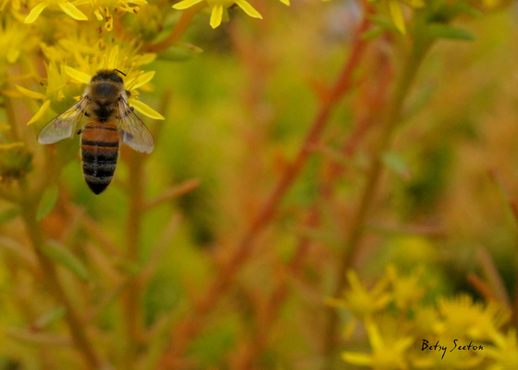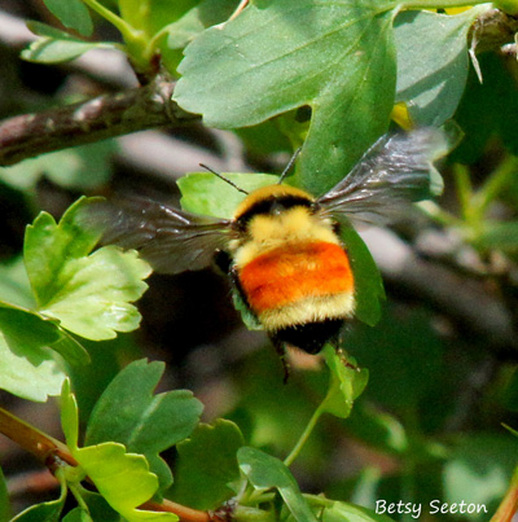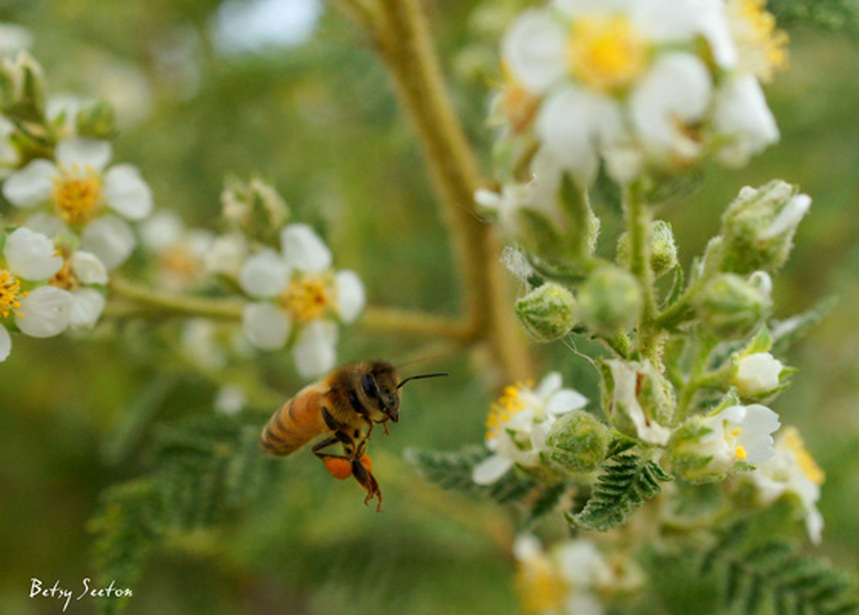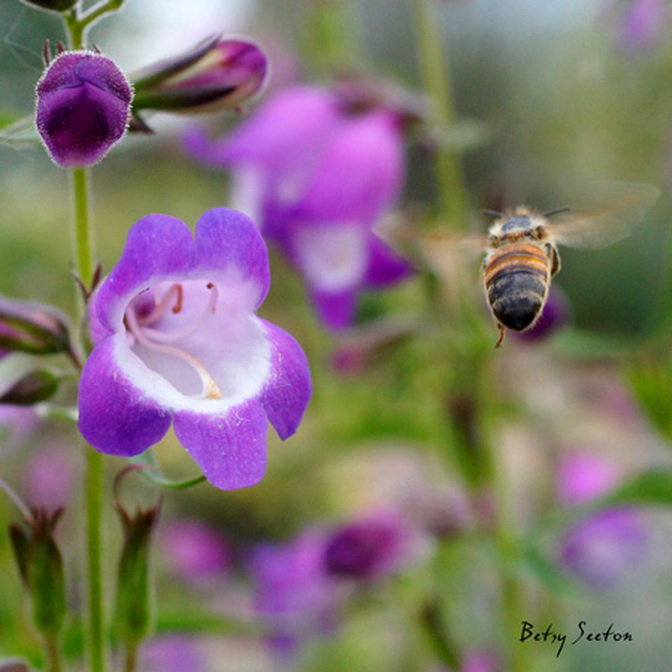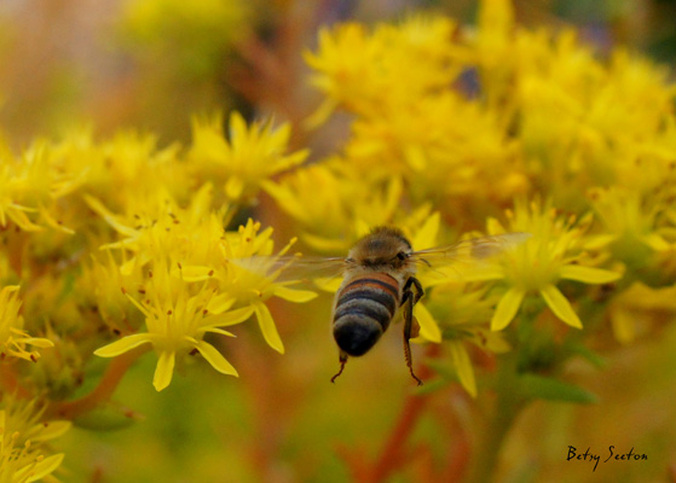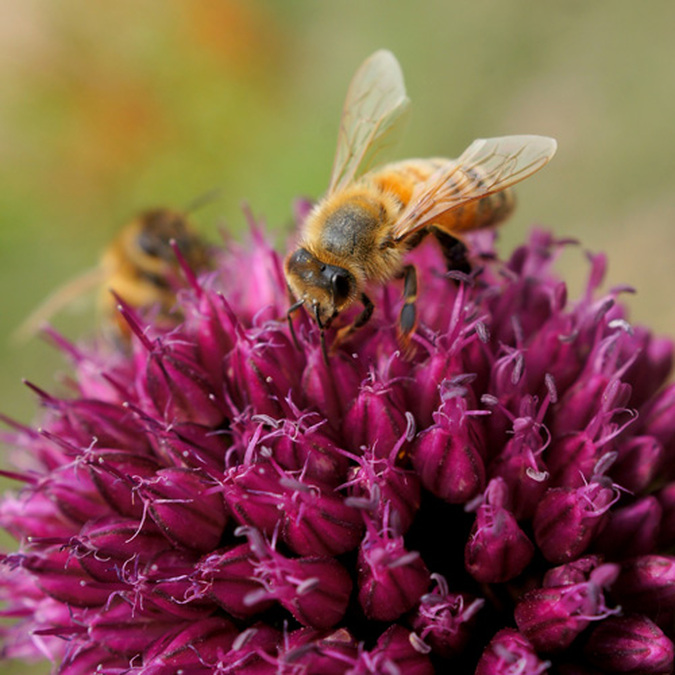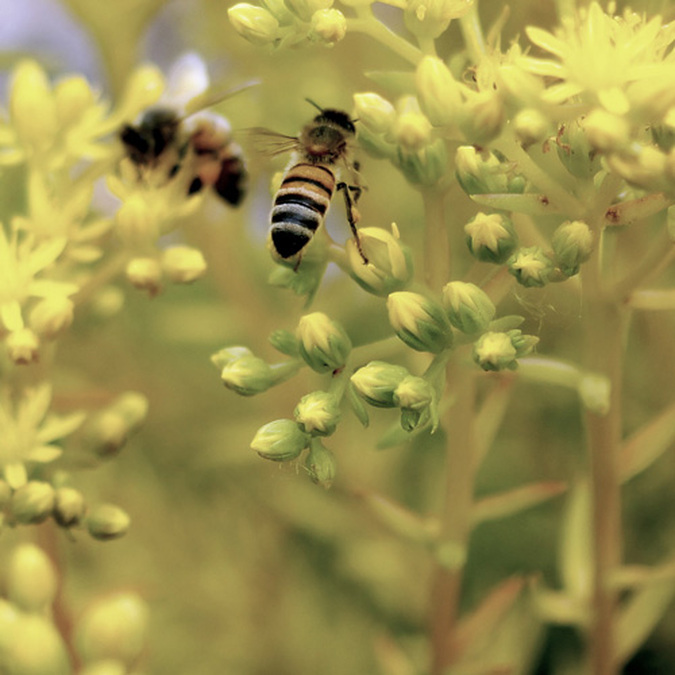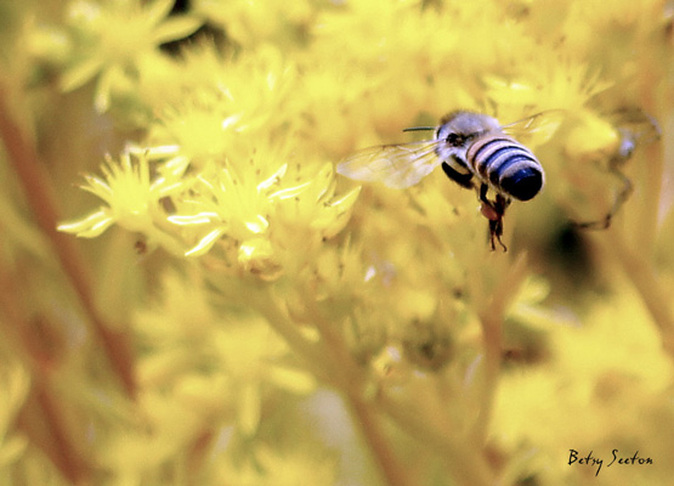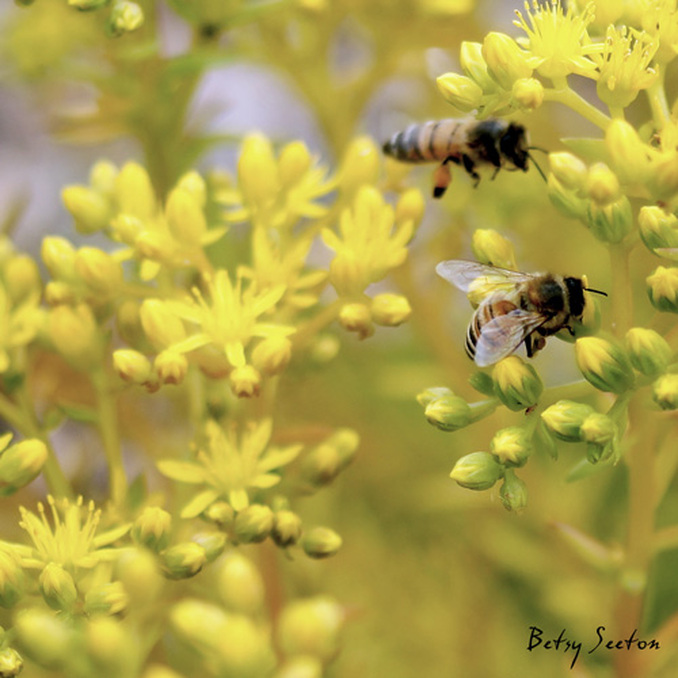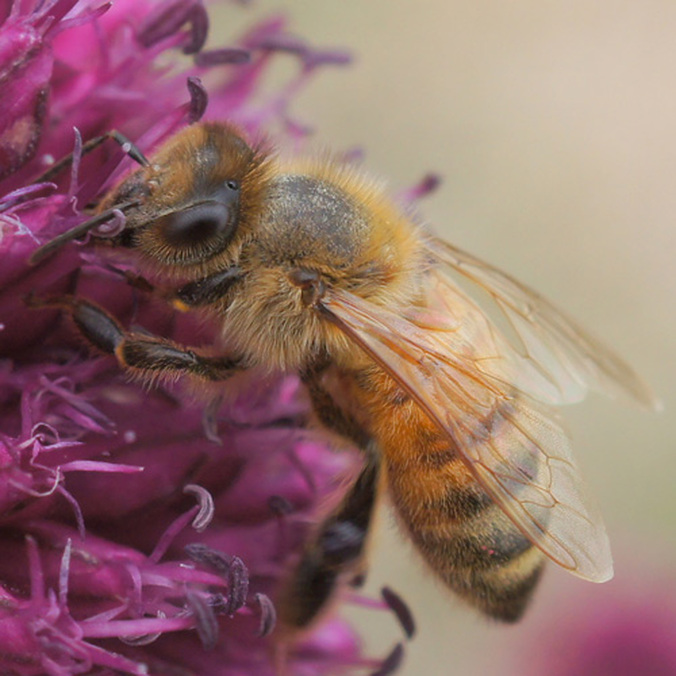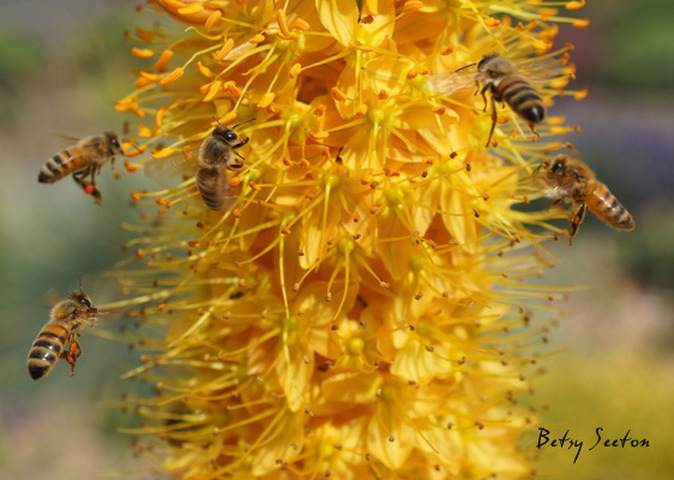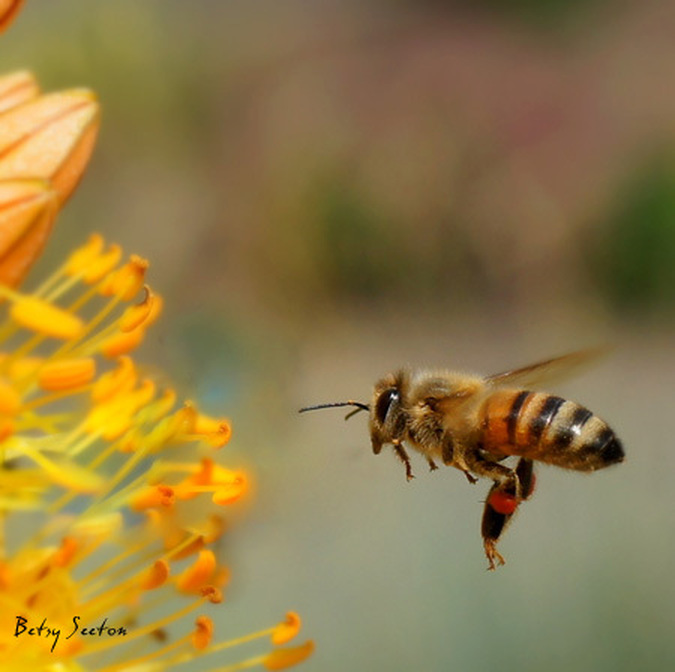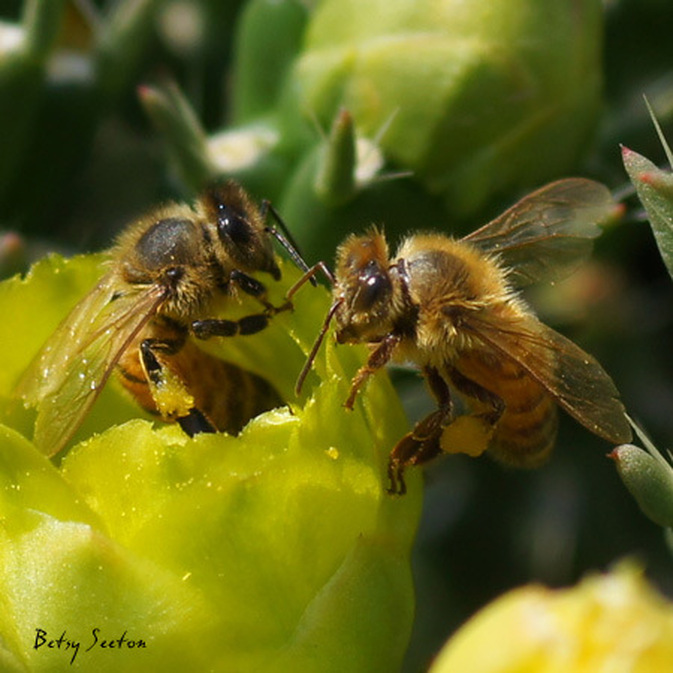Click to read about Glyphosate: Health Concerns and Safer Alternativesdrugwatch.com/roundup/glyphosate/
Tiny Life Photography
by Betsy Seeton
by Betsy Seeton
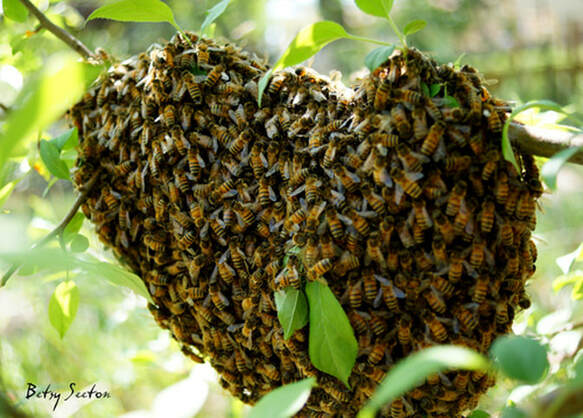 The first swarm I found in 2011.
The first swarm I found in 2011.
The honey bee has been around for 100 million years. They are gentle creatures by nature and don't want to sting anyone. They are entirely content going about their business, which is all about making honey.
This page was started in 2011 when I first fell in love with bees. It's now half way through 2015 and I have my own honey bee hive. I started a blog about my connection with bees that is on my other website called FOR ALL THE ANIMALS. My blog is called For All The Bees. Below are photos of honey cappers from inside my hive.
The more I learn about bees, the more I want to know. My first "bee" blog was on February 19, 2011. I'd discovered a wild beehive with honey bees. I am reminded of the famous quote by Lao-Tzu where a thousand miles begins with a single step. My bee journey began with a single bee -- quite literally. I was photographing one bee in February and as I followed the bee around, I looked up at one point and realized she had taken me to her beehive. Since that day, I've been visiting the hive often -- sometimes daily -- weather permitting. It's been my very own live nature show. I am in love with, and in awe of, these stunning creatures!
12 x 12 HARDBACK BOOK OF 30 PAGES FILLED WITH
OVER 155 COLOR PHOTOS OF WILD BEES IN NATURE
12 X 12 BOOK WITH BEAUTIFUL, COLOR FILLED PAGES OF
PHOTOGRAPHY AND A STORY THAT WILL INSPIRE AND WARM YOUR HEART
PHOTOGRAPHY AND A STORY THAT WILL INSPIRE AND WARM YOUR HEART
Dr. Stephen Buchmann writes the Foreword,
Co-author of The Forgotten Pollinators and author of Letters From the Hive
Co-author of The Forgotten Pollinators and author of Letters From the Hive
EXCERPT FROM THE BOOK'S FOREWORD:
"Bee Inspired is an intimate book; you'll be captivated, caught in its spell. It feels as if you are there in the garden exploring, tiny game-hunting with Betsy, peering through the lens of her camera. Here we find the rare talent of crisp, clean writing, along with an eye for composing and taking many of the best anywhere color photos of bees foraging at blossoms."
"Bee Inspired is an intimate book; you'll be captivated, caught in its spell. It feels as if you are there in the garden exploring, tiny game-hunting with Betsy, peering through the lens of her camera. Here we find the rare talent of crisp, clean writing, along with an eye for composing and taking many of the best anywhere color photos of bees foraging at blossoms."
Post by The Bees Knees.
My new website, GETTING IN TOUCH WITH NATURE, just launched. It showcases my photography, books, limited editions prints and other art related items and commentaries on my love for nature.
I'm very hands on in life ...
I'm very hands on in life ...
Photos in the slideshow above were taken August 30th & 31st, 2011 by Betsy Seeton
After the bumble bee was diving for nectar, she pulled
out of the flower and lost her balance. The photo
below is a capture of her falling before she began to fly!
out of the flower and lost her balance. The photo
below is a capture of her falling before she began to fly!
The photos below are all of bumble bees I took on June 28th or the 30th, 2011
Below is a small bumble bee not having a very good day. I picked her up; she was very disoriented and would crawl until she fell. It's probably effects from another pesticide poisoning.
THE MOVIE: VANISHING OF THE BEES
Vanishing of the Bees is the most important documentary of 2011. Please put it on your must-see list. Learn about how honeybees have been mysteriously disappearing across the planet, literally vanishing from their hives. "Known as Colony Collapse Disorder, this phenomenon has brought beekeepers to crisis in an industry responsible for producing apples, broccoli, watermelon, onions, cherries and a hundred other fruits and vegetables. Commercial honeybee operations pollinate crops that make up one out of every three bites of food on our tables."
Click image to watch the movie trailer Vanishing of the Bees.
Vanishing of the Bees is the most important documentary of 2011. Please put it on your must-see list. Learn about how honeybees have been mysteriously disappearing across the planet, literally vanishing from their hives. "Known as Colony Collapse Disorder, this phenomenon has brought beekeepers to crisis in an industry responsible for producing apples, broccoli, watermelon, onions, cherries and a hundred other fruits and vegetables. Commercial honeybee operations pollinate crops that make up one out of every three bites of food on our tables."
Click image to watch the movie trailer Vanishing of the Bees.
Follow Catherine Jaffee as she studies honey bees in Turkey ....
FROM CAT'S WEBSITE INSPIRED BEEING:
Its June 2011. I just quit my job and purchased a plane ticket to Turkey. My mission: to study honey bees in the country’s wild, remote, and beautiful Northeast. And if I survive? Start a social venture.
This blog is a collection of quick-witted posts on the start of my journey. It is also an exploration into the story behind bees, and how they have struck the hearts and minds of beekeepers, activists, foodies, entrepreneurs, authors, celebrities, and fictional characters world-wide.
Inspired Beeing is an attempt to compile these accounts of discovery, trial, and inspiration in one creative sweet sticky blog. To learn more about the fresh underbelly of entrepreneurship, social good, and honey bees (or the wily adventures of Cat Jaffee) explore the site and check back in often! READ MORE ON CAT'S WEBSITE
Its June 2011. I just quit my job and purchased a plane ticket to Turkey. My mission: to study honey bees in the country’s wild, remote, and beautiful Northeast. And if I survive? Start a social venture.
This blog is a collection of quick-witted posts on the start of my journey. It is also an exploration into the story behind bees, and how they have struck the hearts and minds of beekeepers, activists, foodies, entrepreneurs, authors, celebrities, and fictional characters world-wide.
Inspired Beeing is an attempt to compile these accounts of discovery, trial, and inspiration in one creative sweet sticky blog. To learn more about the fresh underbelly of entrepreneurship, social good, and honey bees (or the wily adventures of Cat Jaffee) explore the site and check back in often! READ MORE ON CAT'S WEBSITE
"I believe with every fiber in my being that honoring and
appreciating nature is an important ingredient in the recipe that
could one day bring peace. It undeniably gives me inner peace."
~ Betsy Seeton
appreciating nature is an important ingredient in the recipe that
could one day bring peace. It undeniably gives me inner peace."
~ Betsy Seeton
BELOW IS A SLIDESHOW OF SOME BEAUTIFUL BUMBLE BEES
The photos were taken June 27, 2011
The photos were taken June 27, 2011
An amazing thing happened when I was photographing one of these beautiful creatures. A wasp, or some strange bee-looking bug, attacked my bumble bee. It was a large bumble bee and the little guy knocked her two feet away from the flower she was sipping. The bumble bee was a bit dazed, but didn't get aggressive or try to fight back. And the attacker went after her again! I didn't think twice before defending the bumble bee. I swiped the air with my arm to knock the attacker down. It worked. I cleared the air of the offending bug and the bumble bee went on merrily sipping nectar.
I've come a long way since I first started photographing my honey bees this past winter. I often stand in the pathway to the beehive where the stream of bees are flying in and out of the hive like rush hour traffic where the buzz is loud, thick and even melodic. There's such a surge of energy all around me when I'm in that zone. I can put my hand on the tree right beneath the entrance to the hive near the guard bees. No bee gets alarmed. I really think they know me, and more importantly, they trust me. I undoubtedly trust them.
I often wear black, yet I've heard that's not the color to wear around bees because it can draw them to me. I guess they've been known to get aggressive? I don't know. I've never had an issue. Some of the bees will land on me to rest or clean themselves, or maybe out of curiosity, but most of them fly around me like I'm part of the natural environment. I love that. In a world so divided, and our own nation lacking harmony and togetherness, it's comforting to find a place so inviting and to feel like such a part of something. I've said it before about my bees, but it's worth saying again: I love how they have a live and let live attitude. The world would be a better place if more people adopted that philosophy -- as long as no harm is being done.
SCIENTISTS ARE ALL A BUZZ
Scientists have been baffled for years by how bees are able to fly. Evidently, bees are doing the impossible. The weight of a bee loaded down with pollen and nectar, combined with the relatively small size of a bee's wings should keep bees grounded. In fact, bee flight seemingly defied all scientific possibility, and, most certainly, all explanation. The religious community rejoiced and claimed the flight of bees was proof of God's existence. But in 2006, the mystery was unraveled. A study that year, supervised by Caltech's Michael Dickinson, reported in the Proceedings of the National Academy of Sciences, revealed a lot of new information about how bees fly. In fact, so much was learned that scientists say the findings could lead to a model for designing aircraft that could hover in place and carry loads for many purposes such as disaster surveillance after earthquakes and tsunamis. READ FULL ARTICLE
"A number of Chemical analysis of the composition of bee pollen has been done. These studies have found: amino acids, minerals such as potassium, magnesium, calcium, copper, iron, silicon, phosphorus, sulfur, chlorine, and manganese, vitamins and hormones, water, reducing sugars, starches, fatty acids and others. It has been referred to as the "perfect food" by some."
~ http://www.beeclass.com
~ http://www.beeclass.com
THE IMPORTANCE OF POLLINATION
Honey bees pollinate about 130 fruit, vegetable, nut, ornamental and fiber crops in the United States. Insects such as bees, moths and hoverflies pollinate around a third of the agricultural crops grown around the world. Pollinators are also crucial for the quality of fruits and vegetables. Perfectly shaped strawberries, for example, are created only if every single ovary has been pollinated by an insect. And the number of seeds in a pumpkin depends on the number of species of insects that have pollinated the plants. "If you have 10 pollinators, you'll get more seeds in the pumpkin than you would have gotten if you have just one pollinator," said Giles Budge of the Food and Environment Research Agency. "It is important to have that diversity in a pollinating population." Source: http://www.guardian.co.uk by Alok Jha
Notice all the hairs on the bee. This furry texture helps the worker bees successfully trap the pollen.
THIS WEBSITE IS ADVERTISEMENT FREE. I offer my books and art, but advertising is so intrusive and contrary to what resonates with me to be pushing consumerism, so I don't allow ads. I'd consider having small companies with healthy products, slave free products, environmentally friendly and products that help grow in better ways, but that would take time and energy, both of which are in short supply.
This is a labor of love website, but I would appreciate any donation.
This is a labor of love website, but I would appreciate any donation.
This quote from Abbe Emile Warre resonates with me ....
"A lover of nature once said, 'Happy he who, resting in the grass in the evening close to an apiary, in the company of his dog, heard the song of the bees blending itself with the chirping of the crickets, with the sound of the wind in the trees, the twinkling of the stars and the slow march of the clouds!' "
Source: Beekeeping For All by Abbe Warre
Source: Beekeeping For All by Abbe Warre
HONEY CONTAINS FIVE OF THE EIGHT B VITAMINS
Honey contains vitamin B-6, thiamine, niacin, riboflavin and pantothenic acid. Vitamin B-6 helps the body get and make energy from the food we eat and aids in the formation of red blood cells. It processes amino acids used in the production of proteins and is needed to make a variety of hormones, including serotonin, melatonin and dopamine. Thiamine is used to process carbohydrates, fats and proteins, may enhance circulation and helps with blood formation. Niacin may help lower LDL, or bad, cholesterol and increase HDL, or good, cholesterol. It releases energy from carbohydrates and controls blood-sugar levels while helping to keep the skin, digestive and nervous systems healthy. Riboflavin processes amino acids and fats, is used to activate vitamin B and folic acid and aids in the conversion of carbs into ATP, or adenosine triphosphate, which is the fuel that runs the body. Pantothenic acid produces and releases energy from fats and may help lower levels of harmful cholesterol and triglycerides in the blood. Read more: http://www.livestrong.com/article/372982-vitamins-minerals-in-honey/#ixzz1HMTxVvxb
"The first records (2700 BC) of the pharmaceutical and nutritional value of honey were found in Mesopotamia, the birthplace of the first organized communities." ~ http://www.gousiaris.gr
These two swarms (below) were located right next to each other and I rescued them on Sunday, May 22, 2011. I learned how to do it from a beekeeper last week. The rains have been steady since yesterday and are to continue through tomorrow. After having lost over half a beautiful bee swarm last week, I learned my lesson and rescued these before the weather destroyed them. I sent them to friends of mine owning a large orchard on the western slope of Colorado. For anyone living in the Denver Metro area who needs swarms removed please call me at 720.277.8897. I will rescue the bees and get them good homes.
DO BEES REALLY ONLY STING ONCE?
Yes.
Only female honeybees have stingers and they only sting once in their lifetime. The stinger is barbed and after it penetrates the target the stinger cannot be released without being torn from the bee's body. The bee simply cannot survive the stinger being ripped out from her abdomen; death follows. I have a theory that worker honeybees are hardwired to know that the use of the stinger is not to be on a whim or with a knee jerk reaction. Some bees will have more of a sensitive trigger than others, but overall, honeybees just want to live and let live. I love this about them. Note: The queen bee has a different stinger and she can sting over and over without dying.
Only female honeybees have stingers and they only sting once in their lifetime. The stinger is barbed and after it penetrates the target the stinger cannot be released without being torn from the bee's body. The bee simply cannot survive the stinger being ripped out from her abdomen; death follows. I have a theory that worker honeybees are hardwired to know that the use of the stinger is not to be on a whim or with a knee jerk reaction. Some bees will have more of a sensitive trigger than others, but overall, honeybees just want to live and let live. I love this about them. Note: The queen bee has a different stinger and she can sting over and over without dying.
A QUEEN TO BE OR NOT TO BE
by B. Seeton
by B. Seeton
What makes a bee grow up to be a queen? This is what I’ve been wondering since I began learning about, and photographing, bees. I’ve heard and read that it’s the special ‘queen diet’, but it’s actually much more complex than that. I’m not alone in my wonder. It’s a mystery long pondered by scientists as well.
A piece to this puzzle was found in 2010 by researchers at Arizona State University in the school of Life Sciences. The researches suppressed a key protein in honeybee larvae called insulin receptor substrate (IRS) that is linked to growth in mice. The altered larvae were fed a queen’s diet, but the bees developed into workers – not queens. IRS is but one part of the process that determines the fate of a bee’s growth and role in the hive. There are other molecules, a hormone and another protein, and the interconnections of all these components may answer what determines whether a bee becomes a worker bee or a queen.
As vital as bees are to pollination of crops, gaining a broader understanding of bee biology is crucial. And, interestingly, bee biology may shed a light on human biology in important ways. Scientists, for example, have reversed many signs of aging in worker bees. No other model organisms in aging research have accomplished that.
source providing this information: Arizona State University. "Who's queen? Insulin signaling key to caste development in bees."ScienceDaily, 14 Jul. 2010. Web. 24 May 2011
A piece to this puzzle was found in 2010 by researchers at Arizona State University in the school of Life Sciences. The researches suppressed a key protein in honeybee larvae called insulin receptor substrate (IRS) that is linked to growth in mice. The altered larvae were fed a queen’s diet, but the bees developed into workers – not queens. IRS is but one part of the process that determines the fate of a bee’s growth and role in the hive. There are other molecules, a hormone and another protein, and the interconnections of all these components may answer what determines whether a bee becomes a worker bee or a queen.
As vital as bees are to pollination of crops, gaining a broader understanding of bee biology is crucial. And, interestingly, bee biology may shed a light on human biology in important ways. Scientists, for example, have reversed many signs of aging in worker bees. No other model organisms in aging research have accomplished that.
source providing this information: Arizona State University. "Who's queen? Insulin signaling key to caste development in bees."ScienceDaily, 14 Jul. 2010. Web. 24 May 2011
Read: WHERE HAVE ALL THE BEES GONE? In China the problem is so bad that humans are taking over the job of bees and hand pollinating!
PESTICIDES ARE KILLING BEES
Einstein supposedly said if bees were to disappear from the surface of the earth humanity would have no more than four years to live – whereas if we were to disappear, the rest of the planet would carry on just fine. Others argue that Einstein never said this, but whether he said it or not, it got people's attention. And the fact is that the loss of bees will have drastic consequences for the human race. Another fact is that bee populations are diminishing at alarmingly high rates. Bee decline could be down due to chemical cocktails of pesticides interfering with their brains. Read Article
This little gal (pictured below) wasn't feeling well at all. She was licking her legs and moving painfully slow. I tried putting her on a leaf, but she preferred resting on me. Their little "feet" have the most amazing ability to hold on - it's like they're made of velcro!
Hover over the photos below with your mouse for a description.
I've been observing the final hours and days of bees all winter long and discovering what I suspect to be death by pesticides. I sit below the tree hive near the lake's shoreline and photograph individual bees. Some are foraging on old bark and decaying leaves. Others are buzzing in circles on their feet unable to fly. These bees are frantic. They don't slow down or ever stop. They will endlessly crawl on everything with a frenzied pace. They'll climb to the end of a blade of grass and then fall off only to find something else to crawl on. They do not rest or stop moving. The healthy bees will seek something to suck with their red, tube-like tongues and crawl with purpose and nothing about them is frenzied or harried. The healthy bees can easily fly and hover. These other bees lose their ability to fly or fly well. They become clumsy and often fall into the water where they'll drown. I see floaters all the time. When I'm around, I rescue the ones flailing in the water. They slow a bit after being water logged, but still have a quirky, drugged out manner. I'm going to try collecting these dead bees and see if I can have them analyzed for pesticide poisoning.
An excerpt from May 2, 2010 Observer (UK): "The number of managed honeybee colonies in the US fell by 33.8% last winter, according to the annual survey by the Apiary Inspectors of America and the US government's Agricultural Research Service (ARS). The collapse in the global honeybee population is a major threat to crops. It is estimated that a third of everything we eat depends upon honeybee pollination, which means that bees contribute some £26 bn [over $42 bn] to the global economy…US scientists at the ARS have found 121 different pesticides in samples of bees, wax and pollen, lending credence to the notion that pesticides are a key problem." (Source: http://www.mvtimes.com/marthas-vineyard/article.php?id=4587) Click to read article about our vanishing bee population.
You can also read about the decline in the bee population in the UK. An estimated 17% of bees were lost in 2010.
What might surprise you to learn is how much personality
bees have. I enjoy spending time with individual bees. I also
like watching two or three bees interact. Sometimes they
have little arguments it seems, but usually not for long.
bees have. I enjoy spending time with individual bees. I also
like watching two or three bees interact. Sometimes they
have little arguments it seems, but usually not for long.
NECTAR TRANSFER
Below is a shot where you can spot a red tongue going between two bees. What you're seeing is nectar being sucked from a worker bee into the mouth of the house bee. These house bees "chew" the nectar for about half an hour. During this time, enzymes are breaking the complex sugars in the nectar into simple sugars so that it is both more digestible for the bees and less likely to be attacked by bacteria while it is stored within the hive.
"Honeybees use nectar to make honey. Nectar is almost 80% water with some complex sugars. In fact, if you have ever pulled a honeysuckle blossom out of its stem, nectar is the clear liquid that drops from the end of the blossom. In North America, bees get nectar from flowers like clovers, dandelions, berry bushes and fruit tree blossoms. They use their long, tube-like tongues like straws to suck the nectar out of the flowers and they store it in their "honey stomachs". Bees actually have two stomachs, their honey stomach which they use like a nectar backpack and their regular stomach. The honey stomach holds almost 70 mg of nectar and when full, it weighs almost as much as the bee does. Honeybees must visit between 100 and 1500 flowers in order to fill their honey stomachs. (Note: I don't know if that is a correct figure. If someone knows for sure, please email me at betsy at livehonestly dot com.) The honeybees return to the hive and pass the nectar onto other worker bees." source: http://www.pa.msu.edu/sciencet/ask_st/073097.html :
"The bees then spread the nectar throughout the honeycombs where water evaporates from it, making it a thicker syrup. The bees make the nectar dry even faster by fanning it with their wings. Once the honey is gooey enough, the bees seal off the cell of the honeycomb with a plug of wax. The honey is stored until it is eaten. In one year, a colony of bees eats between 120 and 200 pounds of honey." Source: www.pa.msu.edu/sciencet/ask_st/073097.html
WORKER BEES
What you see below is a worker bee. They are females that are not sexually developed. Females number in the tens of thousands per hive whereas there are only several hundred males (if that) per hive known as drones. They don't gather pollen or help out in the hive. Drones do very little except mate with the queen a single time, after which they promptly die. Their sexual organ contains barbs much the same way the female stinger does and after the drone disengages the queen his organs are ripped from his body resulting in death.
DRONES GET THE HEAVE-HO
In the fall, drones are expelled from the hive because they offer no contribution and would only make it harder for the others to survive because they're in essence dead weight during the cold, winter months.
GUARD BEES (aka "the bouncers")
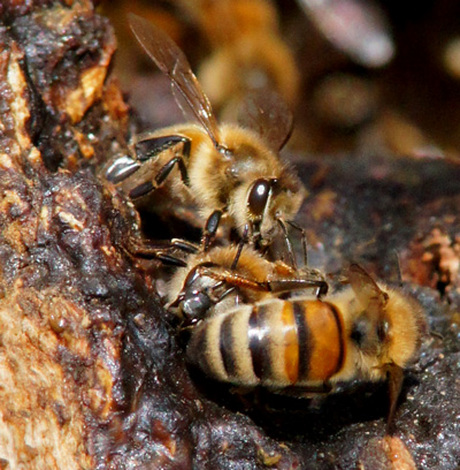
Guard bee defending the entrance to her hive from bees who don't belong to her colony.
At the entrance to the hive, I often see the "guard" bees. These are the female bees that are 18 days old. How scientists have determined this with such precision is amazing, but no more so than the fact that bees adhere to such strict schedules from one generation to the next. I wonder if it ever varies? At any rate, their sting is fully developed at this stage. The guard's job is to sniff out intruders and do whatever it takes to keep out bees who don't belong to the colony. These guard bees can literally smell if a bee is not a local resident and they will fight to the death to do their 'bouncer' job. When guard bees are 21 days old they begin to fly and leave the hive with different duties for the colony.
I love spending time with my bees.
WHAT'S ALL THE BUZZ ABOUT?
It's because they flap their wings on average 200 - 230 times per second! You may think hummingbirds flap as much or more, but you would be wrong. Depending on the species, hummingbirds hover in mid-air by flapping their wings 12–90 times per second.
Click here to read about my first day with my bees in February 2011
POLLEN GATHERERS
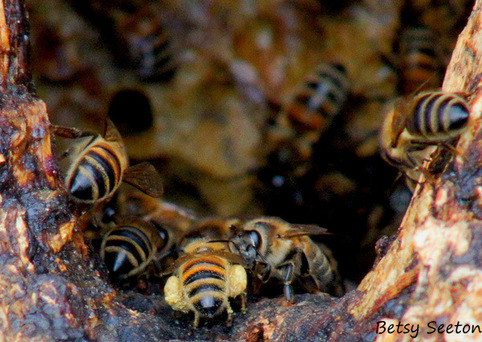
photo by Betsy Seeton
I've been watching the worker bees come and go from the hive for three months and many of them bring loads of pollen back with them. I don't know where they got all the pollen in the middle of winter. I started watching the bees in the middle of February. There were no flowers around that I could see, but they were finding pollen somewhere.
WING FLAPPERS
I've also observed them flapping their wings and wondered why. I discovered it's to keep the hive clean by circulating the air and more importantly to regulate the hive's temperature. Fanning is also used to evaporate water which aids in turning nectar into honey. I've gotten so close with the bees over the past months that I've often felt the wind from their flapping!
From what I've observed, this hive is very healthy. The worker bees are steadily bringing lots of pollen. I'll watch them land at the entrance, their hind legs full of pollen, and then they quickly waddle their way on in and down into the hive out of sight. Notice the photo below where the pollen is bright orange instead of cream colored. This means a new flower is blooming.
WING FLAPPERS
I've also observed them flapping their wings and wondered why. I discovered it's to keep the hive clean by circulating the air and more importantly to regulate the hive's temperature. Fanning is also used to evaporate water which aids in turning nectar into honey. I've gotten so close with the bees over the past months that I've often felt the wind from their flapping!
From what I've observed, this hive is very healthy. The worker bees are steadily bringing lots of pollen. I'll watch them land at the entrance, their hind legs full of pollen, and then they quickly waddle their way on in and down into the hive out of sight. Notice the photo below where the pollen is bright orange instead of cream colored. This means a new flower is blooming.
An interesting short read is DANCING BEES SPEAK IN CODE. Here's an excerpt:
"Bees outfitted with tracking devices responded to the wiggling of one of their fellow foragers, who had just returned to the hive from some newfound bee vittles.? The dance, which is performed on one of the honeycomb walls, is not an exact language, but it gets the job done.
The central element of the choreography is a shimmy, or waggle, along a straight line. For emphasis, the bee repeats this move several times by circling around in a figure-8 pattern. The angle that the shimmy makes in relation to an imaginary vertical line is the direction to the food source with respect to the sun.
For example, a waggle dance pointing towards 3 o'clock is bee talk for: "Hey, there's food 90 degrees to the right of the Sun." Read full article
"Bees outfitted with tracking devices responded to the wiggling of one of their fellow foragers, who had just returned to the hive from some newfound bee vittles.? The dance, which is performed on one of the honeycomb walls, is not an exact language, but it gets the job done.
The central element of the choreography is a shimmy, or waggle, along a straight line. For emphasis, the bee repeats this move several times by circling around in a figure-8 pattern. The angle that the shimmy makes in relation to an imaginary vertical line is the direction to the food source with respect to the sun.
For example, a waggle dance pointing towards 3 o'clock is bee talk for: "Hey, there's food 90 degrees to the right of the Sun." Read full article
"Subtle flavor and color differences in honey depend on floral varieties and local weather. In the U.S., there are over 300 sources of honey, including popular varieties like clover, alfalfa, buckwheat, and orange blossom, and regional specialties like fireweed, tupelo, and macadamia nut honey."
Source: http://ask.yahoo.com/20021203.html
Source: http://ask.yahoo.com/20021203.html
"Those who dwell among the beauties and mysteries of
the earth are never alone or weary of life."
~Rachel Carson
the earth are never alone or weary of life."
~Rachel Carson
THE QUEEN
"A two-day-old larva is selected by the workers to be reared as the queen. She will emerge from her cell 11 days later to mate in flight with approximately 18 drone (male) bees. During this mating, she receives several million sperm cells, which last her entire life span of nearly two years or longer. The queen starts to lay eggs about 10 days after mating. A productive queen can lay 3,000 eggs in a single day." source: http://www.beeman.ca/id18.html
"The queen's job is simple—laying the eggs that will spawn the hive's next generation of bees. There is usually only a single queen in a hive. If the queen dies, workers will create a new queen by feeding one of the worker females a special diet of a food called "royal jelly." This elixir enables the worker to develop into a fertile queen. Queens also regulate the hive's activities by producing chemicals that guide the behavior of the other bees.
Male bees are called drones—the third class of honeybee. Several hundred drones live in each hive during the spring and summer, but they are expelled for the winter months when the hive goes into a lean survival mode.
Bees live on stored honey and pollen all winter, and cluster into a ball to conserve warmth. Larvae are fed from the stores during this season and, by spring, the hive is swarming with a new generation of bees." Source: National Geographic
"A two-day-old larva is selected by the workers to be reared as the queen. She will emerge from her cell 11 days later to mate in flight with approximately 18 drone (male) bees. During this mating, she receives several million sperm cells, which last her entire life span of nearly two years or longer. The queen starts to lay eggs about 10 days after mating. A productive queen can lay 3,000 eggs in a single day." source: http://www.beeman.ca/id18.html
"The queen's job is simple—laying the eggs that will spawn the hive's next generation of bees. There is usually only a single queen in a hive. If the queen dies, workers will create a new queen by feeding one of the worker females a special diet of a food called "royal jelly." This elixir enables the worker to develop into a fertile queen. Queens also regulate the hive's activities by producing chemicals that guide the behavior of the other bees.
Male bees are called drones—the third class of honeybee. Several hundred drones live in each hive during the spring and summer, but they are expelled for the winter months when the hive goes into a lean survival mode.
Bees live on stored honey and pollen all winter, and cluster into a ball to conserve warmth. Larvae are fed from the stores during this season and, by spring, the hive is swarming with a new generation of bees." Source: National Geographic
"In cold climates honeybees stop flying when the temperature drops below about 50 degrees F and crowd into the central area of the hive to form a "winter cluster." The worker bees huddle around the queen bee at the center of the cluster, shivering in order to keep the center between 80 F at the start of winter (during the broodless period) and 93 F once the queen resumes laying. The worker bees rotate through the cluster from the outside to the inside so that no bee gets too cold. The outside edges of the cluster stay at about 46-48 degrees. The colder the weather is outside, the more compact the cluster becomes. During winter, they consume their stored honey to produce body heat. The amount of honey consumed during the winter is a function of winter length and severity but ranges in temperate climates from 30 to 100 lbs.[10]" SOURCE: WIKIPEDIA
Swarming is the natural means of reproduction of honey bee colonies. A new honey bee colony is formed when the queen bee leaves the colony with a large group of worker bees, a process called swarming. In the prime swarm, about 60% of the worker bees leave the original hive location with the old queen. This swarm can contain thousands to tens of thousands of bees. Swarming is mainly a spring phenomenon, usually within a two- or three-week period depending on the locale, but occasional swarms can happen throughout the producing season.
Secondary afterswarms may happen but are rare. Afterswarms are usually smaller and are accompanied by one or more virgin queens. Sometimes abeehive will swarm in succession until it is almost totally depleted of workers. Source: wikipedia
Secondary afterswarms may happen but are rare. Afterswarms are usually smaller and are accompanied by one or more virgin queens. Sometimes abeehive will swarm in succession until it is almost totally depleted of workers. Source: wikipedia
by Marion Ellis, Extension Apiculture Specialist
Source: http://entomology.unl.edu/beekpg/beeswarm.shtml
1. What is a honey bee swarm?
Honey bee swarms are a favorite topic of people who make horror movies. Actually, they are one of the most beautiful and interesting phenomena in nature. A swarm starting to issue is a thrilling sight. A swarm may contain from 1,500 to 30,000 bees including, workers, drones, and a queen. Swarming is an instinctive part of the annual life cycle of a honey bee colony. It provides a mechanism for the colony to reproduce itself.
2. What makes a honey bee colony swarm?
Overcrowding and congestion in the nest are factors which predispose colonies to swarm. The presence of an old queen and a mild winter also contribute to the development of the swarming impulse. Swarming can be controlled by a skilled beekeeper; however, not all colonies live in hives and have a human caretaker.
3. When do honey bees swarm?
The tendency to swarm is usually greatest when bees increase their population rapidly in late spring and early summer. In Nebraska, this would be in May and June. READ 4 THROUGH 9 HERE
Source: http://entomology.unl.edu/beekpg/beeswarm.shtml
1. What is a honey bee swarm?
Honey bee swarms are a favorite topic of people who make horror movies. Actually, they are one of the most beautiful and interesting phenomena in nature. A swarm starting to issue is a thrilling sight. A swarm may contain from 1,500 to 30,000 bees including, workers, drones, and a queen. Swarming is an instinctive part of the annual life cycle of a honey bee colony. It provides a mechanism for the colony to reproduce itself.
2. What makes a honey bee colony swarm?
Overcrowding and congestion in the nest are factors which predispose colonies to swarm. The presence of an old queen and a mild winter also contribute to the development of the swarming impulse. Swarming can be controlled by a skilled beekeeper; however, not all colonies live in hives and have a human caretaker.
3. When do honey bees swarm?
The tendency to swarm is usually greatest when bees increase their population rapidly in late spring and early summer. In Nebraska, this would be in May and June. READ 4 THROUGH 9 HERE
PROPOLIS
Back in February and early March, I gave some sugar water to the bees a few times since I knew food might not be easy to get in the winter especially when it was cold and wet. I also brought them flowers one day thinking they'd love them, but they preferred the dead leaves and old wood! It confused me. I thought they'd smell the roses and the very fragrant hyacinths and swarm around them. But not one bee showed an interested in them nor did one even land on them. I wondered if they preferred different flowers?
Back in February and early March, I gave some sugar water to the bees a few times since I knew food might not be easy to get in the winter especially when it was cold and wet. I also brought them flowers one day thinking they'd love them, but they preferred the dead leaves and old wood! It confused me. I thought they'd smell the roses and the very fragrant hyacinths and swarm around them. But not one bee showed an interested in them nor did one even land on them. I wondered if they preferred different flowers?
I did some research and I think I solved this little mystery. Maybe their job wasn't to gather pollen, maybe it was to collect propolis, a resinous, sticky substance in tree bark used as glue to bind the nest together and seal up holes and gaps. It's also used as an antiseptic when lining the cells to protect from molds and infections. I often see these bees using their red, tube like tongues inserted into pieces of bark and wondered what they were doing. Propolis is also used to "mummify dead intruders such as mice which are too big to be removed from the hive." (Source: Keeping Bees and Making Honey by Alison Benjamin and Brian McCallum)
After browsing through all these bee photos come back and click to read my "Bee Story" about a bee that became my Nepali interpreter. True story!
Communing with nature is such a part of me. I never tire of it in much the same way I never tire of seeing a sunrise or sunset. It's just one of those things that has no expiration date or a "done that, been there" sort of feeling. No matter how many times I see birds and wildlife, it makes me feel excited like the way I used to feel when I was a little kid. It's as close to feeling something magical that I get to experience every single day. And I don't have to spend a dime! How sweet is that?!
RESCUING THE SWARM
FOLLOW THE QUEEN
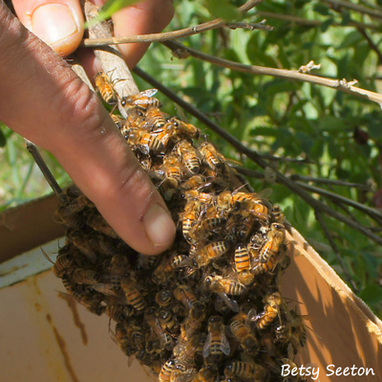
The beekeeper, Matt Ketner, pointed out the queen bee. I'd seen her when the swarm was first forming. Wherever the queen goes, the worker bees will follow. Matt put the branch of bees in the box and then put the box on it's side to let the other bees crawl in on their own, which they began to immediately do.
TRYING TO GET AS MANY BEES AS HE COULD
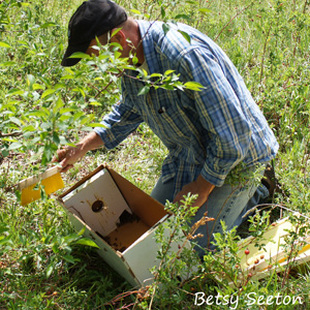
Some of the bees were so exhausted from little food and all the energy expended to keep warm that they couldn't even walk into the box. They were scattered around the ground so Matt gently tried sweeping them up, but he had another job to go to, so some bees were left behind.
A CUP OF BEES
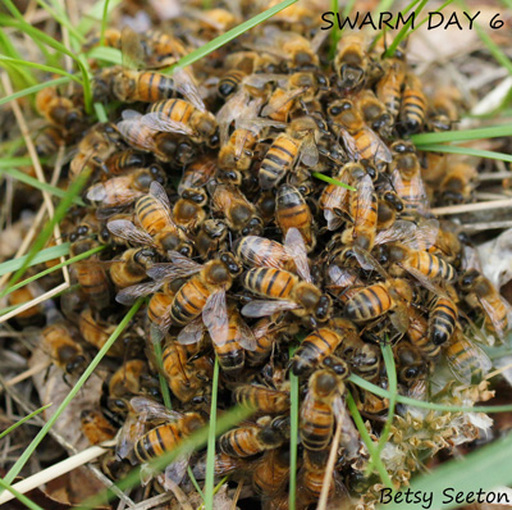
The day after Matt collected the swarm, I went back to see if any of the bees left behind were still alive. I'd read that swarms can only last 4 days without getting to their new home. This was Day 6. I wondered if I could return them to their home colony located in a nearby tree, but the hive entrance was 15 feet up a tree and I couldn't reach it without a ladder.
When I got to the bees, I found they had huddled together into another small heap, and I was surprised that many of them were still alive. I just couldn't leave them to die. I retrieved a coffee cup out of a garbage can (the same cup I'd picked up off the ground the day before that was just left as trash by an uncaring park patron) and gently scooped up the bees with my hands and moved them into the cup. When I got them all safely inside, I called Matt. Thankfully, he was at home. The rain was just beginning to fall again. I asked if I could bring him a "cup of bees" to add to the hive. He said yes.
When I got to the bees, I found they had huddled together into another small heap, and I was surprised that many of them were still alive. I just couldn't leave them to die. I retrieved a coffee cup out of a garbage can (the same cup I'd picked up off the ground the day before that was just left as trash by an uncaring park patron) and gently scooped up the bees with my hands and moved them into the cup. When I got them all safely inside, I called Matt. Thankfully, he was at home. The rain was just beginning to fall again. I asked if I could bring him a "cup of bees" to add to the hive. He said yes.
I dropped the cup of bees with Matt and picked up one of his $10 jars of honey. Later in the day I discovered one bee left over in my car. I felt sorry that she didn't get to go with her family. I was with my daughter running errands when I found the bee walking along my door. My daughter is adopting my love of bees and asked if there was a way she could take the bee home and wondered what she could feed it.
My daughter has always been one of the most compassionate people I've ever met. She would do anything (good and loving) for a friend and has been an animal lover from the time she was very little. When I taught her to fly fish and she caught her first trout she was so excited. She came running up from the pond below our cabin with the fish cradled in both her small arms asking for a bowl of water to put him in. When I explained that he was for dinner, she was aghast! All she wanted was to have him as a pet. She never fished after that. At the age of 9 she became a vegetarian. But that's another story for another time. This is my bee story.
So, back to the lone bee in my car. I was going to let the bee out but the last time I saw her she was on the back seat. I couldn't find her after that. I like to imagine she flew away and found her way home.
My daughter has always been one of the most compassionate people I've ever met. She would do anything (good and loving) for a friend and has been an animal lover from the time she was very little. When I taught her to fly fish and she caught her first trout she was so excited. She came running up from the pond below our cabin with the fish cradled in both her small arms asking for a bowl of water to put him in. When I explained that he was for dinner, she was aghast! All she wanted was to have him as a pet. She never fished after that. At the age of 9 she became a vegetarian. But that's another story for another time. This is my bee story.
So, back to the lone bee in my car. I was going to let the bee out but the last time I saw her she was on the back seat. I couldn't find her after that. I like to imagine she flew away and found her way home.
Go to motherearthnews.com/search.aspx?search=bee keeping for an archive of beekeeping articles from Mother Earth News.
May 27, 2011
A lot of bees are dead and piling up around the base of the tree below the beehive. There are also dead bees floating in the water near the shore line. I often rescue the bees from drowning on the days I visit the hive. I've noticed that the bees that look dead, like they've been 'floaters' for quite some time, begin to revive once they're out of the water. They often begin to move a leg here or there, and eventually try to stand and then walk. The bee shown above and below was one such rescued bee who revived against all odds. She fell off the wood, so I put her in my hand. I think she liked the warmth better than the wet wood.
A lot of bees are dead and piling up around the base of the tree below the beehive. There are also dead bees floating in the water near the shore line. I often rescue the bees from drowning on the days I visit the hive. I've noticed that the bees that look dead, like they've been 'floaters' for quite some time, begin to revive once they're out of the water. They often begin to move a leg here or there, and eventually try to stand and then walk. The bee shown above and below was one such rescued bee who revived against all odds. She fell off the wood, so I put her in my hand. I think she liked the warmth better than the wet wood.

